



This is a collection of artworks, texts and resources about freedom and openness in the arts, in the age of the Internet. Freedom to collaborate – to use, modify and redistribute ideas, artworks, experiences, media and tools. Openness to the ideas and contributions of others, and new ways of organising and making decisions together. This collection is intended to inspire, inform and enable people to apply peer-to-peer principles for making things and getting organised together. We hope that all art lovers, makers, thinkers, organisers and strategists will find something for them from this set of imaginative, communitarian and dynamic contemporary practices.
Commissioned and hosted by Arts Council England 2011
Face to facebook is the final project in a three part series named “Tha Hacking Monopolism Triology” by the two Italian artists Paolo Cirio and Alessandro Ludovico. It was launched on the 2nd February 2011, with a mixed media installation at the Transmediale festival in Berlin, and a press release announcing a new dating website called lovely-faces.com.
The set-up for the ‘Face to facebook’ project was to steal 1 million facebook profiles and re-contextualize them on a custom made dating website (lovely-faces.com). The data collected from the profiles was only information available publicly on the internet, like the users name and profile picture. No facebook account was needed to access it. The 1 million facebook profile pictures were then checked for images that were usable in a dating webstie context. The remaining 250,000 profile pictures were then fed through various face recognition filters to assign an assumed personality to the subjects and a new profile was created ready for the dating website. Once published on lovely-faces.com, interested pursuers could get in contact with the people behind the original facebook profiles through facebook messages.

On the 10th February, 8 days after its launch, the dating website lovely-faces.com was shut down. This was following a cease and decease letter from Facebook[1]. Back in 1999, the net artist Heath Bunting was also subject to a cease and decease letter, that time from American Express. The letter sent to Paolo Cirio and Alessandro Ludovico in 2011 (as PDF) can be seen here, and the letter sent to Heath Bunting in 1999 is published here.
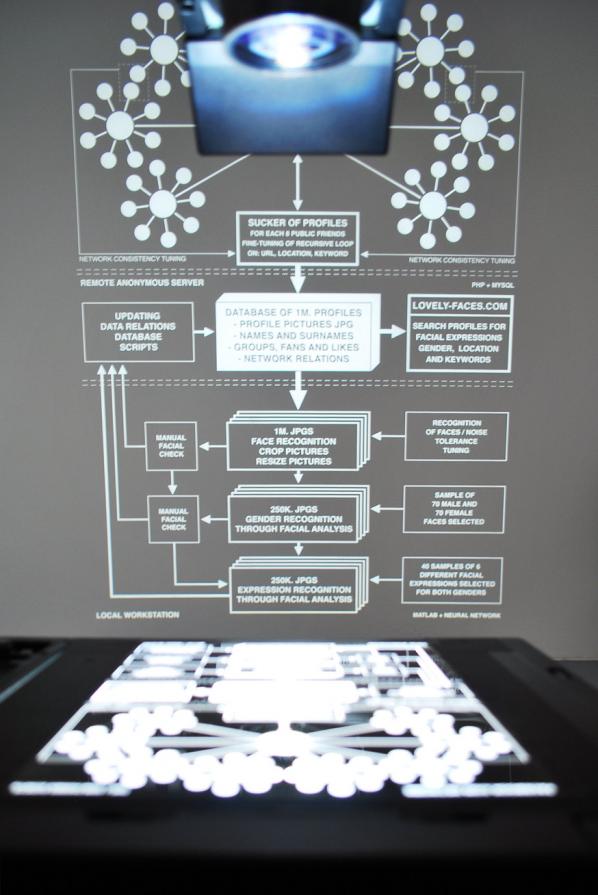
This project, and the ripples it left on the media water, highlights an ambiguous relationship many have with facebook. Many people sign up, upload a smiling profile picture of themselves and declare personal details to the large corporation that is Facebook without concern. Not until these identities and personal images were scavenged and then reused, the ownership and potential audience of this personal data is questioned. As the artists state themselves: “The final step is to be aware that almost everything posted online can have a different life if simply recontextualized. “
“The process is always illustrated in a diagram that shows the main directions and processes under which the software has been developed. We found a significant conceptual hole in all of these corporate systems and we used it to expose the fragility of their omnipotent commercial and marketing strategies. In fact all these corporations established a monopoly in their respective sectors (Google, search engine; Amazon, book selling; Facebook, social media), but despite that their self-protective strategies are not infallible. And we have been successful in demonstrating this.”
Web 2.0 Suicide machine (http://suicidemachine.org/) is another project which deals with your online identity. It allows you to automatically delete all your social network profiles and it simplifies the process – according to their website 8.5h quick then a manual deletion. Incidentially, the facebook is not one of the profiles subject to deletion in the suicide machine anymore, following another cease and decease letter: http://suicidemachine.org/download/Web_2.0_Suicide_Machine.pdf.
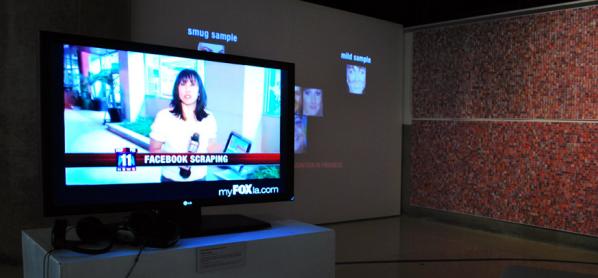
Since the lovely-faces.com dating website is still closed down, the project now (September 2011) consists of: documentation of the process used to acquire the facebook profiles; documentation of the global mass media hack performance, in the form of news broadcasts, magazine articles and blog post referring to the project; legal correspondence between the lawyers of the artists and Facebook; a mixed media installation; a touring lecture given by the authors. The latter two being re-performed and installed in various venues around Europe and beyond. The former are all available on the website face-to-facebook.net
The ever changing nature of this project therefore makes it a great example of a piece of contemporary art of variable nature, one which is in constant flux and is formed by the cultural, networked and physical landscape surrounding it. It does not only challenge the ownership of your online identity, it is also a nuisance for a mainstream contemporary art market based on institutional preservation and commercial commodification. These disruptions may also be linked. On the one hand there is an action to copy a system collecting and commodfying people and then use them as assets in one’s art expression and experience. “In all the three projects, the theft is not used to generate money at all, or for personal economic advantage, but only to twist the stolen data or knowledge against the respective corporations.” And then on the other hand, it is an art project which is not straightforward to see what the remaining artefacts actually are, whilst defying the process of being added to traditional art collections.
Other Info:
The Hacking Monopolism Trilogy. Face to Facebook is the third work in a series that began with Google Will Eat Itself and Amazon Noir. http://www.face-to-facebook.net/hacking-monopolism-trilogy.php
Elin Ahlberg is studying Art and Visual culture at the University of the West of England in Bristol. She has been living in the UK, and Bristol, since her move from Sweden in 2006. As an artist, she works in a variety of mediums and produces work which aims to both amuse and provoke. Her practice and research is informed by quasi-anthropological observations and an interest in technology. “One year ago I gave up Facebook for lent. It was quite an interesting experiment and I realised how integrated my life was with the social networking website as I actually felt that I missed out on things.” Ahlberg’s essay Meanings constructed around Facebook can be found here http://elinahlberg.wordpress.com/2011/07/18/essay-meanings-constructed-around-facebook-2011/
Emilie Giles interviews artist Mary Flanagan about Tiltfactor’s latest social game, Pox: Save the People. http://www.tiltfactor.org/pox
Emilie Giles: Can you give an introduction to POX: Save the People, and why Tiltfactor was keen to produce a game which explored issues around immunisation?
Mary Flanagan: POX: Save the People is a 1-4 player board game that takes on the public health issue of disease spread. We developed the game after wishing to pursue some public health issues and having prototypes games on cholera and HIV awareness at the lab. A local, and quite open, public health group called Mascoma Valley Health Initiative up in the New Hampshire region of the US approached us with the problem of the lack of immunization. At first, a game about getting people immunized seemed like one of the most “un-fun” concepts imaginable. But that sinking feeling of impossibility almost always leads to good ideas later, so I agreed to take the project on. We decided we could make something fun from the topic, and ruled out nothing, from crazed needles to taking the point of view of the disease whose main purpose in life is to spread around.
In our final version of the game, the board is modeled after a community, with the spaces representing people. The game begins with two people being infected with an unnamed disease, and the illness speads. Players try to contain the disease and save lives. There are vulnerable people among the population noted in yellow, and these people — pregnant women, young babies, and those in frail health — cannot be vaccinated.
EG: Schools have the option to download a sample lesson plan which incorporates the game into a science class. Please explain how you feel play can encourage learning in an educational environment.
MF: Play is one of the best ways to learn something — certainly tried and true classrooms such as Montessori method schools use play as a part of the curriculum. In the best scenario, play provides experiment space, where failure is ok. In games related to pedagogy, players can test the rules of the system at hand. POX players, for example, can try to cure all of the people on the board to test if this is a good strategy. They can test out best ways to avoid the spread of a disease. Ultimately, they get to make the meaningful choices from within the game rules. Playing POX while learning about real world diseases makes the phenomena more concrete, and gives the learner agency to think about what he or she might do to solve the problem.
The lesson plan for schools was edited by both trained teachers in US middle schools as well as doctors at Dartmouth’s medical school. Truly, then, the game is produced by a community. We could not have created the game to this level of quality without our partners, friends, and supporters.
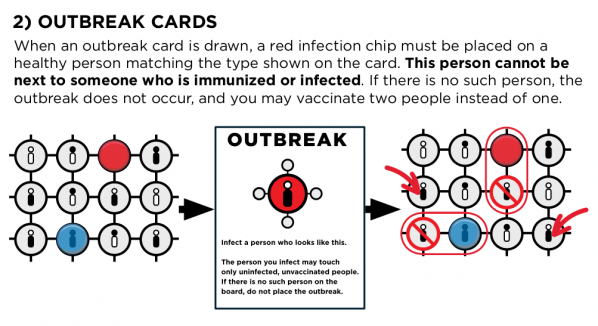
EG: In most games, a competitive element is introduced to result in a ‘winner’ and ‘loser’. POX deliberately avoids this convention, encouraging players to work together in order to stop the virus. Why was the game designed for this mode of play?
MF: One of the ethos of Tiltfactor games is cooperative play. We like to make games in which players can use collaborative strategy. We define collaborative strategy games as those in which:
1. Games (or in some situations, components of games) where if one player reaches the lose state, everyone playing also loses;
2. The extent to which players win is positively correlated to the success of other players.
Often the most interesting games do not fit comfortably into stereotypical models of play. And because we make games about less traditional topics — public health, layoffs, GMO crops, and other political and social challenges –it is important that the game model itself reflect that. In educational scenarios or in community development, games mirror more closely the ways in which people work together to solve problems. So, the reason that POX is a cooperative game are deeply set in the lab ethos towards problem solving — we can only solve problems together.
EG: You are working on a digital version of the game for the iPad. What was your rational for approaching the topic through both a digital and physical platform and do you think these result in a different type of engagement?
MF: Yes — we’re also creating an iPad version and have an online version to launch as well. It is fascinating to make multiplatform games like this– we are a small lab so we’re doing most everything ourselves, including packaging, promotion, and research.
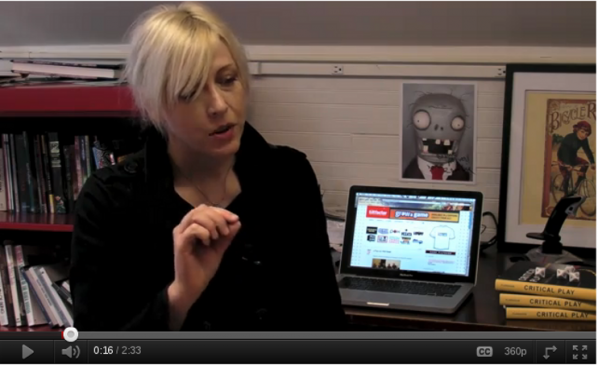
The differences between the platforms for the game are so dramatic, we’ve decided to conduct a study with the same game and different platforms, because watching people play the same game, the same rules, on a different platform clearly results in an different play experience. It is clear to me that very different things are going on, and I want to back up claims with data. For example, players play much faster if the game is computer based via an online game or the iPad. Players seem to like pressing buttons fast. In the board game, for example, observation shows us that players pick up pieces and discuss the moves with the other players, considering this option and that. The game piece actually becomes a kind of thinking object, I don’t know for sure, but it is very different. The speed up in time with a computer-based game appears to cut down conversation and meaningful dialogue that we’ve recorded in our last study on the board game. So, this is something that as games makers we’d really like to understand better, and share with others.
As an artist, I’m known to make media art and works that engage with play and game culture. In the laboratory context, I love developing and researching games with my team. I have amazing people to work with: Sukdith Punjasthitkul is my project manager who has a background in underground Asian culture, public health, and tennis; Zara Downs is a graphic designer and rural hipster who loves biology; Max Seidman is my accomplished undergraduate engineering student who has racked up several games in his time at the lab, and he loves wearing vests. Matt Cloyd is working with me, a recent graduate who is involved in sustainability issues in communities. Erika Murillo is a new student team member obsessed with social issues and animation. The list goes on. Part of the mission of what we do is to help the next generation who care about social issues have the tools to push what we do now, further.
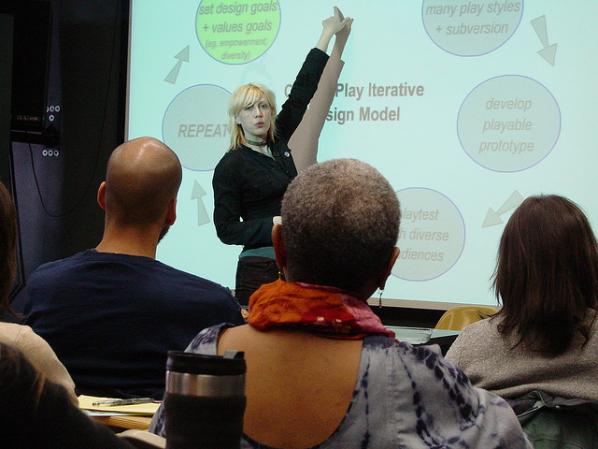
EG: Your point about how you’ve found players to engage more in dialogue when involved in a board game is very interesting. Non digital games such as board games and pervasive urban games have become more popular over the past few years; do you think players are desiring a more socially interactive experience?
MF: Board games are enjoying a renaissance, it is true. First, because I think people really like playing together in a physical space. Perhaps the new technologies — Wii and Kinect — remind people of that. Perhaps they played recently at a family gathering and remembered how much fun they are. It is impossible to say. Second, there are some really well-designed games out there right now, and available in many countries (in part, due to online purchase power), that are certainly worth playing. People do really like playing with each other in physical space, and they still enjoy watching sports in person. Technology can help facilitate this as with mobile games and pervasive games, but it is not a requirement for a good game. I think different kinds of conversations may happen over board games as compared to digital games, but this is something that needs some data behind it. So, we’ll be doing a study on these nuances in my lab very soon.
EG: Looking at Huizinga’s idea of ‘the magic circle’, there is a clear boundary between play and non-play. What were the challenges in designing a game which straddles this boundary, on one hand trying to entice participants through play and interaction, and on the other attempting to create real life social change?
MF: Emilie, this is the riding question for all of game design engaged with social issues, and behind all of the debates on how gamification can incite real behavioural and social change. You’ve hit the nail on the head! There are many forms of play, some which stay within the game in a nice neat package, like our board game, and some that bleed over into real life, such as ARGs. But one should not be fooled into thinking that this means that the former is useless for education and social change, and the latter is obviously better at it. We are about to release our pilot study on the learning in the game, and the results are surprising, showing that learning transfers out of the game as players can apply concepts in the game to new topics. We’re careful researchers. As artists, and as people critical of flippant comments about games and change, we don’t take research lightly. We don’t, for example, cite major gains on attitudinal change and make assumptions on long term behavioural change from a 40-minute game play session. That would be bad science. So we scale our questions accordingly, and in fact, are still surprised and pleased by the effect the game has. I’ll update you on the specifics when the paper is published this autumn!
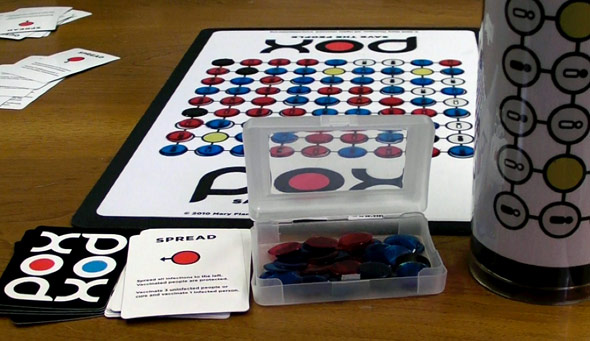
The deeper issues on the limits of how games can incentivise real behavioural and social change can get rather dark. How Pavlovian do we want to be in influencing people? Even those in social change arenas have to pause and think. Education and influence for good is what we strive for. Designers and companies can only go so far before we have something much more sinister at hand. This is why our team’s work on the Values at Play project (http://www.valuesatplay.org) remains relevant.
The Philosophy Of Software
Code and Mediation in the Digital Age
David M Berry
Palgrave Macmillan, 2011
ISBN 9780230244184
http://lab.softwarestudies.com/2011/04/new-book-philosophy-of-software-code.html
“The Philosophy Of Software” is an ambitious book by David Berry, who has turned his attention from the social relations and ideology of software (in “Rip, Mix, Burn”, 2008) to the question of what software means in itself. The philosophy that he has in mind isn’t the mindless political libertarianism attributed to hackers or the twentieth-century foundational mathematics that is the basis for the structure of many programming languages. It is a serious and literate philosophical reading of software and its production.
Software is an important feature of contemporary society that is rarely considered as a phenomena in its own right by philosophers. Software permeates contemporary society, Berry gives the examples of Google’s profits and the “financialisation” of the economy through software as examples of software’s importance in this respect. In reading this review on a screen you have used maybe a dozen computers, each containing multiple programs and libraries of software directly involved in serving up this page. Digital art and cyberculture often use and discuss software and philosophy (or at least Theory), but usually to illustrate a point about something other than software. The software itself is rarely the subject.
Rather than devote each chapter to a different philosopher’s views on software or adopting a pre-existing description of software Berry develops a novel and insightful philosophical approach to understanding and considering software. After providing an introduction to the foundational ideas and culture of software (Turing, Manovich, Cyberpunk), Berry presents a way of thinking through different aspect of software. The source code, the comments, the compiled program. Each stage and product of the lifecycle of software is given a philosophical context.
Heidegger emerges as the philosopher whose ideas first underwrite Berry’s approach to software. Latour and, in a surprising way, Lyotard play pivotal roles in later chapters. If these are not philosophers you were well inclined towards before then you are in for a pleasant surprise.
Berry presents some typographically appealing and culturally interesting code in order to demonstrate different features of the production of software. The swearing placed in Microsoft’s Windows source code comments by its programmers will mirror the frustration of many of its users. The Diebold voting machine code that illustrates the assumed social and gender roles of its human subjects show that code is very much a product of the social biases of its human authors.
Much of the code illustrated in the book is code poetry or obfuscated code. These are double-coded programs, where source code that can be run by a computer is written and formatted to be not just understandable but evocative and meaningful to human readers as something read rather than run. As with the comments in the Windows and Diebold code, a criticism that might be levelled at such code is that such textual decoration does not affect the compiled (or executed) form of the code.
But comments and formatting are what Berry refers to as commentary code and delegated code in his grammar of code. It has been said that code is written primarily for human beings to read and only secondarily for computers to execute, and obfuscated or poetic code is regarded as high art by many programmers. It must exemplify some of code’s salient features to them, and so it can be used to do so to a more general audience. And the cultural assumptions of code can survive from its source code into its execution and interface: witness the relief of many of Diaspora’s users than “Gender” was a free-form text field rather than a simple binary choice of “Male” or “Female”.
The final chapter on network streams provides a strong critical philosophy of social networking and other software that reduces human experience to a stream of software representations of events. After discussing what it means for a human being to be a “good stream”, Husserl’s idea of “comets” as a precedent for lifestreams and Lyotard’s idea of the stream (both of which predate the streams of the Internet by many years), Berry presents the idea of Dark Streams as a way of resisting the demands of Web 2.0. I would single this out as the most timely and invigoration section of the book and a must-read for anyone involved in producing, consuming, or critiquing networked software culture.
What doesn’t the book cover? There is no visual coding or livecoding. Berry explicitly avoids “screen essentialism”, where the output of code is concentrated on to the exclusion of its production and execution, but despite following programs from their writing through compilation to first assembly code then machine language, running software and algorithms (at the micro level) are not considered, nor (at the macro level) are the architectures of applications or of operating systems. Nor is testing except in passing. But this fits with the emphasis of the book on code as text, and the framework that it provides can be extended to these topics. Hopefully by Berry.
“The Philosophy Of Software” is particularly inspiring as a spur to further research. Each page is brimming with references in the style of the academic papers that many of the chapters were first produced as and whilst this style can be distracting at first (compared with popular science books for example) it is ultimately rewarding and gives the reader any number of fascinating leads to follow up.
What is important about “The Philosophy Of Software” is that it really is about what it claims to be about. Rather than trying to shoehorn software into an existing philosophical or political agenda it considers software as a thing in itself and finds those philosophers and philosophical ideas that best address the vitally important phenomenon of software. However much philosophy, computer science or cybercultural theory you may know this is a book that will set you thinking about software anew.
The text of this review is licenced under the Creative Commons BY-SA 3.0 Licence.
Featured image: Installation Speed. Public Space Exhibition Plattform Bohnenstrasse in Bremen September 2006. Aram Bartholl.
Pole Position, Outrun, F1 Racer and Need for Speed are some of the countless racing games that have attracted artists to explore a world of speed and burning rubber. In 2004 Cory Arcangel hacked the old Japanese Famicom driving game F1 Racer and removed, in the same way as he did in Super Mario Clouds, cars and other objects so that the only thing that remained of the game was the road and the landscape rushing toward the viewer.
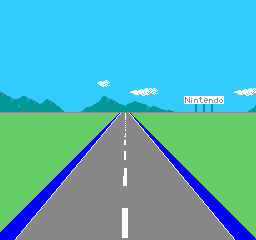
Hacking and modifying videogames is one artistic approach, another approach in Game Art is to transfer virtual objects into real objects. The Swedish artists Simon Goldin and Jakob Senneby in an exhibition called Objects of virtual desire (2005), introduced virtual objects from players in Second Life. The object was then reproduced as physical art as limited edition in an exhibition, exploring immaterial production in a virtual world and how this can be transferred into an economy of material production. “Objects of Virtual Desire exploits the augmented value of immaterial objects to create and market tangible products, thereby reversing the process and highlighting the materiality of the immaterial.” Goldin & Senneby.
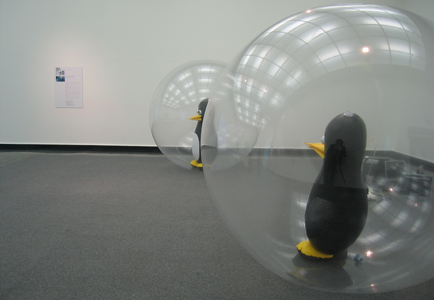
In a similar way both Aram Bartholl and Brody Condon have used virtual objects from Speed racing games. In Speed (2006) Bartholl made a 1:1 scale sign with red flashing arrows and placed the sign at a street in Bohnenstrasse in Bremen. The model to the arrows had he found in the game Need for Speed Underground NFSU where the red blinking signs leads the player on the right track. Condon on the other hand made an exact replica of a Lamborghini Countach from 1985, a model that he found in the game Need for Speed. The big different was that the car was made of plastic branches and there was only the outline of a car, in a 3D program you would say it was the wireframe of a car. What Bartholl and Condons does is that they investigates and problematizes the borderline between the virtual world and the reality by moving virtual and real objects between these two worlds. Worlds that today are more and more integrated and harder to distinguish.
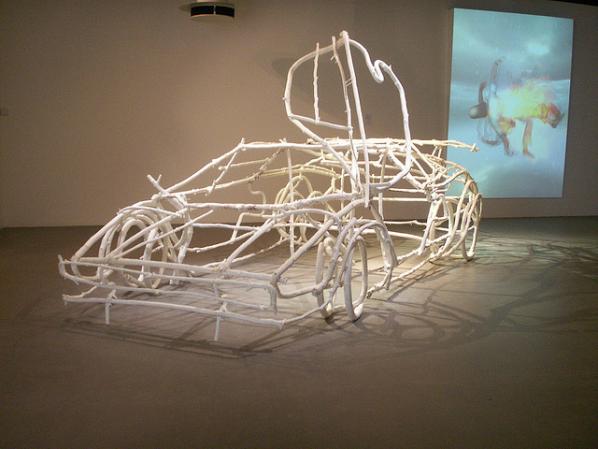
The Dutch artists Marieke Verbiesen is also mixing elements from the virtual and real world in her work Pole Positon. Pole position was a racing game released in 1982 by Namco and was one of the first games to use the rear-view racer format, where the player’s view is behind and above the vehicle. In her installation the background in the game created by a realtime recording of a miniature landscape in perspective. Visitors can interfere in the landscape and be a part of the game by passing by the camera filming the landscape.
The ultimate combination of real and virtual game play is found in Garnet Hertzs work OutRun. Outrun was a game that was created by Sega 1986. Some arcade versions of the game were presented in a red sit down cabinet that looked like a car. Garnet Hertz has used this cabinet version as a model for his work and made a red real car where the front window is replaced with an aracde cabinet. With help of augmented reality the road ahead of you is an 8-bit video game, so at the same time you are playing the game you are driving down the road.
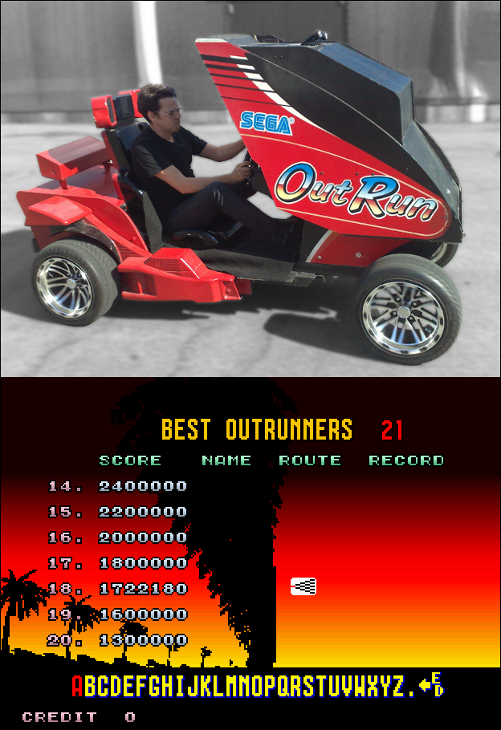
OutRun – Garnet Hertz. Images/video: http://www.conceptlab.com/outrun
“where game simulations strive to be increasingly realistic (usually focused on graphics), this system pursues “real” driving through the game. Additionally, playing off the game-like experience one can have driving with an automobile navigation system, OutRun explores the consequences of using only a computer model of the world as a navigation tool for driving.” Hertz
One thing that you could not blame racing games for is air pollution. In the installation “Colorless, odorless and tasteless” from 2011 this is exactly what you can blame Eva and Franco Mattes for.
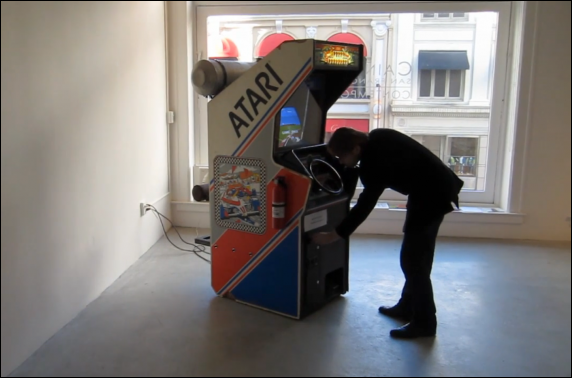
They modified an old Pole Position game and installed a real engine in the arcade cabinet. When the player is driving the virtual car on the screen the room is filled with carbon monoxide from the real engine. So the risk is not only that you run out of coins but you are also gassed.
More of Mathias’s reviews on Furtherfield & bio : http://www.furtherfield.org/user/mathias-jansson
Featured image: Remixthebook Cover
“For us, art is not an end in itself … but it is an
opportunity for the true perception and criticism
of the times we live in.” Hugo Ball.
The challenge in trying to review a book like Mark Amerika’s Remixthebook, is the feeling you can only do justice to the text by doing the same with your review. The apparent simplicity coupled with the multifarious outcomes are intoxicating. You could be mistaken for believing that every possible remix would produce fresh and exciting outcomes. The key of course, is to have good source material in the first place. Also, to have developed a keen eye for what blends and meshes together and what doesn’t. Even the most disparate work requires judgment and prior awareness. Remixthebook asks us to consider the idea of remixology as part of the work of modern artists. The tone and style of the book is a blend of ideas, voices and thoughts with a myriad of concepts, which attempts be the very embodiment of the ideas it espouses.
Amerika explores various precedents for the remixological concept and draws on some known practitioners from the past: amongst them, Allen Ginsberg, William S. Burroughs and Brion Gysin. He explores existing ideas and welds them into his own armoury. Their ideas considered as part of his own creative practice, brought back to the now with new life, in our contemporary networked culture.
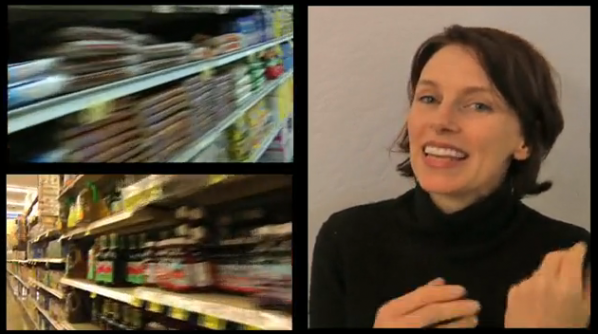
Other than just being a systematic breakdown of the different types of remixing and their potential outputs (or artifacts, as they might be better known in an art critical framework?) Amerika considers the pathways and theoretical underpinnings of remix culture. Having taken this beyond his own practice of the written word and web-based projects, he considers his recent and ongoing VJ work. Blending and collage-making with images during live music performances suggests some of the instinctive, instantaneous ideas that come out of a lifetime’s collecting, collating and absorbing of diverse imagery, words and cultural concepts. It’s within this process that he believes more novel outcomes can arise, against the constant flux of media creation and dissemination. It is the ‘becoming’ of the media artist that is revealed in the live remixing performance.
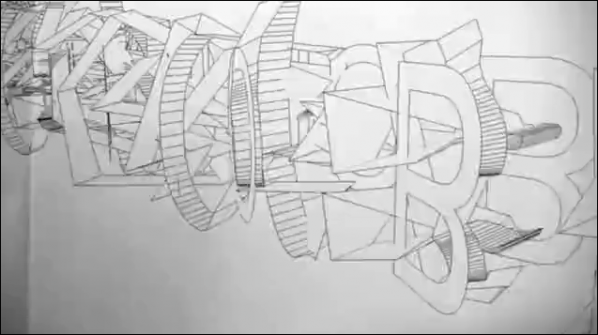
Reflecting on this process of cultural assimilation Mark Amerika, situates remixology within a wider creative output and theoretical framework. This involves a cross hybrid of everyday, mainstream references with high art and ‘high’ theory, all written in his at once complex and convoluted, yet easily read and enjoyable writing style. But like remixology, what looks simple is the result of deep reading and heavy conceptual thinking. This isn’t to say that you won’t have trouble decoding the writing and getting to the heart of his thinking, but it helps if you spend time with the text and allow the rhythms and structures to become second nature to you. Close reading allows the text to fall into place. For example, consider the following extract from the section eros intensification:
Here is where we enter the realm of
what I have been calling intersubjective jamming
which is different than the idea of a Networked Author
or Collaborative Groupthink Mentality that preys
on the lifestyles of the Source Material Rich
and seemingly forever Almost Famous.
It is worth remembering that Mark Amerika is a creative writer first and foremost. He uses theory as a palette from which to draw out ideas and situations for further reflection and to help give some context to the point he is trying to make. The text of remixthebook is an example of his creative practice in action, as much as it is a personal reflection on his attempts to develop a thought process for it. Theory becomes entwined in critical reflection and creative output. You don’t necessarily come to remixthebook for philosophical answers and hard academic points of view, instead you ride the maelstrom of thoughts and conceptualizing to gain a better handle on a way of considering artistic practice.
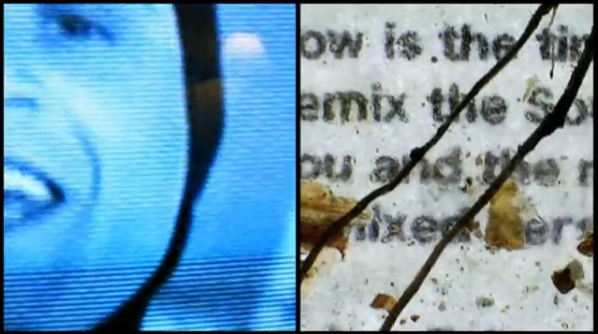
The website of the book (probably a ubiquitous extra for any media art-related publication these days) follows a natural path of inclusion and invites artists to take sections of the book and remix them according to their own aesthetic and remixological preferences. While some of the work brings in extra visuals and places itself in a flowing context of media streams, allowing different work to become part of the project, Rick Silva’s The Isarithm sources Amerika’s Sentences on Remixology 1.0 and explodes them out of the screen and into a layered and playful vortex of shapes and lines.
Will Leurs uses some captured footage taken directly off the tv screen for A Pixel and Glitch Hotel Room and combines it with some source material supplied by Amerika from several ‘lectures’ he has supplied. These lectures appear within several other contributors work as well. The point of some of these remixes and the varied forms they take (the collection includes some purely audio work) is that, as well as being interesting works themselves, they are exemplars and guides to even further potentials of the remixological principle.
Mark Amerika’s Remixthebook at times may leave you looking beyond it to the appendix or for any footnotes that would fill out spaces or help make conceptual leaps for you. That isn’t the point of the book. The idea is to take the book as a starting point and expand on your own creative process. Possibly the best approach is to literally cut-up the book and try some experimentation of your own, Brion Gysin style. Flex the covers back and pull out the pages. Through destruction and reconfiguration, the book might be bent to your will and become something that you can use. Perhaps the sight of a ripped and destroyed book would strike horror into some authors. I can’t help thinking that Mark Amerika would take great joy in the image and say that he’d planned it all along.
The remixthebook.com website
http://www.remixthebook.com
The remixthebook Blog
http://www.remixthebook.com/theblog
Remixology by OpenMedia.ca – a national, non-partisan, non-profit organization working to advance and support an open and innovative communications system in Canada.
http://openmedia.ca/remixology
Society of the Spectale (A Digital Remix)
By Mark Amerika On August 16, 2011.
http://www.remixthebook.com/society-of-the-spectale-a-digital-remix
REMIXTAPE 2.0 //
Remixology is a music blog based in Paris (France) devoted to remixes friendly music.
http://remixology.tumblr.com/
REFF- Remix the world! Reinvent reality! exhibition at Furtherfield Gallery between 25 February and 26 March 2011. http://www.furtherfield.org/exhibitions/reff-remix-world-reinvent-reality
Visitorsstudio – an online place for real-time, multi-user mixing, remixing, collaborative creation, many to many dialogue and networked performance and play.
http://www.visitorsstudio.org/x.html
Brion Gysin. Essays & Stories, Interviews, Excerpts & Publications
http://briongysin.com
Peter Lunenfeld’s book “The Secret War Between Downloading & Uploading: Tales Of The Computer As Culture Machine” (MIT Press 2011) presents a new way of looking at the cultural struggle for control of the Internet. Although the conflict between uploading and downloading may not seem secret since the Napster case a decade ago, and is indeed a common feature of net political debate, Lunenfeld is using the concepts of downloading and uploading to discuss not the copyfight but how human beings relate to each other culturally and socially through technology.
Lunenfeld immediately establishes both technical and poetic meanings for each term. Downloading is fetching data from a central server, or an animal eating. Uploading is sending data to a server and to other devices. It is also animal excretion and nesting, and the human creation of “superfluous” material goods such as paintings and experiences such as philosophy. Downloading for Lunenfeld is consumption, and in its current state dominated by broadcast media it is overconsumption leading to “cultural diabetes” in which mass culture plays the role of high fructose corn syrup (HFCS).
This is vivid, but the very definition of uploading that Lunenfeld starts with (sending data to other devices) also involves downloading (…to other devices). The “slow food” movement that he contrasts with super-sized, HFCS-laden American diets is a product of broadcast culture like any other hipster franchise. And outside the US, HFCS has never replaced sugar and state and independent television has provided an alternative to the HFCS of the brain that he describes network television as. If I am critical of this, and a (very) few of Lunenfeld’s other arguments, it is only because of the clarity with which the rest of them are presented and with which they are all developed. This is a serious, ambitious and forward-looking book about human use of networked computing machinery in an age when cybercultural lullabies and recanting cyberprophets have turned the field into an inward- and backward-looking one. It deserves serious critique.
As the subtitle of the book, “Tales Of The Computer As Culture Machine”, claims the computer, and particularly the networked computer, is indeed a culture machine. Computing machinery can imitate any other machine, and so any mechanically reproducible media (that is to say, all mass media) can be created, distributed and reproduced by computers. That the wide availability of computers and network access changes the balance of power in the media is a common claim, and one that it is easy to view cynically in the face of an Internet of lolcats and conspiracy theory blogs. But Lunenfeld takes us beyond this.
Lunenfeld builds up concepts and weaves them together into a coherent and thought-provoking worldview. Affordances, mindfulness, information triage, sticky vs. teflon objects, tweaking, toggling, continual partial production, unfinish, WYMIWYM, MaSAI. Some of these are standard in cyberculture and its critiques. Others are Lunenfeld’s own coinage. They build up to form a new vocabulary and a conceptual framework for new critical take on network culture. And, crucially, new possibilities for action on the basis of that critique. Like all the best Theory, Lunenfeld’s concepts identify something important in the real world and afford new ways of thinking about it and acting on it.
Having exhorted us to download mindfully through info-triage and to upload meaningfully, to make unimodernist media sticky and unfinished and to move beyond the revolutionary rhetoric of Web 2.0 to an evolutionary Web n.0, Lunenfeld describes a world of bespoke futures (“Creatively misusing scenario planning as a means toward crafting visions of the future”) and plutopian meliorism (the pluralistic pursuit of happiness within an open society).
The ultimate destination that emerges in the final pages of this new take on network culture is surprisingly high stakes. It is nothing less than an appeal to use the means of the aesthetics of the culture machine to pursue the ends of plutopian meliorism in the face of the closures of would-be theocrats and other totalitarians. That is, to use the net to reaffirm the enlightenment in all its ambition and seriousness leavened with and strengthened by the pluralism of postmodernism’s critique of modernity.
Is the framework that Lunenfeld has built up in the course of the book up to this task? Can it be used to address left and right-wing criticism from within and without mainstream Western society that Western culture is just, well, entertainment? Lunenfeld’s achievement is to build his framework from many small measures that can easily be applied practically and evaluated against vivid concepts. By the end of the book you can see how to act on this and to evaluate whether your actions succeed. And the effects of those actions, although not revolutionary (and Lunenfeld rightly points out that the rhetoric of revolution has been appropriated by theocratic and corporate reaction), will be in the direction of considered lives in a society that is more than simply entertainment as a result.
Lunenfeld finishes the main argument of the book by proclaiming that he will write utilities rather than manifestos. But he has written a fine example of both here: a call to action with a conceptual and practical toolkit to support it. With cyberculture at its most nostalgic and despondent at precisely the moment where network culture is showing its potential for both progressive and reactionary political change, the modesty of Lunenfeld’s means and the ambition of his ends are a much needed and easily embraced positive step forwards.
http://mitpress.mit.edu/catalog/item/default.asp?ttype=2&tid=12452
The text of this review is licenced under the Creative Commons BY-SA 3.0 Licence.
Marc Garrett interviews John Jordan and Gavin Grindon about their collaborative publication, A Users Guide to (Demanding) the Impossible.
Published by Minor Compositions
“This guide is not a road map or instruction manual. It’s a match struck in the dark, a homemade multi-tool to help you carve out your own path through the ruins of the present, warmed by the stories and strategies of those who took Bertolt Brecht’s words to heart: “Art is not a mirror held up to reality, but a hammer with which to shape it.”
Marc Garrett: In the introduction of your publication it says that it, “was written in a whirlwind of three days in December 2010, between the first and second days of action by UK students against the government cuts, and intended to reflect on the possibility of new creative forms of action in the current movements. It was distributed initially at the Long Weekend, an event in London to bring artists and activists together to plan and plot actions for the following days, including the teach-in disruption of the Turner Prize at Tate Britain, the collective manifesto write-in at the National Gallery and the UK’s version of the book bloc.”
I think readers would be interested to know how the ‘teach-in disruption’ and the ‘collective manifesto write-ins’ went?
John Jordan: I was not at the first Turner teach-in so can’t give first hand account. From what I’ve heard it was a wonderful moment where the sound of the action penetrated into the room where the Turner Prize were being held, as the back drop of the channel 4 live link up. Kind of perfect, because it was a sound artist who got the award.
As for the National Gallery event – this was held during the evening after one of the big days of student action. Having spent the day being trampled on by her majesties police horses, a load of us went up to the National Gallery and mingled in front of Manet’s Execution of Emperor Maximillian, opposite a corridor that held a Courbet painting. It was a perfect placement as Courbet of all the 19th artists was really the one who understood the role of art within an insurrection, putting down his paintbrushes to apply his creativity directly to the organising of the Paris Commune of 1871 just as the impressionists fled the city to the quiet of the countryside. Only to return a few years later when Impressionism was launched, as a kind or artistic white wash over the massacres of the Commune, a return to normal bourgeois representation. Courbet had used the rebel city, a “paradise without police” as he put it, as a canvas to create new forms of social relationships and new ways of public celebration, including the destruction of the monument to Empire and Hierarchy, the Vendome column.
Several hundred artists and art students at a given moment sat down and occupied room 43, telling the staff that we would leave once a collective manifesto had been written. Which is what happened. Small groups of 10 or so were formed as the guards and director of the gallery paced up and down unsure of how to react, each group worked on points for the manifesto which were then read out and merged in ‘The Nomadic Hive Manifesto’ – http://www.criticallegalthinking.com/?p=998 – it was an extraordinary moment of collective, emergent intelligence, a reclaiming of a public cultural space from the realm of musefication and representation.
MG: ‘A Users Guide to (Demanding) the Impossible’ features quotes by individuals and groups, who have inspired many of us in the networked, Furtherfield community. But, I am also aware that you may be part of a younger generation, presently experiencing the brunt of education cuts imposed by the current government coalition. Could you explain how these cuts are effecting you and your peers?
JJ: Well I wish I was a younger generation !!! I’m 46 years old, it was written for the youth !! You should talk to some arts against cuts folk, I can put you in touch if you need to?
Gavin Grindon: I’m not exactly ‘the younger generation’ either, but I guess I’m in a strange position between. I recently finished my PhD, so a lot of my friends are either students or just becoming teachers. There aren’t many jobs about, academic or otherwise, and most of them are doing multiple part-time, short-term jobs to make ends meet, without the assumed security or career progression of a generation before, and the cuts are only going to exacerbate that situation. I guess what’s new is a recession on top of these kind of precarious work conditions, which extend far beyond the University. With part-time, hourly-paid and non fixed positions, replacing real jobs.
Of course it’s damaging, but it’s also been inspiring to see students responding to turning over lessons to discuss the cuts and seeing them on the streets. It’s politicised a lot of young people, and there’s an opportunity there. At one of the University’s I work at, it was great to see the art students working together to make protest banners, not in their studios but in the foyer, where other people could see and join in. And when I started talking with them, we began to realise that with all the technical resources of an art school at their disposal, it was possible to be much more ambitious and imaginative than just making banners or placards, the standard objects of protest. But the history of a lot of art-activist groups who had these kind of ambitions isn’t taught, never mind the more popular history of the arts of social movements itself. And it’s not just about knowing and being inspired by some great utopian tales of adventure, or understanding yourself as part of a historical legacy – it leaves you strategically disadvantaged about what can be done. So starting a conversation with these students, was, as JJ says, kind of the idea behind the guide.
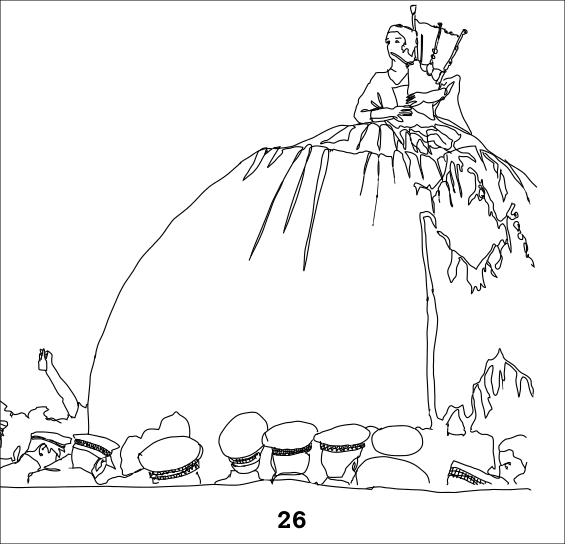
MG: There are various other creative protest groups such as UK Uncut (http://www.ukuncut.org.uk/) and the University for Strategic Optimism (http://universityforstrategicoptimism.wordpress.com/), whom I interviewed live on Resonance FM, December last year (http://www.furtherfield.org/radio/8122010-university-strategic-optimism-and-genetic-moo). Are you connected to any of these creative activist groups, and are there any others in the UK you would like us to be more aware of?
JJ: Yes – I’ve worked with UK Uncut, and was unfortunately arrested in Fortnum and Mason, whilst recording the BBC 4 afternoon play, but that’s another story! There are lots of interesting groups that work on the edge of art and activism, right now a space to keep an eye out for and to visit is THE HAIRCUT BEFORE THE PARTY – http://www.thehaircutbeforetheparty.net/ – set up by two radical young art activists who have opened a hair dressers that offers free hair cuts and political discussion about organising and friendship, rebellion and the material needs to engage in it. The salon is in 26 Toynbee Street, near Petticoat Lane and open till November. It’s an interesting example of a medium to long term, art activist project that attempts to create new forms of relationship and affinity, and sees itself as building radical movement and not simply representing them.

GG: Yeah, again the idea of the text was to build on the connections that are already there, which THBTP does too in a more informal, social way. And for sure, you shouldn’t be seen at the June 30th strikes or UK Uncut’s support actions without a flash new haircut. I should also get a plug in for Catalyst Radio – http://www.catalystradio.org/ a new 24/7 DIY UK-wide activist radio station, which started up the other week and is still growing, and brings together a lot of radical radio projects from around the country.
MG: Do you share a mutual empathy and respect for other protesters elsewhere such as those in Spain and in Greece, and in the Middle East?
JJ: Of course. Although it feels like the camp protests are lacking a conflictual approach and without the mixture of conflict and creativity, protest can easily be ignored, which is a bit what has happened with all the European camps. Although sitting here in the British library its easy to be critical ! Whatever happens, those involved in the camps will have tasted politics, new friendships, alternative ways of organising etc… As for the middle east, its all still in flux, who knows what will happen and the role of artists and musicians has been pretty key in setting the powder kegg alight there..
GG: Yeah, though I think there’s a tension between the symbolic solidarity of occupying city squares and the strategic differences between activist practices in different countries. I think solidarity between these struggles is massively important, though I’m personally not sure how it’s best to manifest that here right now.
MG: In the User’s guide, it mentions the workshops in art and activism at the Tate Modern, held by the Laboratory of Insurrectionary Imagination (Labofii), entitled it ‘Disobedience makes history’. And that Laboffii “was told, in an email, by the curators that no interventions could be made against the museum’s sponsors (which happen to be British Petroleum) [..] decided to use the email as the material for the workshop. Projecting it onto the wall they asked the participants whether the workshop should obey or disobey the curator’s orders.”
What I find interesting regarding this episode is both that a big institution would take the risk of inviting in art and activist culture to their usually, protected environment whilst being sponsored by British Petroleum; and the different forms of controversies reaching the public from such situations. I am surprised that Laboffii would even consider doing such a project in the Tate Modern in the first place, but also pleased, because of the dialogue that has come out of the clash of different political contexts. So, isn’t it the case that we need to explore issues of corporate corruption further within these big institutions so that those who would not usually consider such things are suddenly faced with the issues?
GG: I’m sure JJ has plenty to say about this. But more generally, it depends *how* they function as a platform. An art gallery or a university can be a great discursive space to explore issues, but the bounds of that debate are also strictly limited in lots of ways. This is a problem with the idea of a bourgeois public sphere. Most often, that boundary is that you can debate whatever you like but questioning the basic systemic assumptions on which such spaces rest isn’t possible, at least not in a practical way. The lab’s workshop at the Tate tried to question exactly that kind of assumption about what culture is for, and who it benefits. But for many activists from social movements, who have less faith in the public sphere and its institutions to resolve issues by discussion, that neutered debate is more of a problem than a benevolent gift to the public, and they have to take a different approach. Its not necessarily opposed to those institutions as a whole, but just asks them to make good on what they claim to be.
JJ: It’s a long story, but the key is to be able to put one foot inside these institutions and to be not frightened to KICK. But not to KICK symbolically, to really kick, to really shake them up and to be able to let go of one’s cultural capital. The Labofii will NEVER be re-invited to do anything at the TATE, bang goes all our chances of a retrospective in the fashionable art activism world !!! 😉 But, what we gain is that we were free ! When the curators told us that we could not do anything, could not take action against BP and we refused to obey them, we were free, we could do what we wanted because they could not give us anything in return. The Zapatistas say, “we are already dead so we are free” – when power can give you nothing you want, you can do anything.. this is a very powerful moment. To see the faces of the curators, the head of public, the head of security etc during the meeting where they tried to censor the lab, was priceless – they had always had power over artists, because artists will normally do ANYTHING to get their work in the Tate, but we did not care, we cared about the politics, about the actions, about climate change and social injustice – we were more powerful than the institution in that moment because we were no longer dependent on them.. it was one of the most beautiful moments… and now the movement against oil sponsorship is spreading everywhere. The message is simple, give up your cultural capital throw away your dependence on these institutions and be free…
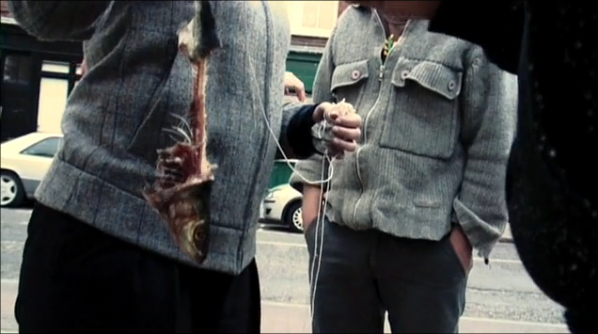
MG: I come from a background of hacking, social hacking and D.I.Y culture, and instead of going to University I chose to be self-educated, creating alternative groups for self discovery and art with dedication to social change. And even though, many are fighting the education cuts right now, what are your own ideas around self-education, do students really need to go to college now that there are so many different forms of information and ways in creating one’s own place in the world ‘with others’?
GG: A lot of experiments with autonomous self-education have sprung up recently which ask just this question, like the Really Free School (http://reallyfreeschool.org/), there are even some more institutional business-model experiments online with peer-to-peer education. But at the same time the catchment of both of these is relatively narrow at the moment, so I think there’s still a place for these kind of education institutions, and there are interesting radical experiments going on all over, either by individuals or whole departments, although the cuts to institutional funding for education by the government changes the playing field again, so there’s an opportunity for something like this to become less marginal, both inside and outside the university.
MG: JJ, In 2005 you wrote, Notes Whilst Walking on “How to Break the Heart of Empire”, in it you write “Radicals are often vulnerable souls. Most of us become politically active because we felt something profoundly such as injustice or ecological devastation. It is this emotion that triggers a change in our behaviour and gets us politicised. It is our ability to transform our feelings about the world into actions that propels us to radical struggle. But what seems to often happen, is that the more we learn about the issues that concern us, the more images of war we see, the more we experience climate chaos, poverty and the every day violence of capitalism, the more we seem to have to harden ourselves from feeling too much, because although feeling can lead to action we also know that feeling too much can lead to depression and paralysis…” How the hell do you remain positive when you know how many horrible and disgusting things are being done to decent folks and the planet all of the time?
JJ: Unfortunately there are no magic recipes that can protect us from such feelings, a lot depends on context on our particular situations etc. But here are a few tips that have helped me keep the despair of capitalism at bay:
1) Resist the spell of individualism that capitalism tries to weave around us, a spell that chains us to the fantasy of autonomy and keep us in a state of sadness and paralysis. Break this spell and its toxic chains by realising that you are part of a greater whole, that working with others gives us strength, that seven minutes making real friendships (face to face) is more political than seven days glued to a computer browsing social networks in a trance, that inevitably fails to shake the loneliness of modern life.
2) Build a gang, a group, a collective, a crew – remember the joy of plotting things together, the power and possibilities when work and imagination is shared. In fact, imagination finds it’s insurrectionary potential when we share it, when it’s freed from the privatised ego, escapes from shackles of copyright and the prison’s of the art world.
3) Learn the skills to work together with others, consensus decision making, group facilitation, conflict resolution etc. We need to re learn collective working methods, capitalism has destroyed all our tools of conviviality and we need to reclaim them back, recreate new forms of being together.
4) Redefine Hope. Not as something that will come and save us, like a saviour, but as something that comes from not knowing what will happen next, something that takes place when we act in the immediate moment and don’t know what will happen and trust that history is made from acts of disobedience that did not necessarily have any idea of what the next step was…
5) Remember that victory is not always what happens, but what did not happen. Social movements tend to forget this. Look at all the nuclear power stations that WERE not built, all the wars that did not happen, the laws that were never passed, the free trade agreements that were never agreed on, the repressions that the state could not get away with, the gmo’s that were never planted. One of my favourite books, what I call prozac on paper, is Rebecca Solnit’s HOPE IN THE DARK (http://www.goodreads.com/book/show/28048.Hope_in_the_Dark) – it’s a lovely little book which redefines hope in the most beautifully optimistic way, recommended reading when capitalism seems irresistible.
6) When everything appears useless, try to change your conception of time… think deep time, not shallow modern now time, but think about the generations that went before you and those that will come after you. Try to imagine what the generations of the future will think about your actions, imagine those from the past that fought for the emancipation of slaves and yet never saw the results of their actions, those who died for the eight hour day, for the right to build a union, the right to vote or publish an independent magazine. Spend time imagining how those alive in 50, 100 years will view your life and work…

MG: In the publication, you mention Marx and Debord. “We can all be engineers of the imagination”…”that our “general intellect”, all the collective knowledge and skills we use in making things, are taken away from us and embodied instead in the machines of our work. What would happen if we somehow re-engineered these machines if we did what Guy Debord argued and started, “producing ourselves… not the things that enslave us.” Do you see the recent cuts across the board as an example of how the powers that be are actively dis-empowering the working classes?
GG: Definitely. The cuts aren’t just about an experience of ‘austerity,’ however long term, but constitute a historical attack on poor and working people. They’re an attempt to technically recompose the material of the institutions, structures, ideas and habits people live through, in order to limit their ability to resist and remake them for themselves. In factory production, that involved the local restructuring of machine-labour, but later at a wider level Keynesian economic restructuring. This neoliberal restructuring of education is an extension of capitalist discipline into a new area, an attack on a social space which has historically been a base for social change. The government has made this pretty clear by, for example, David Willetts’s dictate amidst these massive cuts, to the Arts and Humanities Research Council, that the Tory party’s vacuous advertising slogan “the big society” become a core research area, replacing the less ideologically narrow area of ‘communities and civic values’; and the Department for Business and Innovation’s concomitant rewriting of the 1918 Haldane principle, that research directions are best decided by researchers through peer review.
The optimistic take on this is not that it’s an inevitable recuperation of resistance, which was the position Debord tended towards in the end, but that capital is always on the back foot – that its own developments are driven by and a response to social movements. That it’s an open dialectic (or if you prefer, not a dialectic at all). There’s a kind of neurosis to it, although rather than excluding the other to maintain its ego, the state is including everything to stave off other possibilities – you can see this in the language. The whole discourse of ‘participation’ and networks in business (and since the 1990s, also in art), is as Boltanski and Chiapello observed in their book the New Spirit of Capitalism, a recuperation of the language and terms of 1960s social movements – movements which first properly gave birth on a mass scale to the kinds of self-consciously autonomous and creative politics, or art-activism, which we talk about in the guide. Likewise, the big society is focused on mutuality, and there’s a strange recuperation of libertarian and radical thought by the thinkers behind it like Phillip Blonde. In this case, you’re left with a stunted vision of the anarchist idea of mutual aid, without any institutional aid, and structurally limited mutuality. But rather than simply critique this, I’m interested to look at how we might otherwise structurally and materially embody other kinds of social relation. Obviously this starts on a much smaller scale, and is often more directly materially embodied. University departments’ attempts to support radical philosophy within existing institutions and setting up new autonomous radical art institutions are two possible, but not mutually exclusive, directions here. As, of course, at the most local, accessible level, are the art-activist practices and objects we discuss in the guide.
Our new book-film is out “Les Sentiers de L’utopie”
Free online (in french) : http://www.editions-zones.fr/
Our blog: http://lessentiersdelutopie.wordpress.com/
our twitter: @nowtopia
3 different links to download the publication:
http://www.minorcompositions.info/usersguide.html
http://artsagainstcuts.wordpress.com/2010/12/06/a-users-guide-to-demanding-the-impossible
http://www.brokencitylab.org/notes/required-reading-a-users-guide-to-demanding-the-impossible
The Font used was Calvert is by Margaret Calvert, designer of our road signs.
Words: Gavin Grindon & John Jordan Design: FLF Illustration: Richard Houguez Original Cover: The Drawing Shed Produced by the Laboratory of Insurrectionary Imagination, London, December 2010. www.labofii.net Anti-copyright, share and disseminate freely.
More about Minor Compositions – a series of interventions & provocations drawing from autonomous politics, avant-garde aesthetics, and the revolutions of everyday life.
http://www.minorcompositions.info/
Crude awakening: BP and the Tate. The Tate is under fire for taking BP sponsorship money. Does corporate cash damage the arts — or is it a necessary compromise? We asked leading cultural figures their view. Interviews by Emine Saner and Homa Khaleeli. guardian.co.uk, Wednesday 30 June 2010. http://www.guardian.co.uk/artanddesign/2010/jun/30/bp-tate-protests
The first interview with Jake Harries, took place on one of Furtherfield’s Radio broadcasts on Resonance FM, earlier this March 2011. Fascinated by the historical context that came out of the radio discussion, we asked Jake for a second interview, this time it took place via email.
Jake Harries has been making music in Sheffield since the 1980s and is a sound artist, musician/producer, composer and field recordist with a strong interest in media art and the practical use of Open Source audio-visual software. He was a member of electronic funk band Chakk which is best known for building Sheffield’s first large recording studio, FON Studios, in the mid 1980s. He is currently one of “freestyle techno” trio Heights of Abraham and The Apt Gets, a band which uses guitars and only Open Source software on recycled computers to create songs from spam emails. He is Digital Arts Programme Manager at open access media lab, Access Space, and the current curator of the LOSS Linux Open Source Sound a website dedicated to music made with FLOSS.
Marc Garrett: Lets talk a bit about your own history first. You were in a band in the 80s called Chakk, could you tell us a bit about that?
Jake Harries: Chakk was based in Sheffield during the mid 80s and we are best known for building a heavily used facility, FON Studio, Sheffield’s first large commercial recording studio. Chakk made “industrial funk” music, a mix of funk base lines and drums with influences ranging from punk to soul to free jazz and electronica. Our music was aimed squarely at the dance floor. We believed that technology, in this case the recording studio, was the most important instrument a band could have both creatively and financially.
MG: So, you are part of the electro music history of Sheffield with bands like Cabaret Voltaire & The Human League in the late 70s – 80s?
JH: Yes, but the band itself didn’t have too much commercial success, a couple of indie chart top 10s and a couple of low 50s in the main UK chart, so few people remember us now. People are more likely to remember FON Studio.
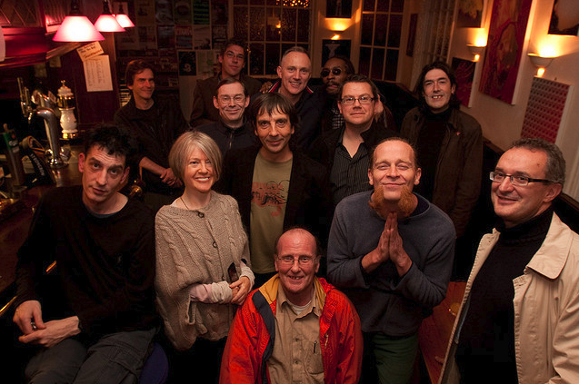
Recently a documentary has been made, called The Beat Is Law, about Sheffield music at that time, so perhaps there will be a bit more interest in the band.
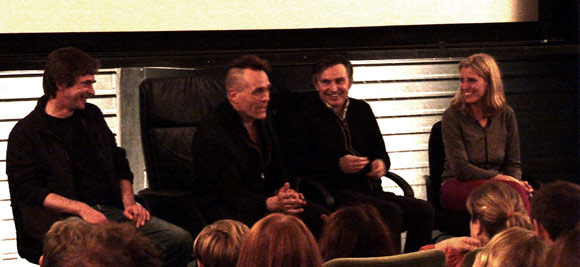
MG: Open Source software is freely downloadable from the Internet for free and Linux is the most widely used Open Source operating system. How long have you been using Linux operating systems and Open Source?
JH: I had heard of Linux before, of course, but I came across music applications which were developed only for Linux in 2002-3 while searching for new software tools. These intrigued me sufficiently to install the operating system on a pc which I had fixed where I was working at the time.
MG: Do you feel that artists, techies and others are choosing Free and Open Source resources for reasons which connect with ethical and environmental issues and concerns?
JH: Well, I’d like to integrate into this answer the general themes of openness and transparency. FLOSS is akin to an encyclopedia of how to make things in the software realm because all the code is available for anyone to download and develop; closed, proprietary software is like a “sealed box” which it is illegal to prise open.
But it goes a bit deeper than that: in the world we are living in now the “sealed box” is increasingly becoming the mode of choice for all kinds of products, most of which, because they are designed to be superseded, have built in obsolescence. When something goes wrong with a product, you are unable to fix it yourself because you can’t get inside it, and even if you could you can’t find out how to fix it. If it is out of warranty, either you pay a lot of money to get it fixed or you throw it away; then you buy a new one! (Which is what the market wants you to do…)
So, it feels very much as if we are surrounded by technology we are not encouraged to understand and products with a limited life span: the obvious environmental concern is, “what happens to my ‘sealed box’ when I throw it away?”
Using a Linux operating system can increase the useful life of a computer by several years, and perhaps, if you can hack into them, other products too. So it is great if both hardware and software are open.
We also know that sharing knowledge is generally considered to be a good thing as it allows people to build on what has already been discovered. Being able to give the people in workshops the software they have been learning to use because it is FLOSS, rather than them having to pay several hundred pounds because it is only available on a commercial license, is great and often the idea of this kind of freedom takes a while for people to get used to if they’ve not come across it before.
MG: Why is it important as a creative practitioner to be using Open Source?
JH: Well, personally, I have realised that what I’m interested in is freedom, not just as a hypothetical, but the practical reality, finding out how to achieve some of it and if it is possible to sustain it. Free & Open Source operating systems and software are one way of stepping out side of the constant pressures of the commercial market places which dominate our culture.
We tried this in Chakk in the 80s with FON Studio, attempting not only to personally own the means of producing our music, the studio (allowing us to be outside the corporate system of production), but also to be able to explore our creativity in the way we wanted to. In the case of Chakk it didn’t work out. We had, rather cheekily, persuaded a giant corporate (MCA Records, owned by Universal) to bank roll it all and they found ways of scuppering our plan by making our product conform to their idea of the market place: transforming it into something “radio friendly” and bland, taking the energy and urgency out of the music. We were quite a politicised band and that energy was essential to our musical integrity.

However, when MCA dropped us we had a recording studio which could help nurture new music without too much external pressure, and this led to records produced there by local acts fulfilling their potential and going into the charts.
I think it is important for artists to have certain freedoms, to have ownership over the means with which they create their work. The fact that FLOSS allows you the user the potential of customising the tools you use and to distribute them freely via the web or other means is quite profound. And one of the real benefits of using FLOSS as a creative practitioner are the use of open standards and formats.
MG: OK, let’s move onto your own band: The Apt Gets. Now, since The Human League & Cabaret Voltaire, a whole generation has experienced the arrival of the Internet. Your group seems to reflect this aspect of contemporary, networked culture – a kind of Open Source rock band. Could you tell us about this band The Apt Gets, how you all got started and why?
JH: It began with workshops I was leading for musicians on FLOSS audio tools in 2007. The idea of an “open source rock band” came up – at the time we didn’t think there was one so a couple of the workshoppers and myself formed one. The Internet was the main source of inspiration really: we used recycled computers with Linux we’d downloaded, as well as guitars and vocals. I’m interested in re-purposing junk as raw material for creative processes and decided to re-use some of my spam emails as lyrics. We all hate spam, but re-contextualising it like this is fun, as is introducing a song by saying, “Here’s a classic Nigerian email asking for your bank details”. The themes of spam emails are generally things like greed & money, status & sex appeal as well as “meds”, so there’s more to them than you might think.
MG: Now, I personally know why, but others who are not as familiar with Linux and Open Source Operating systems, will not immediately know this. The naming of your band’s name – it’s specific to installing software. Could you tell us more about that?
JH: On a Debian Linux based operating system one can install software from the internet using an application called apt. One could type apt-get install the-name-of-the-software into the command line and apt will get the software from what is called a repository on the Internet, where the software is stored for download. We thought that if you called someone an Apt Get it could be interpreted as an insult meaning something like, clever bastard. So, that’s why we named the band The Apt Gets.

MG: How long has your research project with FLOSS been going?
JH: The research project started in 2007. Ever since I began to use FLOSS I’ve been interested in the practical realities of using it, particularly as an every day set of tools, as an ordinary computer user would use it: for instance, when I do work on the arts programme at Access Space I don’t use anything else. So, it made sense to discover how a number of non-Linux using musicians would find using FLOSS audio tools – if I was being an advocate for FLOSS I ought to look at it from the new user’s angle and discover how far they could go and what kind of time scale they need.
MG: And the web site address is?
JH: http://audiotools.lowtech.org
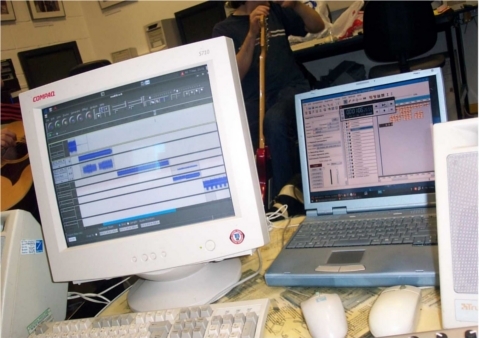
MG: How easy is it for someone with little or no experience of Open Source software and Linux based operating systems to install it?
JH: It is quite easy nowadays. A Linux distribution like Ubuntu has an easy to follow installer which allows you to create a dual boot if you want it, that is, keeping your Windows system as well so you have the choice of both.
MG: At Access Space in Sheffield, you are curator and researcher of LOSS (Linux Open Source Sound) a website dedicated to music made with FLOSS – which is basically LOSS with the letter ‘F’ added, meaning ‘Free Linux Open Source Sound’ – FLOSS!
JH: Yeah! Free is the word! It is a repository for music made with FLOSS tools and released under a Creative Commons license. You can freely download and upload tracks. Initially it was based around two projects, a physical CD issued in 2006 curated by Ed Carter, and LOSS Livecode, a mini conference and gig curated by Alex McLean and Jim Prevett based around the international livecoding community. The website is at http://loss.access-space.org.
MG: What is Access Space and what is different about them as a group?
JH: Access Space is an open access media lab, based in central Sheffield. It uses reused and donated computer technology to provide Internet access and Open Source creative tools, free of charge, five days a week. It started in 2000 and has become the longest running free Internet project in the UK.
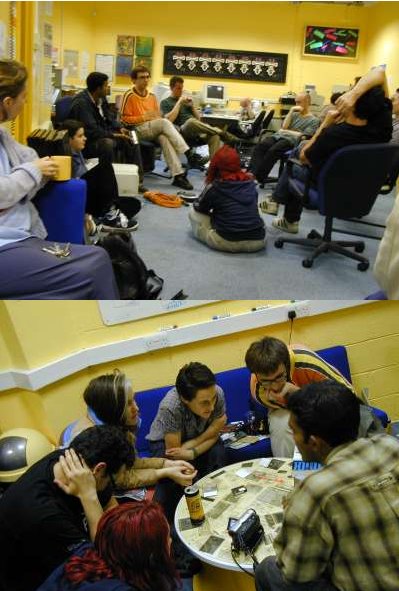
We recycle computers, put on art exhibitions, creative workshops and sonic art events. We’re currently developing a DIY Lab, modelled on MIT’s FabLab or fabrication laboratory. This will be an interface between the physical and digital domains where new kinds of creative activity can be developed.
MG: What operating systems would you suggest to newbies coming to Linux for the first time?
JH: Ubuntu or its derivative, Linux Mint, are both very user friendly for everyday use. For audio try Ubuntu Studio, 64 Studio or Pure:dyne.
MG: And regarding yourself, what are you using?
JH: I have set up eight Ubuntu Studio pcs for use in audio and video workshops at Access Space; and I use Pure:dyne live DVDs if I’m out and demonstrating on other people’s pcs. For everyday use, again Ubuntu Studio with a few additional applications like OpenOffice.
MG: Thank you for a fascinating conversation.
JH: It was a pleasure…
Open Access All Areas: an Interview with James Wallbank about Access Space by Charlotte Frost
http://www.metamute.org/en/Open-Access-All-Areas
Ubuntu Studio 11.04 release.
http://ubuntustudio.org/
64 Studio Ltd. produces bespoke GNU/Linux distributions which are compatible with official Debian and Ubuntu releases. http://www.64studio.com/
Puredyne is the USB-bootable GNU/Linux operating system for creative multimedia.
http://puredyne.org/
Pure:dyne Discussion, interview by Marc Garrett & Netbehaviour list Community 2008.
http://www.furtherfield.org/interviews/puredyne-discussion-netbehaviour
“You Are Now the Electronic Man” are the words that appear before even opening the website for The Electronic Man, a project initiated by Salvatore Iaconesi and Oriana Persico of Art is Open Source (AOS) and FakePress. And by becoming part of The Electronic Man, sharing your emotions as they become linked through QR Codes and help to build the frame of The Electronic Man, you are participating in a real time global performance.
This real time global performance relates to conceptual experiments by AOS and FakePress, in remixing reality and creating new sensual experiences with technology. The email interview took place after their recent exhibition at Furtherfield’s gallery in London, called REFF – REMIX THE WORLD! REINVENT REALITY!, which happened during February, March 2011, and during their current project The Electronic Man. We discuss AOS’s ideas and intentions, regarding their activities of performance and use of technology, and their methods of engagement with anthropology and biology.
Renee : The Electronic Man is quite an ambitious project. What inspired you to begin building the Electronic Man?
Salvator and Oriana: The Electronic Man is actually a very simple project (if quite a difficult one in terms of “making it happen”) as it is a direct poetic interpretation of a theory by Marshall McLuhan that goes by the same name. We decided to take the famous statement by Marshall McLuhan quite literally and transform it into something that is really happening in the world: “Electronic man like pre-literate man, ablates or outers the whole man. His information environment is his own central nervous system.”
What we wanted to do was to make our statement for the centennial of McLuhan’s birth, but to avoid the form of the “conference presentation” for it, and to show in a powerful way how the ideas expressed by McLuhan are really taking place in the world which we experience every day. So we decided to produce a performance, a global performance.
With the wonderful support of Derrick de Kerckhove, and of the MediaDuemila magazine (and the Associazione Amici di Media Duemila and the Osservatorio Tuttimedia, and the Department of Communication and Social Research of Rome’s University “La Sapienza”, who were organizing the official event for the centennial in Rome, under the fundamental guidance of Maria Pia Rossignaud) we were able to make it happen and everyone involved was really happy to include this experience in the official celebrations.
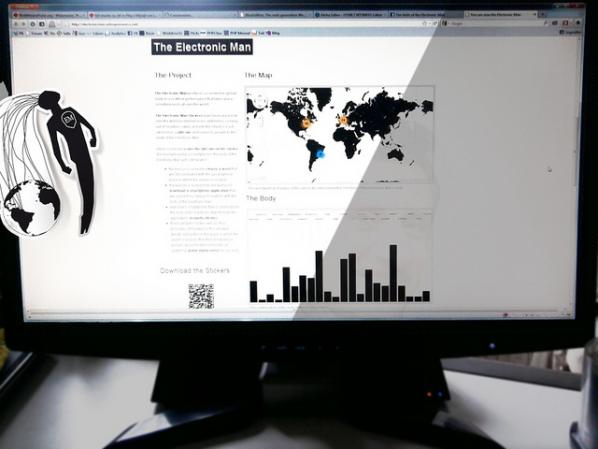
Renee Carmichael: I find the methodology behind this project really interesting. From what I understand it’s about going beyond the analogue vs. digital debate and really going in between and just experiencing and experimenting. Do you think this methodology is important to use in today’s world? How and why might this be so?
Salvatore and Oriana: We are living in a really complex scenario, complex, fast and ever changing. Digital technologies and networks are starting to pervade our analogue reality, transforming it and opening up entirely new possibilities. There are forms of (digital) interaction that are starting to be widely accessible from physical space. These forms of interaction are really peculiar as they allow for a transformation of (physical) reality, making it interactive, reinventing it, remixing it, and adding content to it. The world itself becomes a performance and a very specific form of performance: involving remixes, mashups, recontextualizations and reenactments as its main practices. This has drastic effects, not only as our reality multiplies and reshapes, but also attitudes, perceptions, skills, knowledge and approaches of the people involved change. In this process methodologies, practices and theories remix as well, bringing forth various possible scenarios, in which collaboration practices emerge as the only viable way to perform significant actions.

So, in this scenario, “life, the world and everything” is turning into a multipliable, performative environment in which the only way to, actually, perform in a significant way is to collaborate across cultures, skills, theories and methodologies. This brings forth a change to our sensorial environment, meaning that when ubiquitous technologies are involved, we instantly gain new senses, new sensorialities and sensibilities. Just like with the mobile phone, when it doesn’t catch the network, we move, naturally and without thinking about it, to a place that has better network coverage, in a way that is neurologically similar to the way in which we move our hand away from fire when we feel the heat: it is a real sensibility, an additional sense.
Mixing these two aspects (the forming of a multilayered, collaborative, read-write reality, and the emergence of these new senses), describes a situation that is almost exactly the one presented in the question: experimentation, as in performance and as in science, this new science that traverses disciplines, theories and approaches; and experience, meaning you are actually able to build a new experience of the world that is sensorial and, most important of all, writable.
This is also a good description of the shape that the term “conflict” is assuming: a continuous process of movement and traversal, in which you transform a part of reality (as in augmented reality) adding new meaning and imaginaries to it, in a performative action that unites activism, art, science, design and communication, and that transforms and is transformed really fast, at the pace of the evolution of technologies and networks.
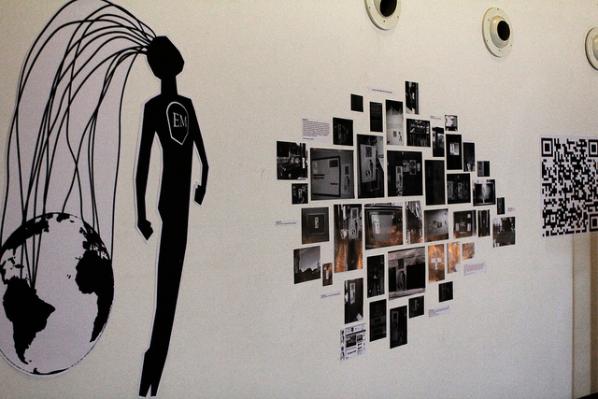
Renee: I read that this project can help us experience and reflect on our place in the world through the external. Do you think the relationship between the individual and the external takes a new shape throughout this project? How might it be understood in the larger ideas and theories of the Electronic Man?
Salvatore and Oriana: The Electronic Man is about the observation and exemplification of something that is already happening in the world. It speaks about interconnection and our renewed perception of space, time, body and relationships. Technologies helped us reshape these concepts completely. We are never in a single place now; we are everywhere, anytime and with lots of people all at the same time, using multiple identities, both voluntarily (mobile phones, ubiquitous networks..) and involuntarily (CCTV, social networks spying on us..). So all these definitions change radically: private and public space, gender, relationship, message, privacy, work and free time. We wanted to make this change explicit. In this change: public and private completely restructure! This is also why we decided to use the “emotional” dimension as a narrative: emotions are thought to be a private, intimate part of our lives, but now they are the object of public observation through what we do in the digital realms, for the new forms of economies that are developing, focusing on attention, reputation, awareness and more.
Renee: Although the Electronic Man allows us to experience sensually, it still creates finite points of data through the connections between a place and an emotion. What do you think is the relationship between the sensual impact of the project and the data it produces? How does the data fit into the idea of creating a new ‘global digital sense of our bodies’?
Salvatore and Oriana: This is a very complicated question! We chose this approach as a starting point. We are using a classification of emotions which is very basic (designed by Plutchik in 1980) it works really well across different languages (we are currently using 29 languages for our performances, to address as much of the world as possible). But this point that is described in the question (freeing the modalities of data, augmenting the degrees of freedom which we can express) is one of the focal points for expansion in the next steps. There are solutions and approaches which we are finding suitable to confront these issues with, and they are all related to adding degrees of freedom in what you “release to the public”: transforming artworks into free frameworks for expression that can be freely used by people. This transformation from artwork to framework is something that is happening all over, and it has to do with P2P culture and free software. This is why we release all the software and hardware (and methodologies) we use in our performances under free licenses: because the next step of each performance is made by the people taking the tools in their own hands and creating their own forms of expression and action, their own additional layers of the world.
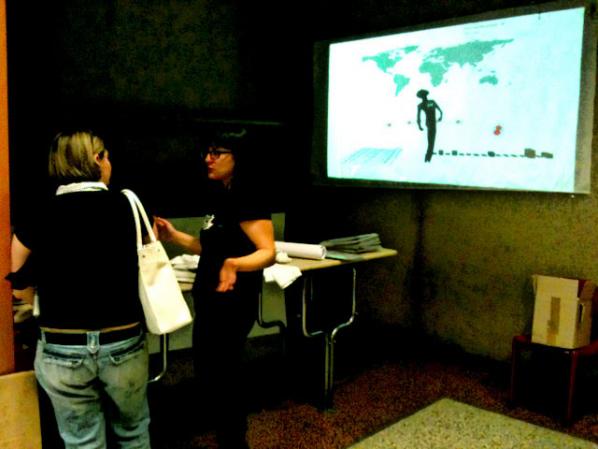
Renee: In a related note, this new form of being that the Electronic Man creates cannot be completely separated from the world and systems it exists in already. It seems that the questions that often arise around this project are in terms of how it can be used within other appropriations. How do you see the future of this project in terms of the various appropriations that it may have and in terms of your own intentions for the project?
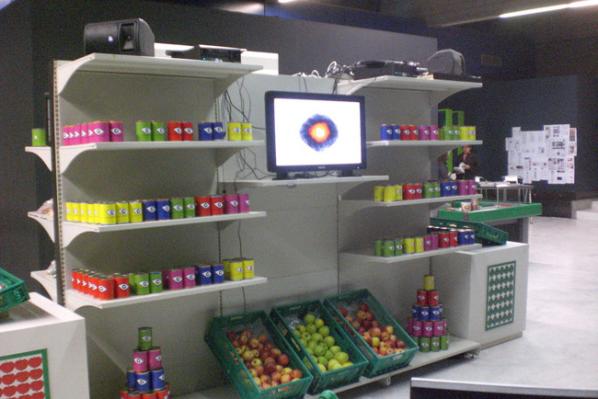
Salvatore and Oriana: As we said: we’re always in beta version. These processes are nomadic, temporary, and unstable. Ideas, software tools, concepts, hardware, practices and approaches are in a continuous state of remix: each time we speak to anyone, or even as we’re writing this, the performance changes and upgrades to the next version. For example we can look at the recent augmented reality interventions that have been taking place all over the world and, just a few days ago at the Venice Biennale: there has been a very fertile discussion building up during the last two years, on the idea that these technologies allow you to “squat” reality, and add new meanings and new degrees of freedom to it. This is why we created a project called Squatting Supermarkets a couple of years ago. This discussion is producing actions: appropriations, performances, re-usage of terms, words, sentences, new forms of activism, and new forms of art. We’re really happy that this is taking place, and we see all this as a wider form of performance in which everyone interested can be involved.
Renee: I can’t help but see a relationship between The Electronic Man and a sort of modern day Frankenstein. Would you like to comment on this relationship?
Salvatore and Oriana: We will answer this question using an answer that our dear friend prof. Massimo Canevacci gave to a question during a TV show in Italy: “This is a wonderful question, and I am deeply convinced that western cultures produced these really heavy mythologies around Frankenstein, the Golem, and arriving to a movie, a very nice one, like Blade Runner, taken from a novel by Philip Dick.
I am certain that this system, this dualism between technology and body, between organic and inorganic, between nature and culture, is finally over, in a liberating way. There are researches in which the concept of cyborg constitutes a perspective that is capable of liberating enormous possibilities. Therefore our bodies become progressively more entangled with technology all over literature, technology, anthropology, and biology.
Thus I sincerely hope that this enormous mythology, this terrifying myth of the Frankenstein, will finally end, once and for all, and will peacefully retire; and that new forms of cyborg will emerge and free themselves, to produce new free forms of expression.
Renee: Finally, any further issues, ideas, thoughts you would like to add?
Salvatore and Oriana: Yes!
The Electronic Man is a global performance! And it becomes useful if lots of people participate (and, by the way, participate by doing even simple things such as attaching some of the Electronic Man stickers around and sending us a picture, and you’ll find yourself and your work advertised whenever we exhibit the work: for example at the MACRO museum in Rome there is a full wall dedicated to the people that are helping us out, including their bios, pictures and links) But, most of all, it becomes useful if lots of people actively grab technologies, methodologies and concepts and actively build their own performative world, possibly sharing the results with everyone else.
So we strongly invite everyone out there to request the software, (it will be published on our sites as soon as we have some time to prepare a proper sharing mechanism, but you all can have it before that by simply asking) and to imagine other disruptive ways of using technologies to create free, accessible, inclusive spaces for communication and expression.
We will support you all in that as much as we can.
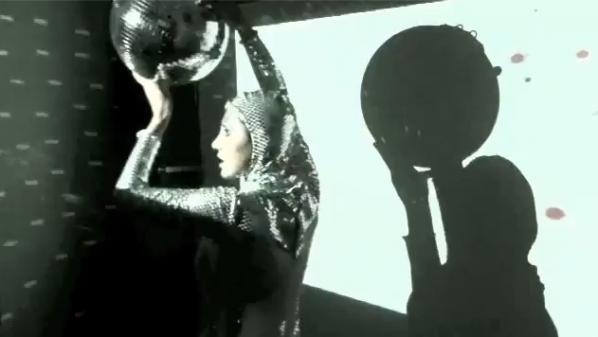
The Electronic Man at ADD Festival, MACRO Testaccio, Rome contemporary art museum, view video on Youtube.
Featured image: Walled out and hammered by Marc Garrett
A young guy in his early Twenties becomes curious about the world of the arts. He decides to do what others would do in these circumstances: he picks up a few arts magazines from a local newsstand and browses their content looking for the latest trends. However, he increasingly becomes frustrated with the amount of advertisements that fill these magazines, that appear to prevail over any sustained discussion on the arts. He dislikes the way art looks more like a big commercial circus than the honest display of creative talent. He grows disaffected with the patronizing tones of editors and so-called authorities in the field.
He decides to denounce this publicly by creating an online fake of Flash Art online, the current leading contemporary art magazine in Italy, choosing the telling URL of ashartonline.com (as opposed to flashartonline.com), and filling it with his own content. Following the magazine’s distribution (for a fee) of a publication that claims to contain the contacts of over 30000 galleries and curators (the Arts Diary), he decides to compile his own list of 3300 artists and art dealers contacts searchable online and to make it available for download (for free) to anyone. Noticing the patronizing tone and the rude replies that Flashart director, Giancarlo Politi, dispenses to whomever objects to his artistic and editorial choices, he creates a forum (letters to the Director, part 2) that encourages disgruntled artists and critics to voice their discontents. The website grows and receives a considerable number of hits. Not enough for being properly considered mainstream, but still a pesky doppelgänger and a welcome critique of Flash Art. The success that this modest détournement enjoyed during the six months of its existence showed that Luca Lo Coco, the young creator of ashartonline definitely had a point.
At this point the story sounds a lot like many other stories of netartists and netactivists who have directed their criticism towards institutions and corporations, or towards other fellow artists and arts databases, by cloning, hacking, spoofing, and mocking websites to short-circuit the usually lethargic and cynical flow of information that characterizes institutionalized outlets. Countless groups and collectives like the Yes Men, 0100101110101101.org, and later Ubermorgen, Paolo Cirio and Alessandro Ludovico, to different degrees, have practiced and supported this and similar tactics for years. Posing as WTO representatives or Spokespeople of major corporations, The Yes Men have made the fake as their main tactic since the mid-nineties to draw attention to the shady practices that organizations such as the GATT and WTO were conducting under the nose of unaware and apathetic individuals; operating within the independent art world and often turning their attacks towards this very domain, the 0100101110101101.org have perfected the practice of forgery of logos, artists and artworks to unveil the laziness of an art establishment more interested in the popularity of the artist signing the artwork than in the quality of the artwork itself, more focused on ways to sell art rather than honestly evaluating it, more preoccupied with establishing powerful networks with other equally powerful art critics and dealers rather than actually doing some genuine research. Inspired by Andy Warhol, Dadaism and the avant-garde and empowered by the technical potentials of digital media, the pranks and actions of these artists and media practitioners have become well-known among anyone interested in media activism and artivism, or among anyone who finds at least some cursory interest in media creativity.
Given the precedents, Luca Lo Coco’s take on Flashartonline is not an exception. Ashartonline was a website that exploited the spoof against the formulaic and uninspired direction of the arts publishing in Italy and the condescending attitude of a bunch of self-elected gate-keepers of the arts. In a typical situation however, maybe this site would have been remembered as one among many actions, a grain of sand in a desert. Maybe, the website would have enjoyed some short-lived popularity among a relatively limited supporters, but as it often happens in these circumstances, it would have likely been ignored by the director and the magazine it was criticizing, or just forced to shut down. In the end, Ashartonline was a clever website, but it was also fairly innocuous, barely scratching the surface of the colossal enterprise it was targeting.
Disregard, or pretending nothing has happened, has always been the most effective reaction of a targeted institution against spoofs, parodies and fakes. Unsurprisingly, when the Yes Men appeared on BBC posing as Union Carbide reps announcing that the company was ready to take responsibility for the Bhopal disaster on its twentieth anniversary, the real reps retracted the announcement but then didn’t bother going after the pranksters, behaving as if the episode hadn’t even occurred. They knew that starting a legal action would have drawn too much negative attention to the company and given free publicity to the Yes Men [1]. When the 0100101.org recently revealed that an installation of a cat in a cage [2] had not been executed by art star Maurizio Cattellan but had been created by the duo themselves, no fuss was made and no legal charges were issued. Instead, a simple disclaimer was issued [3]. The piece, as the artists themselves explained, went “back to the Internet,” from which the idea (and the picture of the cat) had originally emerged.
However, for reasons that we all fail to understand, the story of ashartonline took quite a different direction. Luca Lo Coco found himself at the center of a vicious attack initiated by the director of Flash Art Giancarlo Politi himself: not only was the website shut down, a surprising, but not totally unexpected outcome, but a judicial case which lasted for over three years ensued. Politi, it turned out, sued Lo Coco for infringement of intellectual property and other counts of damage for a total amount of 200,000 Euros. Even the judge didn’t find Ashartonline damaging enough to justify the absurd indemnity. However, he admitted, the website could have been the cause of a certain confusion (meaning that it had achieved his goal, a small consolation for Lo Coco). Thus, Lo Coco was given a deadline to pay a much smaller, yet still unaffordable fee of around Euro 7,000, a mix of legal fees and other bureaucratic expenses. When he did not produce the money, officers showed up at his door to confiscate his furniture.
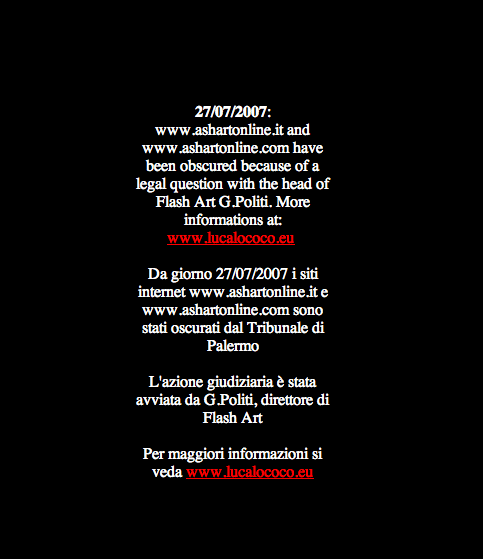
Now, some might contend that Politi, might not responsible for the cruel epilogue of this story, an extraordinary and strangely efficient move by the justice system, especially considering that the whole story takes place in Italy. Apparently, it was Politi who insisted that the confiscation went ahead as quickly as possible. This last bit adds even more outrage to this already absurd story, whose unfolding has already catalyzed a number of incendiary discussions on various Italian-based listservs and arts magazines [4]. In fact, to add insult to injury, the value of the furniture confiscated from Lo Coco falls short the amount he owes Politi. One wonders whether this is the end of the story or we should expect more surprises.
What makes this ordeal especially controversial and absurd is not the style Lo Coco used to splash his criticism on a website. It is the exaggerated reaction of the director of a respectable arts magazine who should have known better, but went all the way against an individual who was no particular threat to the publishing giant and who had no way to seek protection against his ire. At least a couple of reasons should have prevented Politi from keeping going at Lo Coco: first, if the precedents set by the egregious examples of 01001.org and the Yes Men may teach us anything, no counterattack has ever turned out to be the best reaction against spoofs and satires; second, as most of these examples have been recognized as forms of creative activism or as arts interventions, they should have been known to an arts publisher who claims to be knowledgeable on the emerging and most recent contemporary arts. Why this ridiculously ruthless reaction? Did Politi really fear (mistakenly) that Lo Coco website could constitute a threat to his magazine and its readership? Why didn’t he stop once he had obtained to have the website obfuscated? Did he think that letting a lone challenger have his way would have unleashed a whole horde of jackals just waiting for the right opportunity to disrupt his undisturbed realm? Was this an exemplar punishment?
Lo Coco, with his young age and, at the time Politi pressed charges, with a limited experience of the arts world as well as a almost non-existent network of allies to consult for mentorship and advice, was a really easy, too easy target. Thus, this action appears to be a rather gratuitous show off of power (both symbolic and material) towards someone who was virtually defenseless. Even more disturbing is the ludicrous amount of money that was asked from Lo Coco for the so-called damages caused to Flash Art. Politi’s move to silence (and of course defeat) Lo Coco using financial superiority is a trend that actually reveals the director’s personal view of where power resides, confirming exactly what Lo Coco wished to demonstrate with his website: power in the arts business is not measured on the basis of some cultural, or intellectual value and skills, but on money.
Second, Politi’s exaggerated reaction appeared to become gradually an act of intimidation directed to the whole independent arts community rather than a personal affair between him and Lo Coco. The latter, on the other hand, was the perfect scapegoat, the sacrificial lamb that would serve to re-affirm loudly and ostensively the power of BIG ART, authority, hierarchy, and institutions against the younger, subversive, independent emerging arts. The message sounds loud and clear: see what happens when you dare criticizing the powerful and dare not playing by the rules established by the Artsworld? This sounded like a warning to all young and independent artists, just in case they have the temptation in the future to challenge the existing power dynamics hierarchies. Had art star Maurizio Cattellan created something similar to Lo Coco’s, asks journalist Helga Marsala in an article dedicated to the episode, “…what would have happened? Clearly, no accusation, no lawsuit. On the contrary, Politi would have even dedicated a magazine cover to this work [5]”
Ultimately, what happened might have been a source of great (financial) discomfort to Lo Coco. He probably would have never thought that such dispute would be taken this far. However, the circumstances of this episode unleashed a great deal of solidarity and sympathy towards Lo Coco-David fighting against the taxidermized and conventional Politi-Goliath. Many individuals offered to get the voice out or to write notes and articles about this outrageous episode. This means that there exists a –somehow—unified network out there ready to take action when such crises ensue. In the long run then, this unexpected cohesion might cause more discomfort to Politi. He thought he would just get away with annihilating his enemy. However, if Lo Coco really bothered him, suing him might have just been the wrong move. In fact, If he had done his homework he would have probably known what happens when you try to defeat your adversary in this way: you might inadvertently create more publicity for him. This story has already given Lo Coco much more visibility and respect than he would have gotten, had he not being sued and humiliated in this way. In other words, this story has already put his name among those subversive artists who have no problem challenging the system. In addition, the same sudden emergency that cost Lo Coco his furniture and that initiated the just mentioned encouraging wave of support, also caused a great deal of thinking and brainstorming on how to react (creatively, of course) against Politi and other’s bold attack. Thus, we should all thank Politi for having given us an idea for future critical (and humorous) actions against his magazine and his arrogant attitude, as well as for having reinvigorated and definitely strengthened our network.
An Interview with Julian Oliver By Taina Bucher.
I met the Berlin-based media artist and programmer Julian Oliver in Toronto as part of the Subtle Technologies festival, where he taught a workshop on the Network as Material. The aim of the workshop reflects Oliver’s artistic and pedagogical philosophy nicely; to not only make people aware of the hidden technical infrastructures of everyday life but to also provide people with tools to interrogate these constructed and governed public spaces.
Julian Oliver, born in New Zealand (anyone who has seen him give a talk will know not to mistake him for an Australian) is not only an extremely well versed programmer but is increasingly as equally knowledgeable with computer hardware. His background is as diverse as the places he has lived and the journeys it has taken him on. Julian started out with architecture but became increasingly interested in electronic art after working as Stelarc’s assistant on ‘Ping Body’, Auckland,1996. He moved on to Melbourne, Australia, and worked as guest researcher at a Virtual Reality center. Later he established the artistic game-development collective Select Parks and in 2003 left for Gotland to work at the Interactive Institute of Sweden’s game lab. He then moved on to Madrid where he had extensive involvement with the Media Lab Prado. Several countries, projects and residencies later, he made Berlin his preferred base, setting up a studio there with colleagues. Julian is also an outspoken advocate of free software and thinks of his artistic practice not so much as art but more in terms of being a ‘critical engineer’, a term that he applies particularly to his collaborations with his studio partner Danja Vasiliev.
Their latest collaboration called Newstweek, was recently announced as winners of the Golden Nica in the Interactive art category of the Prix Ars Electronica 2011. The project leverages on the network as a medium for rigorous, creative investigation, exploring the intersection between the perceived trustworthiness of mass media and the conditions of networked insecurity.
His artistic practice clearly reflects his hacker and gaming background, playing around and messing with routers, capturing data from open wireless networks, visually augmenting commercial billboards in the cityscape, sonifying Facebook chats, visualizing protocols and otherwise manipulating networks for artistic purposes. I sat down with Julian on June 1st to talk about his most recent art projects, his reflections on software and digital media arts more generally. The interview was transcribed from a voice recording in a busy cafe to the best of my ability.
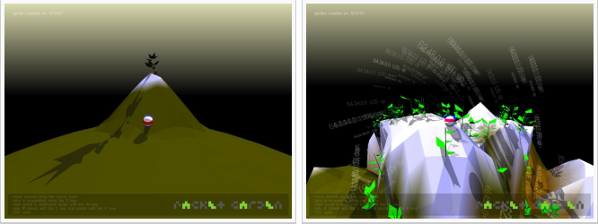
Taina Bucher: You started out with architecture and then moved over to games. How did that transition come about?
Julian Oliver: I realized quite early on that I was less interested in buildings than I was in exploring architecture in the context of the language within which it operates. I was more interested in hypothetical architecture. Like impossible structures such as what Buckminster Fuller proposed, and when I ended up working in a virtual reality centre in Melbourne I found that sitting behind a bunch of SGI machines dedicated to rendering virtual experiences, that I no longer really needed to invest in the idea to build something. I was more interested in something more plastic and mutable. The bridge from there to games came about around 1997-1998. Source code from games started to become available and it became apparent to me that it was possible to modify these games to explore an artistic practice, an architectural and sculptural practice really, using the medium of computer games. There were only 4-5 of us in the world working on this and we quickly made contact with each other. I left the VR centre and started an artistic game based modification lab in Melbourne called Select Parks. For about six years we did a whole bunch of projects based on computer games. We also established an online archive of the ever-increasing experiments and artistic investigations into computer game technology under selectparks.net. The archive is still there now.
TB: Was it the same interest in the mutability of the medium that led you to work with software more generally?
JO: I’ve been programming since I was pretty young and I’ve been around computers since I was a boy and working with them, but it was when I started to increase my freedom of movement with the medium of computer games that I became a programmer. I started to learn C, C++ and scripting languages and I quickly became hooked with the mix between technical challenges and rigorous creative exploration. I think the balance of the two still remains in my work.
TB: In one of your academic papers on games you ask the question of how much of the medium, as a raw field of possibilities, really is available to the artist. Well, let me ask you the same question in relation to software given that software always comes with a certain kind of aesthetic expectation.
JO: Definitely. I think it is a bit of a shame that much of what is called digital art is in fact made by using software suits built by large corporations. Macromedia, now the Adobe suite, is almost an infrastructure of the media arts. Painters of 200 years ago would never have accepted this brand attached to their canvas. They would never have accepted that their tools would be designed with such a generic mass audience in mind. I think that while the digital arts are certainly an exciting field there is an unadmitted dependency on a food chain that comes entirely from a corporation. The contemporary artist would then talk about breaking these tools, or you know, misusing them. But who is really holding the power? I think at a certain point for me, this was the reason why I moved entirely into free software. I really wanted to look at software as a core medium itself and I wanted to get at the guts of it. I wanted to have a rigorous personal relationship with technology so that I could bend it to my needs rather than my needs being bent.
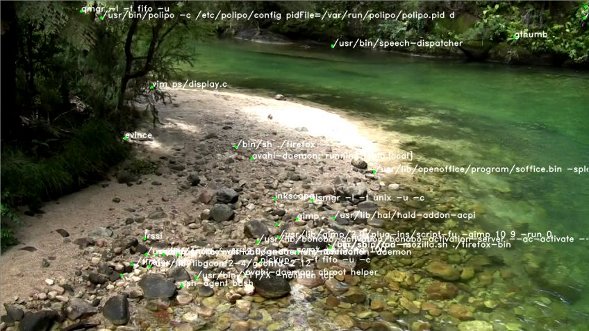
TB: How do you picture a genuinely critical media arts practice then, moving away from the Adobe suites of the world?
JO: No, I think it is fine to use Adobe if it satisfies your expectations. However I think that the expectations themselves are already defined by these external corporate market inputs. I think it is really important for digital artists to understand what digits are. They call themselves software artists but they do not really write software or know what it is. By using it their works become symptomatic of a process that they themselves have not defined.
TB: Does this mean we have to know code in order to be critical of code?
JO: Yes. I think you need to speak the language. It is the same thing with other cultural practices; you need to know the basics of how a violin or a guitar works before you can pass a judgement on the player. There is a parallel history to the new media arts that is not written and that’s all of those technical and cultural contributions that artists and technologists make when they are producing a work of new media. There is certainly a very well written history for the work of art in the galleries but there is nothing of the sorts for the fundaments of the technical achievements. I mean we have that with music for instance, with the evolution of the piano, but there are things happening in the new media arts all the time that no one other than the technologists can really appreciate. These are significant contributions that actually shape the way in which media are used in the future. This is certainly the case with the development of a new programming language that a historian might not necessarily notice. A language like Python or a framework like open frameworks has shifted media arts in such an influential way. Most people only see the end product. Understanding just a little in this regard is enough for enriching the history of the field I think.
TB: One could certainly argue that the ‘democratization of code’ with web 2.0 technologies and open APIs potentially lets anyone produce software art?
JO: Yes certainly. Take Processing for instance, anyone can make a digital square if they want. There is nothing inherently wrong with that. What I am interested in is to make people understand what’s behind it. I think we as artists need to describe what we do and part of this is to publish the source code. For me personally this is an obligation. By publishing the source code I am enriching the scene by allowing other people to have an insight into how it works. Take the project that Danja and I have been doing with Newstweek. If we would hide the way it works it would not enrich anything. We’d only be contributing to our own careers. We therefore publish all our code. You can download it now and already be learning how we did it and so together as a whole we move forward.
TB: Is code ever finished?
JO: That’s a really good question. Probably not. Someone could come along and improve what you think is finished. Every problem can be solved in a multitude of different ways. What constitutes being finished for one program might be elegance of expression. For another one it might be its performance. There are different value systems for programmers. Code in an open context, that is published openly, tends to be living or have the opportunity to live and be contributed to.
TB: You mentioned that most people do not know what software is, would you mind elaborating on that?
JO: Software in its simplest form is a group of instructions that work together somewhat contiguously to process data with an intended outcome. Data itself is everything that is not program code and program code itself is instructions written in a human readable language that are compiled into a form that the computer can understand. Computers have their own language; they are interpreters in a sense. You can really understand software as an automation of multitudinous processes to speed up the production of an intended or desirable outcome. Decision-making can occur, so it is not just a one-dimensional procedure. For the user though, software is generally just a skin of metaphors. If you think about it, clicking a picture becomes an initiation of an event and software is made to allow for the clicking of pictures to allow it to start a program. I mean software is many things at the same time, a field of illusions and metaphors.
TB: To what extent can you be taken by surprise by the software as an artistic medium given that it is your instructions?
JO: Well it depends on the scale of the project. Much of the time the software is a field of limitations. Working with software is about finding ways to make these limitations work and move within them. Unless you (of course) do something in Processing and you just want it to make a square then you just want the program to do exactly this. But for more complex projects I’d describe computer programming as a process of self-humiliation. It is about finding out how poor your initial assumptions about your own abilities are, you feel frustration and you need to fight against your own attention deficit disorder. It is a conversation with yourself, self-development ultimately. Secondly, it is a process of breaking down big problems into smaller ones until so much of the smaller problems are solved that the big one is solved too. But first and foremost I think that software development is self-development.
TB: Speaking of self-development. It is interesting to note that you have in a way returned to architecture, the difference being that you are not sculpting the physical space but the immaterial space. Maybe more so than building things one could say that you deconstruct them, take them apart through intervening and disrupting space.
JO: Yeah. Danja and I work together a lot these days and we refer to ourselves less as artists than as critical engineers. We firmly believe that the most transformative language of our time, one that defines whole economies, I mean how we trade, how and what we eat, how we converse with each other, how we move around the world is engineering. Art itself is increasingly diluted in transformative power, it has become more like entertainment than necessarily anything that is intrinsically rigorous. In the early days of the 1920s and 1930s we had interventionists’ strategies that are now known as art but they didn’t call themselves artists at the time. So as I have been saying to myself quite a lot recently it doesn’t matter if I call what I do art, others will do it for me anyway. So I better describe myself as a critical engineer by taking the language of engineering and lifting it out from a strictly utilitarian space and look at it as a language for rich, critical inquiry and really take on that challenge. It is really about taking the language of engineering and blowing it wide open, taking it away from this kind of black box reality, of big companies making stuff for civilians. This is essentially our relationship to technology. The companies and government make technologies upon which we depend and I think as any technology becomes more ubiquitous like smart phones our ignorance increases. With ubiquity comes ignorance and it seems to be a plottable, predictable curve. The idea of being a critical engineer is to intervene at this point and say “No! Stop!”. We need to reflect on what we are working with and how what we depend upon is shaping us. So learning this hard stuff in order to evade the top down superstructure is necessary.
TB: This might be a good transition to talking about Newstweek, a project that precisely seeks to evade the top down superstructure that you mentioned. How did this project that you’ve collaborated on with Danja Vasiliev come about?
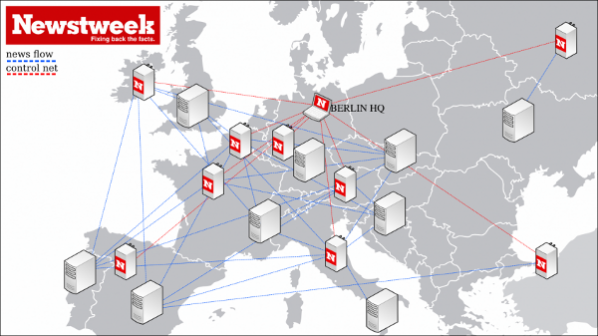
JO: We were at the Chaos Computer Club early this year and we put a little plug into the wall where we put a small router inside. Our goal was really simple, to go into the Berlin congress centre with thousands of hackers and put the thing into the wall and see how long it would last without anybody noticing. We expected it would last a few hours but it was there for the entire conference. One could see it from hundreds of meters away but nobody did something about it, so we realized we were onto something. So we wanted to build a device that looks so much like part of the infrastructure that it would appear harmless.
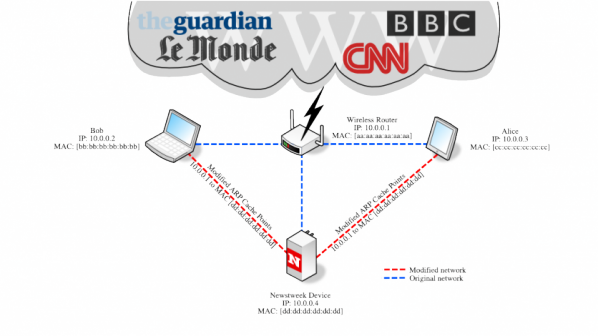
Newstweek: fixing the facts from newstweek on Vimeo.
The second thing was to couple it with a man-in-the-middle attack and to interrogate what we increasingly refer to as a browser-defined reality. Meaning that if it manifests in the browser, it is somehow authentic. It is this idea of going to a major news site, and as long as what one sees comes from this imaginary thing called a server and propagates in your browser, it is somehow trustworthy. We wanted to explore the limits of the impossibility of intervening in an otherwise top-down distribution of news. We wanted to find an on-the-ground way for civilians to intervene with this authority by manipulating the facts. It is really about allowing for a lateral interception of news sources, such as the BBC, the Guardian and CNN.
TB: Did you also record or document people’s reactions to their suddenly altered or tweaked news?
JO: Yeah, we have done this. The thing for us though was merely to provide a platform. People didn’t really believe that Newstweek worked. So we released the how-to saying here is where you buy the hardware, how you open it up, the firmware, the script, and so forth. Only then we had this quiet retrospect where people were going “aha”. What we have changed is their relationship with their environment. It doesn’t matter whether there has been a Newstweek-device in the environment or not. The very fact that they are looking around them and thinking that what is happening in their browser may have been tweaked is the most desirable outcome. This is exactly what happened. Most of the comments are of that nature, saying, “I will never trust the news again”. I mean, even when the attention for the project falls back to the sleepy town of acceptance, I think we can still be very proud of ourselves.
TB: Not just Newstweek, but much of your work is about intervening in public space and exploring the meaning of place. What do these concepts mean to you?
JO: Well I am very interested in the writings of Edward S Casey and the phenomenologist’s Husserl, Mearleau-Ponty and Heidegger of course. One of the great things that has come out of that thought is that Space in itself does not really exist, just as there is no number 2 in the universe. What we have done is to create a concept in order to pre-empt space, to reduce contingency, and in this way so much scientific thought is about reduction of contingency. Space of course is a projection of mathematical constituents to make determinations. Through mathematics and cartography and the like we have seen a growth in trust in the space model rather than the place model. So what I am really interest in, is that rationalization of place has allowed us to live in cities, which have been atomically and economically particularized, privatized. I am interested in how the distinctions between public and private is often extraordinarily blurry. A good example is the fact that a company can pay to put a huge picture outside your apartment during construction for instance yet when it is a millimetre or two away from your wall it no longer belongs to you. Or when you are drilling a hole through your wall in your house at a certain point you are going to hit the neighbours next door. Where does it begin and where does it end? It really shows that territory and place are just constructions. The same goes for wireless technology.
TB: Why is it important to question the ways in which we experience public space?
JO: Well take my work Artvertiser as an example. We have come to accept that our cities are covered in proprietary imagery. So I find it important to question this read-only space much in the line of ad busting and culture jamming. We just did a big streetwise exhibition in Helsinki where artists chose their brands and they made concise commentary simultaneously finding a new way of being in their city.
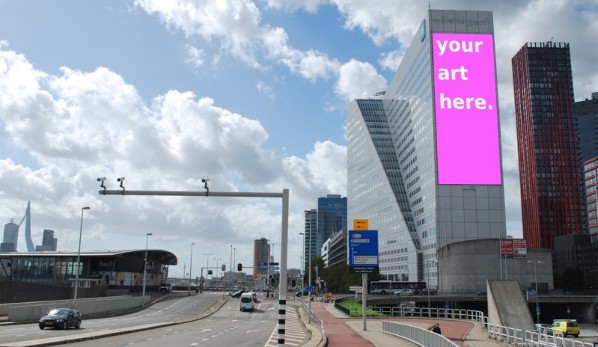
TB: Place often resides in memory and to a certain extent requires permanence. With Artvertiser it is only a temporary intervention. In the end the proprietary imagery stays. What do you hope people take away from an artwork like the Artvertiser?
JO: True. But again, the most productive outcome is conversation. We have the public coming up and looking again and again, through the binoculars at the modified billboards. We even had security guards getting angry. I mean all we are doing is producing a new experience in the visual cortex. Why would a member of the public like the security guard get angry that we are modifying our own experience voluntarily? It is kind of curious.
“At the dawn of the new millennium, Net users are developing a much more efficient and enjoyable way of working together: cyber-communism.” Richard Barbrook.
Dmytri Kleiner, author of The Telekommunist Manifesto, is a software developer who has been working on projects “that investigate the political economy of the Internet, and the ideal of workers’ self-organization of production as a form of class struggle.” Born in the USSR, Dmytri grew up in Toronto and now lives in Berlin. He is a founder of the Telekommunisten Collective, which provides Internet and telephone services, as well as undertakes artistic projects that explore the way communication technologies have social relations embedded within them, such as deadSwap (2009) and Thimbl (2010).
“Furtherfield recently received a hard copy of The Telekommunist Manifesto in the post. After reading the manifesto, it was obvious that it was pushing the debate further regarding networked, commons-based and collaborative endeavours. It is a call to action, challenging our social behaviours and how we work with property and the means of its production. Proposing alternative routes beyond the creative commons, and top-down forms of capitalism (networked and physical), with a Copyfarleft attitude and the Telekommunist’s own collective form of Venture Communism. Many digital art collectives are trying to find ways to maintain their ethical intentions in a world where so many are easily diverted by the powers that be, perhaps this conversation will offer some glimpse of how we can proceed with some sense of shared honour, in the maelstrom we call life…”
Marc Garrett: Why did you decide to create a hard copy of the Manifesto, and have it republished and distributed through the Institute of Networked Cultures, based in Amsterdam?
Dmytri Kleiner: Geert Lovink contacted me and offered to publish it, I accepted the offer. I find it quite convenient to read longer texts as physical copies.
MG: Who is the Manifesto written for?
DK: I consider my peers to be politically minded hackers and artists, especially artists whose work is engaged with technology and network cultures. Much of the themes and ideas in the Manifesto are derived from ongoing conversations in this community, and the Manifesto is a contribution to this dialogue.
MG: Since the Internet we have witnessed the rise of various networked communities who have explored individual and shared expressions. Many are linked, in opposition to the controlling mass systems put in place by corporations such as Facebook and MySpace. It is obvious that your shared venture critiques the hegemonies influencing our behaviours through the networked construct, via neoliberal appropriation, and its ever expansive surveillance strategies. In the Manifesto you say “In order to change society we must actively expand the scope of our commons, so that our independent communities of peers can be materially sustained and can resist the encroachments of capitalism.” What kind of alternatives do you see as ‘materially sustainable’?
DK: Currently none. Precisely because we only have immaterial wealth in common, and therefore the surplus value created as a result of the new platforms and relationships will always be captured by those who own scarce resources, either because they are physically scarce, or because they have been made scarce by laws such as those protecting patents and trademarks. To become sustainable, networked communities must possess a commons that includes the assets required for the material upkeep of themselves and their networks. Thus we must expand the scope of the commons to include such assets.
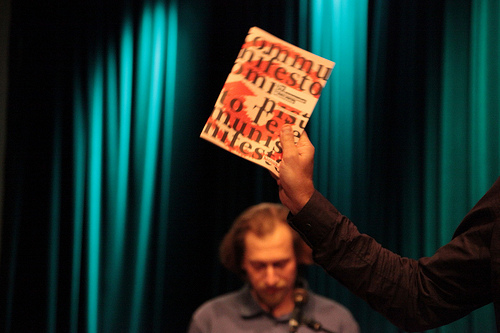
MG: The Manifesto re-opens the debate around the importance of class, and says “The condition of the working class in society is largely one of powerlessness and poverty; the condition of the working class on the Internet is no different.” Could you offer some examples of who this working class is using the Internet?
DK: I have a very classic notion of working class: Anyone whose livelihood depends on their continuing to work. Class is a relationship. Workers are a class who lack the independent means of production required for their own subsistence, and thus require wage, patronage or charity to survive.
MG: For personal and social reasons, I wish for the working class not to be simply presumed as marginalised or economically disadvantaged, but also engaged in situations of empowerment individually and collectively.
DK: Sure, the working class is a broad range of people. What they hold in common is a lack of significant ownership of productive assets. As a class, they are not able to accumulate surplus value. As you can see, there is little novelty in my notion of class.
MG: Engels reminded scholars of Marx after his death that, “All history must be studied afresh”[1]. Which working class individuals or groups do you see out there escaping from such classifications, in contemporary and networked culture?
DK: Individuals can always rise above their class. Many a dotCom founder have cashed-in with a multi-million-dollar “exit,” as have propertyless individuals in other fields. Broad class mobility has only gotten less likely. If you where born poor today you are less likely than ever to avoid dying poor, or avoid leaving your own children in poverty. That is the global condition.
I do not believe that class conditions can be escaped unless class is abolished. Even though it is possible to convince people that class conditions do not apply anymore by means of equivocation, and this is a common tactic of right wing political groups to degrade class consciousness. However, class conditions are a relationship. The power of classes varies over time, under differing historical conditions.
The condition of a class is the balance of its struggle against other classes. This balance is determined by its capacity for struggle. The commons is a component of our capacity, especially when it replaces assets we would otherwise have to pay Capitalist-owners for. If we can shift production from propriety productive assets to commons-based ones, we will also shift the balance of power among the classes, and thus will not escape, but rather change, our class conditions. But this shift is proportional to the economic value of the assets, thus this shift requires expanding the commons to include assets that have economic value, in other words, scarce assets that can capture rent.
MG: The Telekommunist Manifesto, proposes ‘Venture Communism’ as a new working model for peer production, saying that it “provides a structure for independent producers to share a common stock of productive assets, allowing forms of production formerly associated exclusively with the creation of immaterial value, such as free software, to be extended to the material sphere.” Apart from the obvious language of appropriation, from ‘Venture Capitalism’ to ‘Venture Communism’. How did this idea come about?
DK: The appropriation of the term is where it started.
The idea came about from the realization that everything we were doing in the free culture, free software & free networks communities was sustainable only when it served the interests of Capital, and thus didn’t have the emancipatory potential that myself and others saw in it. Capitalist financing meant that only capital could remain free, so free software was growing, but free culture was subject to a war on sharing and reuse, and free networks gave way to centralized platforms, censorship and surveillance. When I realized that this was due to the logic of profit capture, and precondition of Capital, I realized that an alternative was needed, a means of financing compatible with the emancipatory ideals that free communication held to me, a way of building communicative
infrastructure that was born and could remain free. I called this idea Venture Communism and set out to try to understand how it might work.
MG: An effective vehicle for the revolutionary workers’ struggle. There is also the proposition of a ‘Venture Commune’, as a firm. How would this work?
DK: The venture commune would work like a venture capital fund, financing commons-based ventures. The role of the commune is to allocate scarce property just like a network distributes immaterial property. It acquires funds by issuing securitized debt, like bonds, and acquires productive assets, making them available for rent to the enterprises it owns. The workers of the enterprises are themselves owners of the commune, and the collected rent is split evenly among them, this is in addition to whatever remuneration they receive for work with the enterprises.
This is just a sketch, and I don’t claim that the Venture Communist model is finished, or that even the ideas that I have about it now are final, it is an ongoing project and to the degree that it has any future, it will certainly evolve as it encounters reality, not to mention other people’s ideas and innovations.
The central point is that such a model is needed, the implementation details that I propose are… well, proposals.
MG: So, with the combination of free software, free code, Copyleft and Copyfarleft licenses, through peer production, does the collective or co-operative have ownership, like shares in a company?
DK: The model I currently support is that a commune owns many enterprises, each independent, so the commune would own 100% of the shares in each enterprise. The workers of the enterprises would themselves own the commune, so there would be shares in the commune, and each owner would have exactly one.
MG: In the Manifesto, there is a section titled ‘THE CREATIVE ANTI-COMMONS’, where the Creative Commons is discussed as an anti-commons, peddling a “capitalist logic of privatization under a deliberately misleading name.” To many, this is a controversy touching the very nature of many networked behaviours, whether they be liberal or radical minded. I am intrigued by the use of the word ‘privatization’. Many (including myself) assume it to mean a process whereby a non-profit organization is changed into a private venture, usually by governments, adding extra revenue to their own national budget through the dismantling of commonly used public services. Would you say that the Creative Commons, is acting in the same way but as an Internet based, networked corporation?
DK: As significant parts of the Manifesto is a remix of my previous texts, this phrase originally comes from the longer article “COPYRIGHT, COPYLEFT AND THE CREATIVE ANTI-COMMONS,” written by me and Joanne Richardson under the name “Ana Nimus”:
http://subsol.c3.hu/subsol_2/contributors0/nimustext.html
What we mean here is that the creative “commons” is privatized because the copyright is retained by the author, and only (in most cases) offered to the community under non-commercial terms. The original author has special rights while commons users have limited rights, specifically limited in such a way as to eliminate any possibility for them to make a living by employing this work. Thus these are not commons works, but rather private works. Only the original author has the right to employ the work commercially.
All previous conceptions of an intellectual or cultural commons, including anti-copyright and pre-copyright culture as well as the principles of free software movement where predicated on the concept of not allowing special rights for an original author, but rather insisting on the right for all to use and reuse in common. The non-commercial licenses represent a privatization of the idea of the commons and a reintroduction of the concept of a uniquely original artist with special private rights.
Further, as I consider all expressions to be extensions of previous perceptions, the “original” ideas that rights are being claimed on in this way are not original, but rather appropriated by the rights-claimed made by creative-commons licensers. More than just privatizing the concept and composition of the modern cultural commons, by asserting a unique author, the creative commons colonizes our common culture by asserting unique authorship over a growing body of works, actually expanding the scope of private culture rather than commons culture.
MG: So, this now brings us to Thimbl, a free, open source, distributed micro-blogging platform, which as you say is “similar to Twitter or identi.ca. However, Thimbl is a specialized web-based client for a User Information protocol called Finger. The Finger Protocol was orginally developed in the 1970s, and as such, is already supported by all existing server platforms.” Why create Thimbl? What kind of individuals and groups do you expect to use it, and how?
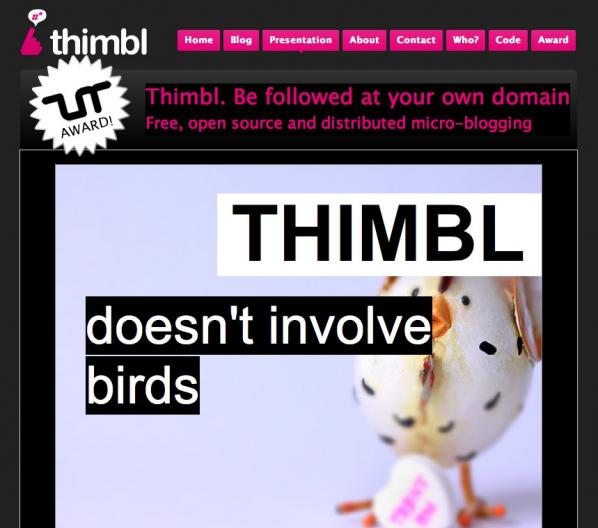
DK: First and foremost Thimbl is an artwork.
A central theme of Telekommunisten is that Capital will not fund free, distributed platforms, and instead funds centralized, privately owned platforms. Thimbl is in part a parody of supposedly innovative new technologies like twitter. By creating a twitter-like platform using Finger, Thimbl demonstrates that “status updates” where part of network culture back to the 1970s, and thus multimillion-dollar capital investment and massive central data centers are not required to enable such forms of communication, but rather are required to centrally control and profit from them.
MG: In a collaborative essay with Brian Wyrick, published on Mute Magazine ‘InfoEnclosure-2.0’, you both say “The mission of Web 2.0 is to destroy the P2P aspect of the Internet. To make you, your computer, and your Internet connection dependent on connecting to a centralised service that controls your ability to communicate. Web 2.0 is the ruin of free, peer-to-peer systems and the return of monolithic ‘online services’.”[2] Is Thimbl an example of the type of platform that will help to free-up things, in respect of domination by Web 2.0 corporations?
DK: Yes, Thimbl is not only a parody, it suggests a viable way forward, extending classic Internet platforms instead of engineering overly complex “full-stack” web applications. However, we also comment on why this road is not more commonly taken, because “The most significant challenge is not technical, it is political.” Our ability to sustain ourselves as developers requires us to serve our employers, who are more often than not funded by Capital and therefore are primarily interested in controlling user data and interaction, since delivering such control is a precondition of receiving capital in the first place.
If Thimbl is to become a viable platform, it will need to be adopted by a large community. Our small collective can only take the project so far. We are happy to advise any who are interested in how to join in. http://thimbl.tk is our own thimbl instance, it “knows” about most users I would imagine, since I personally follow all existing Thimbl users, as far as I know, thus you can see the state of the thimblsphere in the global timeline.
Even if the development of a platform like Thimbl is not terribly significant (with so much to accomplish so quickly), the value of a social platform is the of course derived from the size of it’s user base, thus organizations with more reach than Telekommunisten will need to adopt the platform and contribute to it for it to transcend being an artwork to being a platform.
Of course, as the website says “the idea of Thimbl is more important than Thimbl itself,” we would be equally happy if another free, open platform extending classic Internet protocols where to emerge, people have suggested employing smtp/nntp, xmmp or even http/WebDav instead of finger, and there are certain advantages and disadvantages to each approach. Our interest is the development of a free, open platform, however it works, and Thimbl is an artistic, technical and conceptual contribution to this undertaking.
MG: Another project is the Telekommunisten Facebook page, you have nearly 3000 fans on there. It highlights the complexity and contradictions many independents are faced with. It feels as though the Internet is now controlled by a series of main hubs; similar to a neighbourhood being dominated by massive superstores, whilst smaller independent shops and areas are pushed aside. With this in mind, how do you deal with these contradictions?
DK: I avoided using Facebook and similar for quite some time, sticking to email, usenet, and irc as I have since the 90s. When I co-authored InfoEnclosure 2.0, I was still not a user of these platforms. However it became more and more evident that not only where people adopting these platforms, but that they were developing a preference for receiving information on them, they would rather be contacted there than by way of email, for instance. Posting stuff of Facebook engaged them, while receiving email for many people has become a bother. The reasons for this are themselves interesting, and begin with the fact that millions where being spent by Capitalists to improve the usability of these platforms, while the classic Internet platforms were more or less left as they were in the 90s. Also, many people are using social media that never had been participants in the sorts of mailing lists, usenet groups, etc that I was accustomed to using to share information.
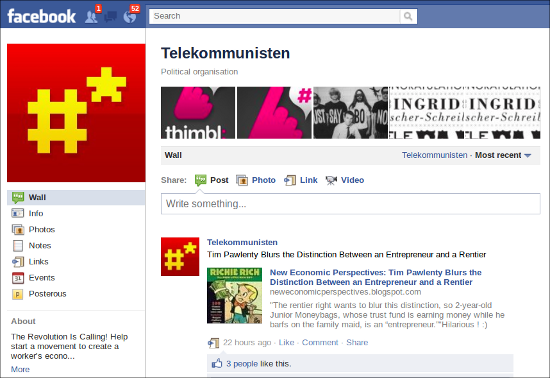
If I wanted to reach people and share information, I needed to do so on the technologies that others are using, which are not necessarily the ones I would prefer they use.
My criticism of Facebook and other sites is not they are not useful, it is rather that they are private, centralized, proprietary platforms. Also, simply abstaining from Facebook in the name of my own media purity is not something that I’m interested in, I don’t see capitalism as a consumer choice, I’m more interested in the condition of the masses, than my own consumer correctness. In the end it’s clear that criticizing platforms like Facebook today means using those platforms. Thus, I became a user and set up the Telekommunisten page. Unsurprisingly, it’s been quite successful for us, and reaches a lot more people than our other channels, such as our websites, mailing lists, etc. Hopefully it will also help us promote new decentralized channels as well, as they become viable.
MG: So, I downloaded deadSwap (http://deadSwap.net) which I intend to explore and use. On the site it says “The Internet is dead. In order to evade the flying monkeys of capitalist control, peer communication can only abandon the Internet for the dark alleys of covert operations. Peer-to-peer is now driven offline and can only survive in clandestine cells.” Could you explain the project? And are people using it as we speak?
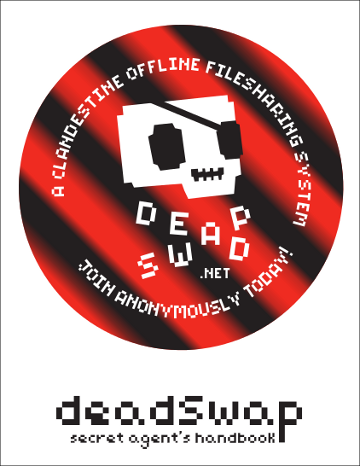
DK: I have no idea if people are using it, I am currently not running a network.
Like thimbl, deadSwap is an artwork. Unlike thimbl, which has the seeds of a viable platform within it, deadSwap is pure parody.
It was developed for the 2009 Sousveillance Conference, The Art of Inverse Surveillance, at Aarhus University. deadSwap is a distopian urban game where participants play secret agents sharing information on usb memory sticks by hiding them in secret locations or otherwise covertly exchanging them, communicating through an anonymizing SMS gateway. It is a parody of the “hacker elite” reaction to Internet enclosure, the promotion of the idea that new covert technologies will defeat attempts to censor the Internet, and we can simply outsmart and outmaneuver those who own and control our communications systems with clandestine technologies. This approach often rejects any class analysis out-of-hand, firmly believing in the power of us hackers to overcome state and corporate repressions. Though very simple in principal, deadSwap is actually very hard to use, as the handbook says “The success of the network depends on the competence and diligence of the participants” and “Becoming a super-spy isn’t easy.”
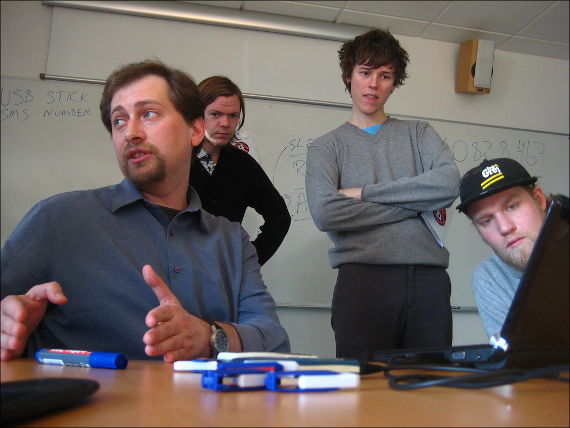
MG: What other services/platforms/projects does the Telekommunisten collective offer the explorative and imaginative, social hacker to join and collaborate with?
DK: We provide hosting services which are used by individuals and small organizations, especially by artists, http://trick.ca, electronic newsletter hosting (http://www.freshsent.info) and a long distance calling service (http://www.dialstation.com). We can often be found on IRC in#telnik in freenode. Thimbl will probably be a major focus for us, and anybody that wants to join the project is more than welcome, we have a community board to co-ordinate this which can be found here: http://www.thimbl.net/community.html
For those that want to follow my personal updates but don’t want don’t use any social media, most of my updates also go here: http://dmytri.info
Thank you for a fascintaing conversation Dmytri,
Thank you Marc 🙂
=============================<snip>
Top Quote: THE::CYBER.COM/MUNIST::MANIFESTO by Richard Barbrook. http://www.imaginaryfutures.net/2007/04/18/by-richard-barbrook/
The Foundation for P2P Alternatives proposes to be a meeting place for those who can broadly agree with the following propositions, which are also argued in the essay or book in progress, P2P and Human Evolution. http://blog.p2pfoundation.net
In the essay ‘Imagine there is no copyright and no cultural conglomerates too…” by Joost Smiers and Marieke van Schijndel, they say “Once a work has appeared or been played, then we should have the right to change it, in other words to respond, to remix, and not only so many years after the event that the copyright has expired. The democratic debate, including on the cutting edge of artistic forms of expression, should take place here and now and not once it has lost it relevance.”
Issue no. 4 Joost Smiers & Marieke van Schijndel, Imagine there are is no copyright and no cultural conglomorates too… Better for artists, diversity and the economy / an essay. colophon: Authors: Joost Smiers and Marieke van Schijndel, Translation from Dutch: Rosalind Buck, Design: Katja van Stiphout. Printer: ‘Print on Demand’. Publisher: Institute of Network Cultures, Amsterdam 2009. ISBN: 978-90-78146-09-4.
http://networkcultures.org/wpmu/theoryondemand/titles/no04-imagine-there-are-is-no-copyright-and-no-cultural-conglomorates-too/
“Festival of Ideas For A New City” organized by the New Museum, The Architectural League, The Bowery Poetry Club, C-Lab, Columbia University Center for Architecture, Cooper Union, The Drawing Center, NYU Wagner, PARC Foundation, Storefront for Art and Architecture, and the Swiss Institute blossomed like spring in New York City from May 4 – 8th, setting out to “harness the power of the creative community to imagine the future city and explore the ideas destined to shape it.”
Keynotes addressing the issues were architect Rem Koolhaas, virtual reality inventor Jaron Lanier, and former President of the National University of Columbia, and former Mayor of Bogota, Antanas Mockus. A StreetFest set up along the Bowery with over 100 local grassroots organizations and small businesses “presenting model practices and products in a unique environment.” Over 100 projects, events, performances and walking tours expanded on the Festival’s themes.
Rem Koolhaas with OMA and The New Museum showcased CRONOCAOS, an exhibit examining the growing “empire” of preservation and destruction and the consequences of how we build, rebuild and remember. What is the role of preservation on the art world? As larger and larger spaces are repurposed for art from industrial spaces they focus on the “apocalyptic sublime,” mimicking Hollywood and B movies. Oddly enough Koolhaas noted, this increase in preservation closely parallels the rise of Wall Street and tourism.

There were panels on “The Heterogeneous City,” “The Networked City,” “The Reconfigured City,” and “The Sustainable City.” At night curator Anna Muessig’s Flash:Light Nuit Blanche event included murals along the Bowery, art projections on Nolita and Lower East Side buildings, and music and performances including projects on the facade of the New Museum and St. Patrick’s Old Cathedral in Little Italy. There was also a 3D video installation Civilization reinterpreting Dante’s Diving comedy.
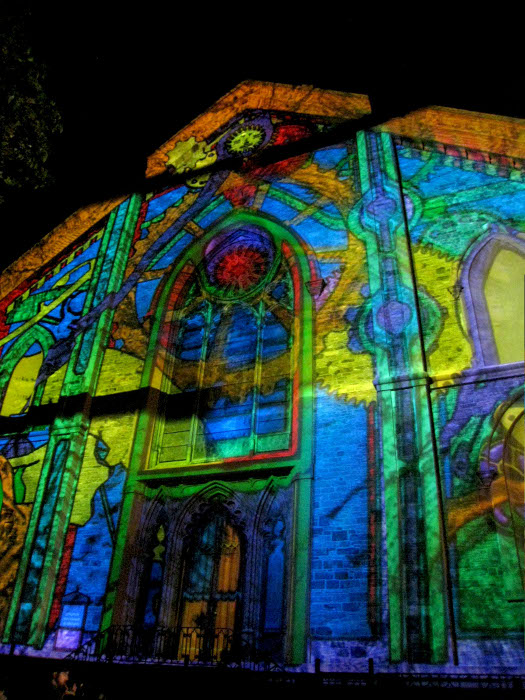

Jaron Lanier’s Keynote address on “The Networked City” at the Great Hall at Cooper Union reiterated many of the themes in his new book, “You Are Not A Gadget.” Not one to follow any set path, Lanier began his talk by playing a Laoitian “Ban Lao” (Ban Bang Sai Kai) bamboo wood pipe. He declared the simple reed flute was one of the first holders of digital information, even older than the abacus, because each reed object and note is turned on and off just like a series of digital 0’s and 1’s. The Ban Lao, traded across the Silk Route was noticed by the Greeks and Romans, and influenced the development of the pipe organ. The pipe organ was automated and turned into a player piano, a programmable loom, and finally became the origins of Charles Babbage’s computer.
Computers have gotten better Lanier explained, processing more and more bits, but humans still have more precise acuity at the level of quantum physics. They can respond to just one photon. He then veered off topic discussing the first computer scientist Alan Turing who used computers to crack codes during World War II. Persecuted for being gay, he was injected by authorities with female hormones which gave him breasts and made him suicidal. Just like Snow White, he killed himself by eating a poisoned apple.
He then veered back on track saying using computers as metaphors to the human condition is an irrelevant, outdated metaphor. The brain is not a CPU, and eyes and ears are not USBs. A better metaphor is thinking of the head as a spy submarine performing spy missions. You are constantly moving your head seeking out data, not passively seeing it. Your visual system is sensitive to minute differences. A musical instrument is an additional instrument to the sensory motor loop that makes perception possible. Can we build digital tools that are as sensitive as we are? This, he noted, was one of the key questions now facing computer scientists.
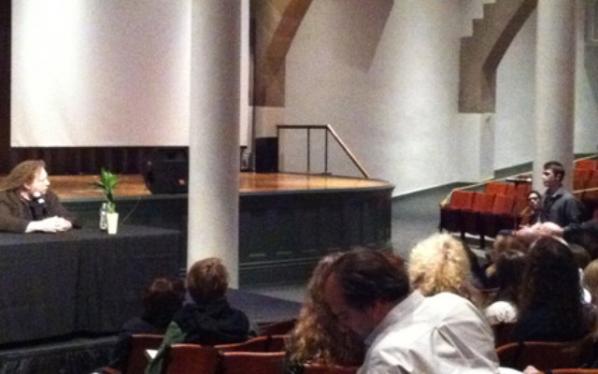
New technologies are usually developed to become weapons. But many important inventions were first developed for music. Musical bows existed before arrows, and guns developed from the casting of metal bells. Even Hewlett Packard’s first object was a musical synthesizer. Music is a driver with innovation taking place around making sounds.
In order to make his lecture relevant to the “Networked City” theme of the festival, Lanier discussed his favourite thing about New York City, that the same sense of acuity as applied to musical instruments also applies to personal interactions. More diversity means you have more chance of connecting with someone who will change your life. The fates of people in New York are guided by their activities. Its important that the fates concern an extra world of human to human contact.
In such a huge network context people are sensitive to subtle motions in each other, and can identify subconscious communication we don’t really know about. Contrast that to sound networking, where digital music does not give you the subtle minute accuracy of acoustic sound. People who only communicate virtually are spinning their wheels in place. When we connect to each other through digital representations we lose some form of expression.
Lanier proselytized for the necessity of the “head and the heart”, insisted technology needs to bring better jobs to society than the ones they are destroying. The basic social contract he said was turned back 11 years ago when advertising became the new way to get information. Sergey Brin, the co-founder of Google was the one who started it. Because digital technology is cheaper, cheaper just gives this stuff away for advertising. But, when you take the products of people’s hearts and minds, such as their music and literature, and give them away for free this becomes a problem. When you put effort into a promotion on line you get the illusion of benefits, but you actually lose relative advantage. This is because the true customers of a social networking site like Facebook is not you, you are actually the product of Facebook. You are sold and the customer pays to influence events. This is the difference between overt and covert information with Lanier stating, “The official business of computation is advertising.” At some point though, there is nothing to advertise. If cars can drive themselves, what happens to truck drivers? Or if 3D machines make fabrications they make manufacturing obsolete.
The Japanese are creating elder care robots. We are making ourselves unemployed. The fashion of making everything free leads us down a path from a city of dreams to a cry of despair. We have to figure out a way to change our relationship to information technology, instead of chasing after users and followers and making more money. Ending his lecture he declared, “We must humanize digital architecture – We must see beyond fads.” And then he played a little ditty on dual Gypsy flutes.
Featured image: Healing Station. mixed media, interactive installation, size variable. Christy Matson and Jon Brumit, 2009.
The New Materiality: Digital Dialogues at the Boundaries of Contemporary Craft.
March 10–June 12, 2011
Decorative Arts Gallery
http://www.mam.org/exhibitions/details/new-materiality.php
For the first half of the 20th century, curator Fo Wilson reminds us, the practice of craft was heralded as a “remedy” to how human values were changed by the Industrial Age. Here the hand-made was given privileged status over the machine-made, and thus craft forms gifted new value through the artisan. In the latter part of the last century, as the world moved from apprenticeship and artisanship to a more intellectual and theoretical-based framework for valuing contemporary art, so too have craft practices and discourses been challenged. This rethinking of craft has accelerated in the last several years, with books like Glenn Adamson’s Thinking Through Craft and Howard Risatti’s A New Theory of Craft (both 2007), both arguing for conceptual rigor and provocative possibilities within craft as a discipline.
The New Materiality: Digital Dialogues at the Boundaries of Contemporary Craft, an exhibition that began at the Fuller Craft Museum and is currently up at the Milwaukee Art Museum (MAM) until June 12, follows on and extends current trends in contemporary craft. It engages not only with craft’s reinvigoration as a creative practice and discourse, but with how these have been shaped by, and also transformed, new technologies, new designs, new materials and new ideas. Wilson’s exhibition and events make discussions around Art or Craft, Art or Design, Digital or Hand-made, and Conceptual or not seem, in a word, quaint; she engages with a broad set of materialized ideas that divide and relate across the artistry of craft, the ephemera of technology, and the theoretical frames of post-conceptual art.
The exhibition can perhaps best be summarized through the work of the four exhibiting artists/artist teams that spoke at the “Dialogues on Innovation” panel at the Milwaukee Art Museum on April 16th. Collaborative artists Donald Fortescue and Lawrence LaBianca, for example, spoke to Milwaukee activist and printmaker Nicholas Lampert about their piece, Sounding. This work consists of a huge, custom built cabriole-legged table, which was initially filled with beach rocks and sunk to the bottom of the ocean. There it lay, for two months, with a hydrophone to record the ambient sounds of the sea, including the overwhelming swish of waves, the low hum of slow-moving current, and the activity of sea life – the most prominent being the continuous clicks of what must be shrimp in its vicinity. When the artists’ creation reemerged, it brought the bottom of the ocean with it: all the messiness and stink and poetry of the sea – barnacles, rusty parts, plant life, fish scents, mystery and more. It is exhibited with an over sized hornlike funnel, a huge phonograph tied together with zip ties, to amplify the recorded sound.
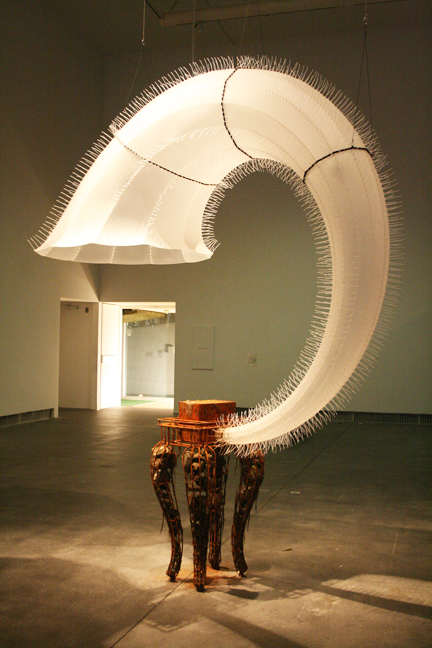
Sounding, avowedly inspired by Captain Ahab’s hunt for an un-killable whale, acts as a kind of parallel to the ongoing hunt for singular disciplinary focus in craft. The piece dives into the sea, hits “rock bottom,” and looks as if it barely survived; and on its return, we see that Sounding is far from a singular entity. Yes, it is trashed and torn, but it’s also imbued with literal life, entwined with technical innovation, and rich with stories of its journeys. Like the theories and practices behind the current craft movements, it came back more beautiful, more visceral, more sensory, and more technological than it ever was: a new materiality.
You can listen to or download Sounding file here:
http://www.furtherfield.org/audio/Soundings-1.mp3
My discussion with artist Christy Matson revealed an exploratory practice that shifts between digital and hand-made, generative and interactive, and always with an eye towards the implications of each. Soundw(e)ave, her piece on show, is a self-referential textile, where the actual sounds of computerized Jacquard looms were used to create woven compositions. Her noisy sound waves were turned into three patterned pieces of fabric, made by hand-operated, computer-assisted and fully automated (Jacquard) looms, respectively – each weave growing progressively denser with the more advanced technologies used in their production. The piece, says Matson, was a huge turning point in her practice; it pointed her towards a kind of digital craftsmanship, where she was better able to place value on the ideas, materials and skillfulness needed to be an artisan across contemporary digital, craft and art domains.

Soundw(e)ave, generative weaves, triptych (each 34″ x 54″). Christy Matson, 2004.
For example, Matson then began weaving copper wire directly into her fabrics, and, using the magnetic waves our interactions generate and alter, engendered new aural compositions. In other words, her sonic sculpture turns cloth into a Theremin, where movement and hand-waving at the gallery are transformed into the kinds of musical gestures often associated with science-fiction films of the seventies. While Matson’s earlier, sound-generated works were generative and performative on some level, here she moves into real-time interaction, invoking our embodied relations to textiles, craft, technology and language, all in one fell swoop.
healing station, a collaboration with Jon Brumit and quite possibly the most complex of Matson’s installations thus far, sees piezo sensors placed inside of swaths of fabric to pick up the ambient sounds of the room – including gallery-goers, passersby, street sounds, and the minute vibrations in the fabric itself. This lovely noise is then fed back into the space with bass shakers: speakers optimized for sending waves into solid media rather than air. Viewers can literally feel the low hum of presence, absence and movement as the textile, bodies and room speak at and to one another in a perpetual feedback loop of embodied music. The small crowd at the MAM laughed along with Matson when she relayed a story in which her wired-up piece, and its feedback, caused a small fire at one of its showings – quite a performance, indeed.
Tim Tate artfully explained to Milwaukee staple Tom Bamberger that nowadays “craft” is a starting point rather than an end point. I’m paraphrasing here, but he treats craft as an approach, a space of understanding materials, what they’re good at, perhaps their “habits,” and most certainly their implications. Here, narrative, function and the conceptual are always already implicated across technique – whether new or old – and value is derived from a contextual corpus.
Tate’s work is itself a beautifully resolved hodgepodge of hand-blown glass, hi-tech LCD screens, and visceral videos of typewriters and books, all literally tied together with plastic (zip ties again – don’t knock it ‘til you try it!) around a printed circuit board. In Virtual Novelist, for example, miniature monitors display the aforementioned “dead media” tools from behind artefactual casings of glass. Atop are beguiling sculptural homages to each of the gone-but-not-forgotten analog recording devices of yesteryear.
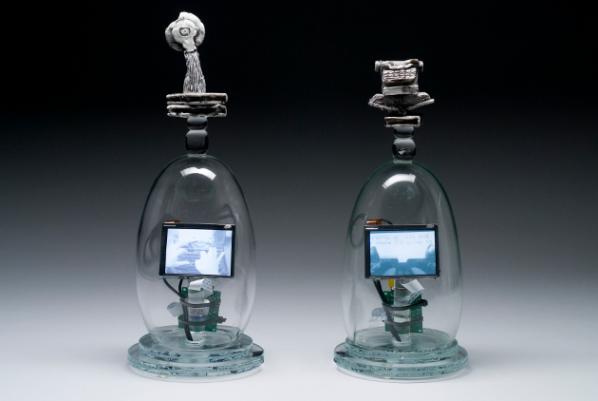
Bamberger is a smart artist with a quick wit, and Tate is similarly not one to spar with unless you have a good grasp of the discourses at hand. In this lively thirty-minute discussion, the two managed to disarm the Art vs Craft debate as both unproductive and long-since over, and open up possibilities for “ornamental aesthetics” in time-based media. Here the implication was that, following Tate’s lead, video objects and installations could place more emphasis on the object and installation – rather than the video – and use each as an equal material that informs and plays off of the other; the video and screen need not be the central focus.
Sonya Clark then told us how she views her practice as a fiber artist as similar to how author Toni Morrison views her own writing practices. In one of her essays (found in several publications, including a collection entitled What Moves at the Margin), the latter tells a story of the Mississippi River, which was laboriously straightened for travel and transport by boat. Every so often, the river floods; but, Morrison goes on, it’s not really flooding. It is remembering. The water is trying to get to where it belongs, to re-member, to embody again. Morrison says writers do the same with their texts; and Clark claims that she remembers through her materials. Originally trained as a fiber artist and now working across found objects, digital art and more, Clark’s practice sees her reclaiming forgotten histories, and giving them greater potency through her processes and media.
Clark discussed this approach with longtime friend and former colleague, UW-Madison Professor Henry J. Drewal – one of the foremost thinkers surrounding African Art. Clark’s brilliant work on the exhibition, a portrait of Madam CJ Walker, is constructed entirely out of small, acrylic and thin toothed, black hair combs. She overlays the combs and removes some of their teeth to make a huge, grayscale, and literally bit-mapped image.
Madam Walker, the first ever female millionaire in America (and African American to boot), made her fortune selling beauty products to black women hoping to straighten their hair – as was the fashion of the time. And so Clark utilizes her combs, with their own memory, narrative and political weight, to construct a lo-resolution digital image. This exceptional work manages to explicitly straddle issues of race, gender, class, memory and materiality on its very tactile surface, and implicitly engage with the contemporary conceptual frames of digital art and data, in its transcoding of the image from one form to another, and craft, in the final material and hand-made form it takes.
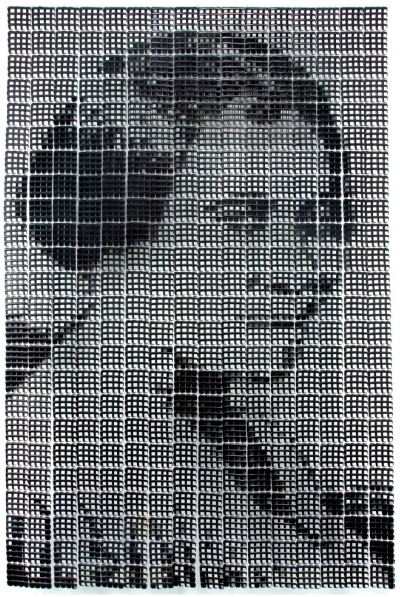
Clark finished with the generous idea that, at present, all art work is collaborative in that it fits into broad social and cultural contexts, builds on extant technologies, and is produced, received, and engaged with outside of the individual’s studio. And Drewal concluded by declaring that technology has always been at center of the arts in the form of new techniques. When something comes into the world, he went on, whether technical or formal or as an image, artists take it someplace else. They “turn common objects… into uncommon things, stretching our imagination and the world” along with them.
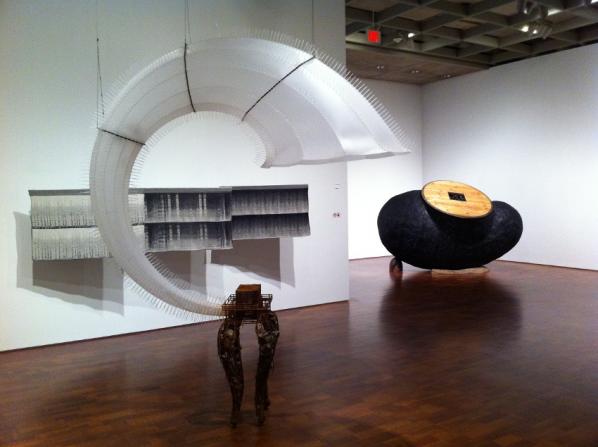
These are just a handful of the works in The New Materiality, by four of the artists represented in our discussions – not even all the works they contributed, much less those of the other artists, which include Brian Boldon, Shaun Bullens, Lia Cook, E.G. Crichton, Maaike Evers, Wendy Maruyama, Cat Mazza, Nathalie Miebach, Mike Simonian, Susan Working, and Mark Zirpel.
It is a show that, in its entirety, succeeds in stretching our imagination, through its expansion of craft, art and digital forms, and what they individually and collectively mean today.
Nathaniel Stern (USA / South Africa) is an experimental installation and video artist, net.artist, printmaker and writer. He has produced and collaborated on projects ranging from interactive and immersive environments, mixed reality art and multimedia physical theatre performances, to digital and traditional printmaking, concrete sculpture and slam poetry http://nathanielstern.com.
‘Made Real’, an exhibition by Scott Kildall and Nathaniel Stern, the founders of Wikipedia Art. Can be seen at Furtherfield’s Gallery from 27th May 2011 http://www.furtherfield.org/exhibition/made-real
Featured image: Radion at NetAudio London festival 2011.
NetAudio London Festival, 13th – 15th May 2011.
A three day festival that explores music environments in the digital age of networked technologies. http://www.netaudiolondon.org/
Marc Garrett interviews Andi Studer of NetAudio London, about their latest Festival at the Roundhouse and other venues in London, from Friday 13th – 15th May 2011. Showcasing work of artists who use digital and network technologies to explore new boundaries in music and sonic art, their festivals encourage participation in all forms: interactive sound art installations, conferences, workshops, collaborative online broadcasting and headline shows. This year promises to be a special event, headlined by the legendary Nurse With Wound and many more – read on.
Marc Garrett: This seems like an amazing festival. Not just because it’s context relates to my own background and Furtherfield’s own connected communities and its history in exploring an engagement of contemporary, networked creativity which was once perhaps, considered to be at the edge of art. But now, it does seem as if a new passion is alive and kicking, representing what exists across the genres of art, technology and social change.
The Netaudio London festival began its life in 2006, why did you chose to set up such a dynamic and involving festival, and who are your influences?
Andi Studer: The first Netaudio London grew out of a general passion for electronic music, combined with the recognition of a booming netlabel scene distributing new music with CC licenses for free download. Culturally it spanned the three fields of club culture, avant-garde music and net-politics. During the research phase, we came across of string of European festival projects with the same scope and decided to align with them, so after Netaudio Berne and Cologne, in 2005, London took it’s turn in 2006. Over 3 days we presented more than forty acts in club as well as gig settings; we hosted cultural discussions, organised a knowledge fair around digital music distribution and premiered an the audio installation by Si_COMM, S.E.T.I and N-Spaces… good old days!
MG: What do you feel is important about the Netaudio festival and how does the current one relate to contemporary culture?
AS: Netaudio aims to play an active role in the ongoing process of exploring how technologies, and particularly the Internet, shape our lives. Within this vast field, we focus our work on sonic culture, music and sound art, but reach out to wider aspects such as politics and protest or collaborative creativity.
Whereas in 2005/06 much of the cultural discussion was driven by an incredible optimism about new communication and distribution channels, this year’s festival may pick up on something best described as ‘cyber realism’. The festival, and particularly the conference, building on our 2010 research project, presents a strong case for individuals taking action. And in process of so doing, we are interested to explore what emerging digital tools they use to create new sound art/music, as well as in the social and political endeavours related to their creative work.
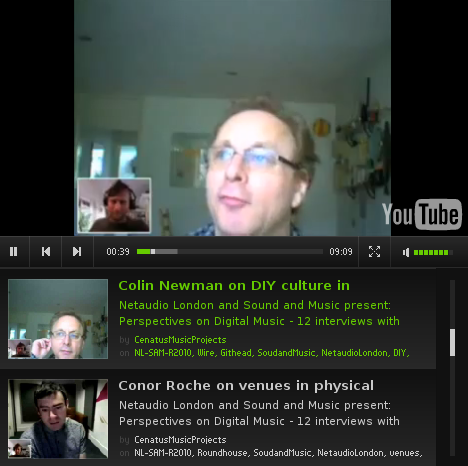
MG: Why chose to include those who have a history in net art, critically engaged thinkers invlolved in networked culture, and many who have been and are part of the (new) media art generation?
AS: We recognise a continuation of creative and socially aware work, enabled by network technologies. Including emerging as well as established projects, some dating from well before the WWW time, allows us to show this continuation and hopefully furthers the wider understanding of these different elements/groups. Whilst there are clear differences between them, there are also many overlaps and we hope that the inclusion of as many as possible in the debate and the wider festival allows for an exploration and greater understanding of these overlaps, and differences.
MG: Your festival includes a visiting member from UK Uncut who will be discussing with others at the Conference and Workshops, regarding the proposed theme of ‘politics and protest; creativity and collaboration; digital futures and analogue survivals.’ They have made headline news regarding their activities challenging the government’s ongoing cuts, and have been actively involved across the country targeting corporate tax dodgers and the banks who caused the financial crisis.
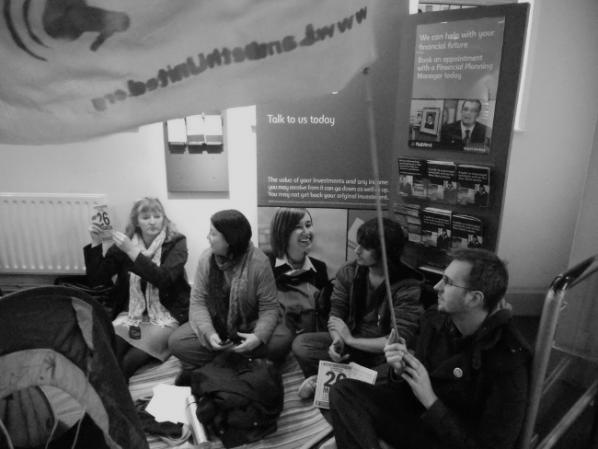
Do you think that UK Uncut’s own perceptions and its activism reflect the festival audience’s general interests and feelings on the matter, across the board?
AS: The participation of UK Uncut is confirmed, but the speaker is to be announced. Whilst some festival audience members may be sympathetic with UK Uncut’s perceptions and activism, others may not. Similarly, whilst members of the festival programming board may have sympathies with UK Uncut’s cause, the festival as such does not necessarily share the same cause with UK Uncut. The reason for inviting UK Uncut was their very successful work as a technology savvy protest movement, as well as their exploration of new forms of protest, particularly sit-ins involving poetry readings and the singing of songs. We are interested to find out more about how they use technology and music/sound in their cause. Presented in a panel with Jeremy Gilbert, Mark Fisher and Anthony Iles, we hope to show how their work sits within the incredible role music had and continues to have in social, political and economic protest.
MG: Nurse With Wound is headlining the festival and they are legendary in the underground music scene. Spanning a career of 30 years plus, under the curatorial guide of Stapleton who has seen NWW collaborate with a highly respected troop of free thinkers including David Tibet (Current 93), William Bennett (Whitehouse) and Andrew McKenzie (Hafler Trio). Many artists who have been working with technology and similar experimental genres, are influenced by those of industrial and avant garde music scene, such as Throbbing Gristle, Cabaret Voltaire, Virgin Prunes, This Heat and NWW, so it seems fitting to have them in the festival, with their peers and of course, an equally interesting selection of younger sound artists and musical explorers.
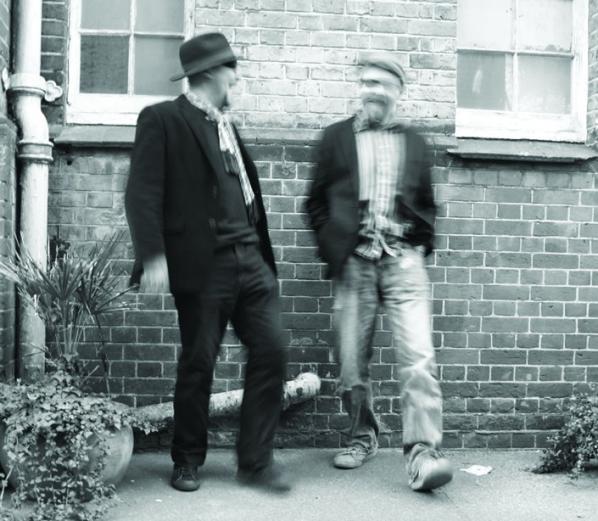
It may say seem like the perfect decision now, but how did you come to the idea of asking Nurse With Wound and what are the links with the other aspects of the festival?
AS: To have Nurse With Wound headlining our festival is a dream come true. Their achievements in anarchic, experimental, DIY, post-industrial music is unparalleled, and it is possible to find many of their approaches in the current new music produced by emerging musicians. This is something we hope to draw on in the rest of the festival.
At KOKO we will also present a newly commissioned live collaboration between Bruce Gilbert (ex-Wire) and Mika Vainio (ex-Pan Sonic). This opportunity to present new work came about though the direct continuation of an ongoing enquiry into collaborative creativity, as featured on one of the three conference panels. This is definitely also a strong theme in the work of Radian, the opening act at KOKO.
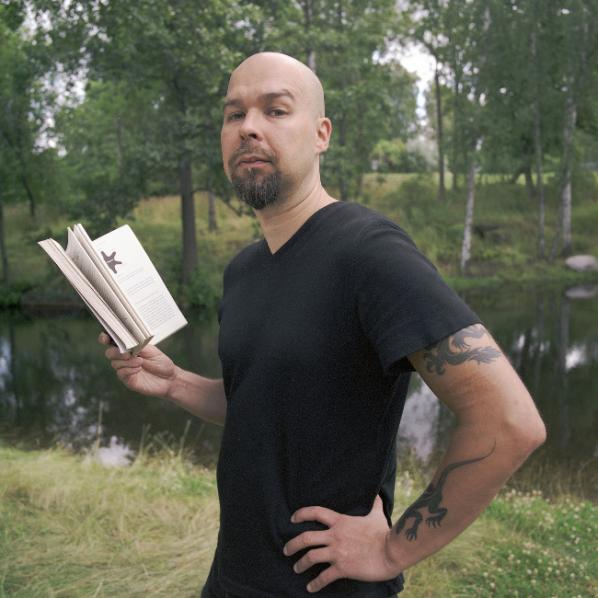
I’d urge anyone who is coming to see NWW at KOKO, to join us at the Roundhouse for the afternoon programme, particularly the conference, but also with the Open Platform stage, we hope to showcase some glimpses of the NWW legacy.
It may be worth mentioning the broadcast strand of the festival here too. Enabled by the Roundhouse Studio facilities and with creative input from Ed Baxter of Resonance104.4fm we are able to feed the festival back to the online domain for the first time. Throughout the afternoon of the 15th May, we will present a live web-zine, thereby leading an enquiry into the future of broadcasting. As part of this we will present three new pieces of work by the commissioned artists: Stefan Blomeier, VHS HEAD, and Liliane Lijn, the latter presenting an online adaptation of her Power Game project.
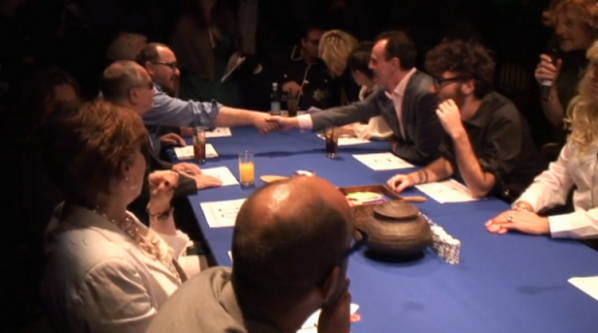
MG: This interesting development warrants investigation, not only because there is an an influx of new interest from a much larger informed and adventurous audience across the board but also because it represents an obvious, cultural dynamic at work. Reflecting a ‘real’ contemporary interest for something different to happen, beyond the remit of normative, art world restraints and its usual, hermetically sealed approaches. We will definitely be there ourselves. To experience what promises to be an engaging and critical conference, but also to explore and enjoy the other varied live events and projects.
The Conference – will bring together theorists, practitioners, activists and academics to address a challenging set of themes in 21st-century culture, featuring speakers including Matthew Herbert and Cecelia Wee: politics and protest; creativity and collaboration; digital futures and analogue survivals.
http://www.netaudiolondon.org/2011/strand/conference
Sound Art – In partnership with Call& Response Netaudio presents an event of 8-channel immersive audio-works. The dynamic and varied explorations of the nine prolific artists brought together by Call& Response highlights the vibrant and diverse field of contemporary sound art. Also there’s the Sonic Maze, an immersive series of sound art installations set in the Roundhouse Studios. http://www.netaudiolondon.org/2011/strand/sound-art
Broadcast – Using the format of a live webzine, Netaudio Broadcast will explore the future of broadcasting with a series of video and radio features. Netaudio Broadcast is co-curated with Ed Baxter of Resonance104.4fm. http://www.netaudiolondon.org/2011/strand/broadcast
Live Music – Starting at cafe OTO on 13th with Robert Piotrowicz (http://www.myspace.com/robertpiotrowicz) and Valerio Tricoli, continuing at Apiary with the runsounds hosted late night event; and the main live show of the festival, a rare live appearance from Steve Stapleton’s Nurse With Wound (http://en.wikipedia.org/wiki/Nurse_with_Wound), a special commission performance by Bruce Gilbert (ex-Wire) and Mika Vainio (ex-Pan Sonic) and Radian.
The 2011 Netaudio London festival supported by the National Lottery through Arts Council England and by the Austrian Cultural Forum London. It is presented in partnership with The Wire, ResonanceFM and Last.fm and supported by the Roundhouse and many more.
“Does Lara Croft Wear Fake Polygons?” that was the question Anne-Marie Schleiner (http://www.opensorcery.net) asked in a gender analysis essay of the popular videogame Tomb Raider published year 2000 in the Switch magazine.
The videogame Tomb Raider was released by Core Design in 1996 and the heroine a British archaeologist named Lara Croft did not only have big guns but also big breasts. In a couple of years she became a well known character not only in the games world but also for the general public when she entered the silvercreen, played by Angelina Jolie. You could say that Lara Croft is the Mona Lisa of the game world, beautiful, mysterious and well known for a large audience outside the games world.
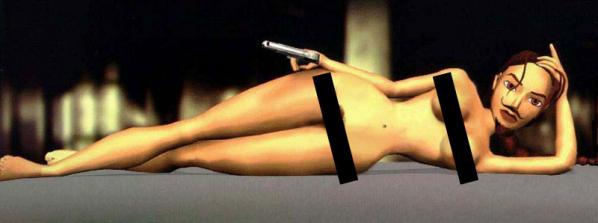
In her essay Anne-Marie Schleiner mentions the famous Nuderaider patch, a game add-on that strips Lara Croft’s clothing so you could play her naked.
The artist Robert Nideffer’s Nuderaider patch made in 1999 consisted of three-parts:
1) an appropriated website where he repurposed the existing commercial site
2) a spoofed mail-server that re-routed messages submit to Lara Croft fan club website to the Director of development at Eidos UK as if it were coming from the Director of Marketing in the US branch
3) a patched version of the Nude Raider patch, which placed police blotter style bar codes across Lara’s private parts (and gave her a goatee as a Duchampian homage), thwarting the game player’s expectation of seeing her polygonal private parts.
“This shows the male dominancy within the game world by having a female lead appearing like a super model. By presenting her naked, it makes the game seem satirical just pushing the creators’ ideas a little further.” Nideffer [2]
In 1919 the artist Marcel Duchamp used a cheap postcard-sized reproduction of Leonardo da Vincis famous painting Mona Lisa on which he drew a moustache and a goatee, in the same way Nideffer later did with Lara Croft. Duchamp called his work L.H.O.O.Q a titled that pronounced in French should be “Elle a chaud au cul”, which translated to English means “She has a hot ass”.
Eidos sent cease and desist letters to the owners of nuderaider.com who were hosting the Nude Raider patch, enforcing their copyright of Tomb Raider.[3]
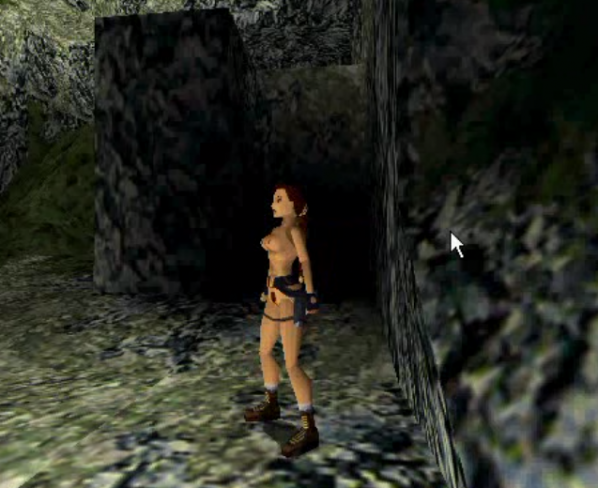
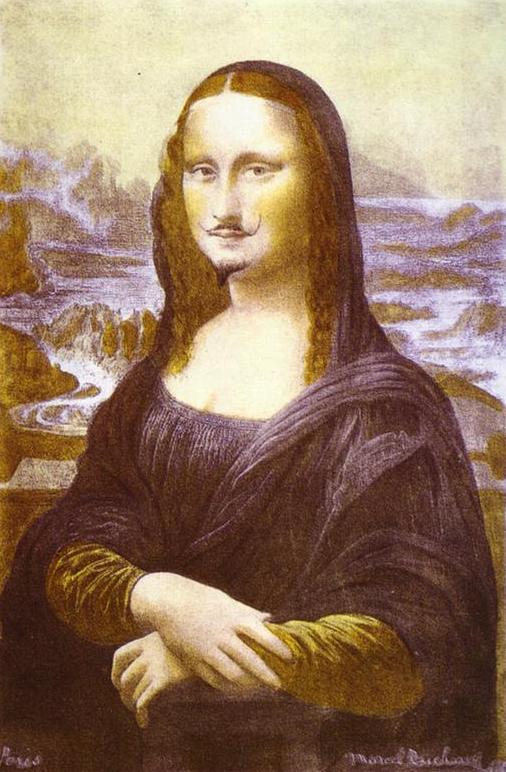
In the machinima “She Puppet” from 2001, the American artist Peggy Aswesh also investigates the gender and cultural identities of Lara Croft by mixing scenes from the Tomb Raider game. Aswesh describes Croft as a virtual girl-doll of the late 20th century, perhaps boy-doll would be a better description since most of the player of the early Tomb Raider games were men or boys. In her essay Schleiner makes the observation that Lara Croft is a “well-trained techno-puppet created by and for the male gaze.” It’s obvious that the videogame Tomb Raider has played a major role in stirring up emotions with its out of date and suspect attitude towards women. But Lara Croft has not only been a subject for critically engaged, artistic gender discussions.
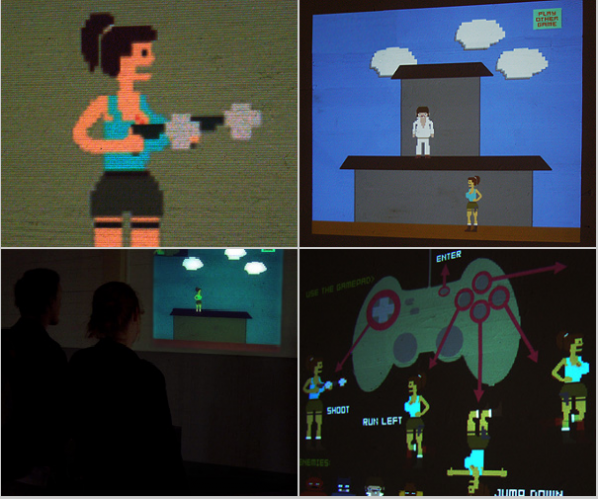
The artists Marieke Verbiesen has created the game Tombraider 0.1 in which she flattened the 3D game into a 2D-world and borrowed aesthetic from the early game consoles. In the new game you could also find references to classic computer gaming experiences such as the stuck “loading” screen, bad language translations and space-invader attacks. It is not unusually that artist create copies of videogames, with 3D hyperrealism graphic, in a retro old-fashioned style.
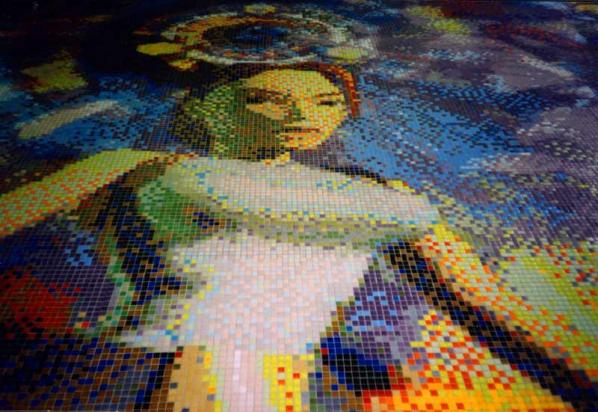
Another way to do this is to use pixel-graphic. That is exactly what Arno Coenen, Rob Coenen and, Rene Bosma did when they re-created he 3D game character into a 2D experience with a touch of pixel-feeling. The project Output: 62.500 materialized pixels, used 62.500 pieces to create a floor mosaic measuring 5,25 x 5,25 meters of the videogame icon Lara Croft. The mosaic has been exhibited at different places in Amsterdam and Kiasma at the Alien Intelligence exhibition in 2000.
So fake polygons or not, it looks like Lara Croft has not only made an impression in the history of videogames but also in the history of art.
Tombraider 0.1 – Single-player game installation based on the famous 3d game Tombraider, starring the female fightingmachine Lara Croft. http://www.marieke.nu/tombraider01/eng/
MUTATION.FEM. Anne-Marie Schleiner “An Underworld Game Patch Router to Female Monsters, Frag Queens and Bobs whose first name is Betty” http://www.opensorcery.net/mutation/
Featured image: Nightingale’s Playground Chapter Selection
Andy Campbell is a UK writer who has been experimenting with new media fiction since the 1990s, when he started creating stories on floppy disc for the Commodore Amiga. By 2000, when I first came across him, he was working mainly in Flash and self-publishing the results on a website called “Digital Fiction”. He has continued to produce one or two pieces of work per year ever since, latterly on a site called “Dreaming Methods”. His output is invariably enigmatic, complex, densely-textured, dark in tone and technically highly-accomplished; and he has gradually established himself, certainly amongst his peers, as one of the leading exponents of the digital fiction form.
His most recent work is also his biggest and most ambitious to date. Entitled Nightingale’s Playground, it consists of four interlinked parts: a click-and-read interactive story; a 3D “game”, which involves exploring a dark flat; a virtual exercise-book, the pages of which can be turned by dragging them across the screen with your mouse; and an ebook text narrative, written in short fragments.
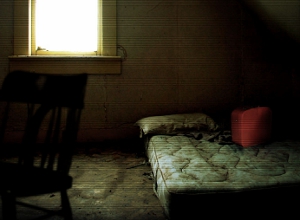
The story, put simply, goes like this. In “Consensus Trance” (the click-and-read interactive section), the adult Carl has just broken up with his girlfriend. The one item he carries away from the breakup is an old red vanity case belonging to his Gran, with whom he used to live when he was a boy. The case contains bits of talismanic bric-a-brac dating back to Carl’s schooldays. Partly because the contents of the case have jogged his memories, Carl attends a school reunion in the hope of catching up with his best schoolfriend, Alex Nightingale. But Alex isn’t there – and furthermore nobody else can remember him. Carl remembers that Alex disappeared unaccountably while he was still at school. He begins to wonder whether Alex actually existed at all, or whether he imagined him; but at the same time he starts to feel as if “ordinary life” might be the illusion, and Alex might have disappeared because he somehow managed to get through to a further reality. He goes back to revisit the flat where Alex used to live.
“Consensus Trance II” picks up from inside the flat’s front door. It takes the form of a 3D “game”, in which we must walk through the passages and rooms of a half-dark flat, discovering fragments of white text as we go, and unlocking extra sections of the flat once a certain number of texts have been discovered. The text-fragments reprise parts of the story which can be found elsewhere, but they also develop the theme that Alex may have disappeared because he managed to get beyond the illusion of everyday life, along with a suggestion that Carl and Alex may be figments of one another’s imagination (many of the text-fragments have Alex’s name in them at one moment and Carl’s at the next), and a third idea that Carl may not be able to remember what happened to Alex because it was something so terrible that he blocked it out of his mind. In the last room of the flat, which has to be unlocked by discovering and “walking through” all the text-fragments elsewhere, this suggestion becomes more concrete: Alex may have tested out his own theories about reality by drinking something poisonous, and therefore he may have disappeared because he killed himself. The process of exploring the half-dark flat thus becomes a metaphor for Carl’s exploration of his own repressed memories, and the fragmentary revelation which awaits us in the last room represents the moment in which he rediscovers his personal nightmare.
The third part of the story, “The Fieldwork Book”, is an old exercise book of Alex’s – or rather a virtual exercise book, apparently recently dug-up, complete with soil-stains, scribbly handwriting, comments in blue from the teacher, doodles, bits of leaf stuck to the pages with sellotape, and woodlice running around on the front cover. It contains the beginnings of a school project about nature – “A dead tree may look lifeless, but actually it’s teeming with activity…” – along with notes from Alex to Carl – “Worthington has paired me up with this mad girl called Joanne. She smokes and stinks but I quite like her.” – and a lot of press cuttings and comments about a computer-game called The Sentinel. All of this makes more sense once the other parts of “Nightingale’s Playground” have been visited, particularly the ebook, which gives a lot of background information about both the Fieldwork Book itself and the Sentinel.
One thing we learn from the ebook section of the story is that The Fieldwork Book is a kind of changeling. Carl buried his science exercise book in the back garden behind his gran’s flat, at Alex’s suggestion, as a way of making it look more grubby and out-of-doors, and thus suggesting to the science teacher that it had been used intensively in the development of the nature project. However, when he dug it up again after Alex’s disappearance, what he discovered was not his own exercise-book but one belonging to Alex.
Another thing we learn is that The Sentinel, to which the Fieldwork Book makes numerous references, is an old Commodore computer-game with which Alex was obsessed. It had 10,000 levels, all based on the same principle: that players had to approach an object called The Sentinel across mountainous terrain without being observed. If they were detected the game would be over. Carl never managed to get very far but Alex managed to get to level 9,999 – and in fact one possible explanation for his disappearance is that it may have had something to do with him reaching level 10,000. He and Carl also played their own outdoor version of The Sentinel, in which Carl would have to stand still while Alex attempted to creep up on him undetected. A copy of The Sentinel is one of the items of bric-a-brac which Carl the adult discovers in his Gran’s old red vanity case.
The ebook also gives some more information about the vanity case itself. When Carl retrieves the Fieldwork Book and finds it to be Alex’s version rather than his own, he hides it in his Gran’s sideboard, and whilst hiding it he discovers something else in there – the red vanity case. The story doesn’t actually tell us in so many words that he looks inside the case, but we gather he must have done, because later on he has a conversation with his Gran, who is telling him that the contents of the case are private and he mustn’t look in there again:
“But what’s that red case? What are those papers?”
“They’re nothing,” she said insistently. “They’re from a long time ago, they don’t make any sense and they’re private love, they’re just private.”
The papers may have something to do with Alex’s death. On the other hand, they may be connected with Carl’s mother, since this is one of the few times in the story when she gets a mention:
…[Gran said] there were things in the world, happenings, that she didn’t understand, and neither would I, and neither would anyone else, and sometimes it was best to just leave them alone.
“Like we leave Mum alone,” I murmured. She didn’t answer that, and looked a little hurt, so I whispered “sorry” and she started talking to me again…
These hints are never developed further.
Nightingale’s Playground is not without its shortcomings. Its most obvious structural weakness is that its four different sections are in four different formats, each with its own distinctive “look” in terms of graphic design, and each needing to be viewed and interacted with in a different way. This is asking a lot of any readers and viewers who are unfamiliar with new media, although it’s actually less of a problem than might be supposed. Once the initial leap of faith has been made the cross-references between the four sections soon start to pull the story together into a surprisingly cohesive single structure. All the same, the fact that two parts are designed to be viewed online, whereas the other two parts are designed to be downloaded onto your own computer (or ereader) does make it a little bit inconvenient to shuttle backwards and forwards between one section and another if you want to examine the story in detail.
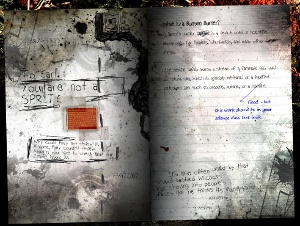
A more serious flaw is the fact that the Fieldwork Book doesn’t actually add very much to our sense of what’s going on. Pretty much all the information it contains (about the Sentinel, and Alex’s view of reality) can be garnered from the other sections, and although reading the Fieldwork Book gives us a slightly stronger sense of Alex’s personality and voice, the material in it begins to seem rather like padding on repeated viewing. There is a similar problem with the red vanity case, which is built up into something of great importance both in the point-and-click narrative section of the story and the ebook. When we actually get to see what’s inside the vanity case, halfway through the point-and-click section, the contents turn out to be rather disappointing.
Campbell does tend to talk up the importance of events and symbolic objects in his stories, rather than leave them to speak for themselves, which can sometimes backfire and lead to a sense of anticlimax. His prose-style can be overblown, a trait which is probably at its most noticeable in the “game” section of the story, where white texts either hang in the air or in some cases appear on the walls of the darkened flat. Some of these texts are particularly sonorous and doomy:
Where were we? Who were we? How much control did we have over the rain coming down, the hideous blank backdrop we were cut and pasted and glued against?
You were onto it, like you were onto something that meant all of this was wrong, some kind of mad illusion; that there was a staggering, amazing psychedelic hope going on that I desperately, weepingly wanted to understand.
I get the feeling everything changed then, like you said words to me that didn’t exist; a language that spoke the impossible; couldn’t be absorbed by the normal brain. Did you even invent some new words? Pierce a new crack in the fabric of what was going on in our limited, messed up world?
“The hideous blank backgrop”; “mad illusion”; “staggering, amazing psychedelic hope”; “desperately, weepingly wanted to understand”; “pierce a new crack in the fabric of what was going on” – the harder these phrases try to impress us, the less they succeed. The trouble is that there isn’t enough concrete observation or information here to convince us that the big emotive adjectives are justified. They seem to be flapping around in a vaccuum.
On the other hand, the ebook section of Nightingale’s Playground contains some of Campbell’s tightest and most effective writing:
Science was my best lesson because Alex was in it – science without Alex was a shitty prospect. I didn’t like any of the other kids in the class, I didn’t like the teacher, I didn’t like doing experiments or doing any work. Science for me was about swapping computer game cassettes under the table, scribbling rude shapes on Alex’s excercise book, whispering about whether the teachers were really aliens trying to brainwash us or whether the entire school was some kind of hologram that folded up and disappeared after the bell for hometime.
This is both convincing about the boredom of being a schoolkid in a dull lesson, and suggestive in terms of the story’s wider themes – the idea that “the entire school was some kind of hologram” clearly links to the alternative-reality theme. The ebook as a whole is written in short punchy sections jumbled into a non-linear sequence, shuttling us backwards and forwards through a term of so or Carl’s school memories, and unfolding (without ever fully explaining) the story of Alex’s disappearance. It works as a stand-alone, but it also works as the glue which holds the entire structure of Nightingale’s Playground together.
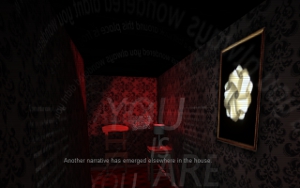
It should also be said that although the flat-exploring section of the story is sometimes overwritten, it is also the most thoroughly immersive of all four parts, and the one where Campbell’s characteristic approach to new media fiction comes into its own most strongly. He has always been at pains not to place his text in front of his images, or beneath them or to one side, like labels on tanks at the zoo or explanatory plaques next to pictures in a gallery; instead he puts his words inside his graphical environments, sometimes hidden or partially-hidden inside them, so that we have to explore to read. This avoids the danger of us regarding the texts as more important than the images. It pulls us in, and it makes his work inherently immersive and interactive.
This characteristic technique is taken a step further in the flat-exploring section of Nightingale’s Playground (which was built with gaming software called Coppercube 2.0), because here the three-dimensional space is deeper, more mazelike and more thoroughly-articulated than Campbell’s customary Flash environments. There is a sinister audio track which changes incrementally as we move from one part of the flat to another, enhancing our sense of three-dimensionality (the audio dimension of Campbell’s environments should not be overlooked in any of his work). The atmosphere is claustrophobic and scary. When you manage to find the right number of texts to unlock an extra section of the flat, there is a loud door-latch click which makes you jump even if you’re expecting it. When you get to the last room of the flat – the one where Carl is starting to get fragmentary recall of Alex’s possible suicide – the space is suddenly bigger, the predominant colour is red, there are items of furniture floating in the middle of the air, the far wall is decorated with a massive staring eye (an icon from the Sentinel game), the text-fragments tend to slide around in front of you as you approach them instead of staying still, and the whole effect is genuinely climactic and nightmarish. There can be no doubt that at moments like this Nightingale’s Playground is an extremely effective piece of new meda fiction.
It’s interesting to note how closely the climax of this flat-exploring sequence resembles Grandma’s house in Tale of Tales’ horror-game The Path. Campbell is an admirer of Tale of Tales’ work, but he hadn’t seen The Path prior to the completion of Nightingale’s Playground. All the same, the parallels are striking: the feeling of combined claustrophobia and disorientation, the sinister red-and-black colouring, the way the reader/viewer is barraged with suggestive fragments, and the way this technique is used to suggest flashbacks. There is a strong sexual theme in The Path which is not present in Nightingale’s Playground, but otherwise it’s difficult to escape the feeling that both Campbell and Tale of Tales have seized upon the exploration of a mazelike game-space as a metaphor for an inner journey, and have developed the metaphor in very similar ways.
Readers who are familiar with Campbell’s earlier work will recognise a number of the themes and motifs employed in Nightingale’s Playground. The Fieldwork Book, for example, is designed in very much the same way as an earlier virtual exercise book from a story called “The Scrapbook”; collections of fragmentary jottings, or old half-corrupted electronic files, can also be found in “Fractured”, “Floppy” and “The Incomplete”; the feverish boy being looked after by his Gran, with his mother either absent or not interested, is a familiar figure from “Dim O’Gauble”; the schoolfriend who introduces the first-person narrator to an apocalyptic secret is an echo of “Capped”; and a gloomy flat which must be explored for clues to the story’s central mystery can also be found in “The Flat”.
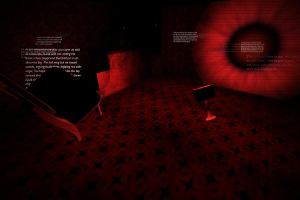
But these narrative strategies in turn suggest certain deeper patterns on which much of Campbell’s work seems to be built. His abiding interest in hints and fragments, for example, is admittedly suited to the nonlinear style of new media literature, but it also serves to suggest that Campbell’s central characters are often living in a reality with two layers: the “ordinary” everyday world which is mean, dull, shoddy and constricting, but relatively safe; and an inner or underlying reality which can only be glimpsed rather than viewed as a whole, possibly because it is so dangerous and frightening – a reality which emerges fitfully via dreams, games, imaginings and doodles.
It also frequently the case in Campbell’s work that the constricted dullness of the “ordinary” world is associated with adult life and adult sensibilities, whereas the “inner” reality is associated with childhood. Thus, in Nightingale’s Playground, the adult narrator starts to rediscover his “real” self when he breaks up with his girlfriend and rediscovers his memories of his best friend Alex. In a way, this could be seen as a Romantic or Wordsworthian view of the relationship between childhood and adulthood: as children we are much more in touch both with our imaginations and our inner selves, and therefore much more aware of the true nature of things, while as adults we become more absorbed in “getting and spending”, and therefore spiritually dull. Campbell is certainly no sentimentalist about childhood – in fact his stories are full of instances of kids being nasty to each other – and it should also be noted that the imaginative insights of the children in his stories may be shared or partially shared by more elderly figures such as the Gran in Nightingale’s Playground, another Gran in Dim O’Gauble, and the dying old man in Last Dream. It may be that these old people share the visionary capabilities of the young by virtue of their closeness to death – there are strong hints in the ebook section of Nightingale’s Playground that Carl’s Nan is about to die of lung cancer.
Perhaps a better literary antecedent for Cambell’s obsessive and visionary kids is the figure of Roland from Alan Garner’s Elidor – another hypersensitive and super-visionary outsider whose insight and talents serve to isolate him both from the mundane world of the Manchester suburb where he lives, and from the other members of his own family who would rather have safe, dull lives than dangerous, eccentric and magical ones. Of course Roland is an outsider-figure who can easily be identified with Alan Garner himself; and in the same way, Alex Nightingale can easily be identified with Campbell. The refusal of these visionary characters to settle for mere ordinary life can be interpreted as an oblique declaration of intent from the artists who created them. But there are other messages here too. The whole structure of Nightingale’s Playground is telling us something about the nature of the world we live in. Did Alex Nightingale actually disappear into an alternative reality, or did he commit suicide? Did Carl imagine Alex, did Alex imagine Carl, or did they both somehow imagine each other? Is the Sentinel just a computer-game or the key to something deeper? What was in the red vanity case when Carl first discovered it? What is the secret his Gran is so anxious to keep hidden? The fact that all of these issues are left hanging, and that the whole pattern of the story is therefore deliberately-unresolved, ambiguous, is a message in itself. Life isn’t clear-cut: it isn’t about answers: it’s about questions.
Nightingale’s Playground has its shortcomings, but it builds Campbell’s open-ended style of narrative into a more ambitious and absorbing structure – and explores some of his characteristic themes with greater maturity and depth – than anything he has produced before.
This review is co-published by The Hyperliterature Exchange and Furtherfield.org.
Featured image: Landscape by Antoinette J. Citizen (2008-2010)
The Italian plumber Mario appeared for the first time in 1981 as a character in the videogame Donkey Kong, created by the famous Japanese game developer Shigeru Miyamoto. Two years later, Mario became the main character of his own game, and his fame grew exponentially. Approximately 200 different videogames have been produced where Mario has the lead role. In contemporary art Mario is also a popular personality and Cory Arcangel is the artist who has done the most famous works based on the videogame.
Super Mario Cloud is probably the most famous of Archangels’ Mario works. It was created in 2002 and was exhibited at the Whitney Biennial 2004. In Super Mario Cloud Arcangel has hacked and changed an old Nintenedo game cartridge so that the only thing that remains of the original game are the little white fluffy clouds that slowly scrolls by on the clear blue sky. Since Arcangel has taken away all of the game elements and interaction you can refer to it as an anti-game. You can also interpret the work as a renewal and a commentary on the art historical genre cloud painting that became popular during the 1800s, when the science of cloud formations and their appearance emerged.
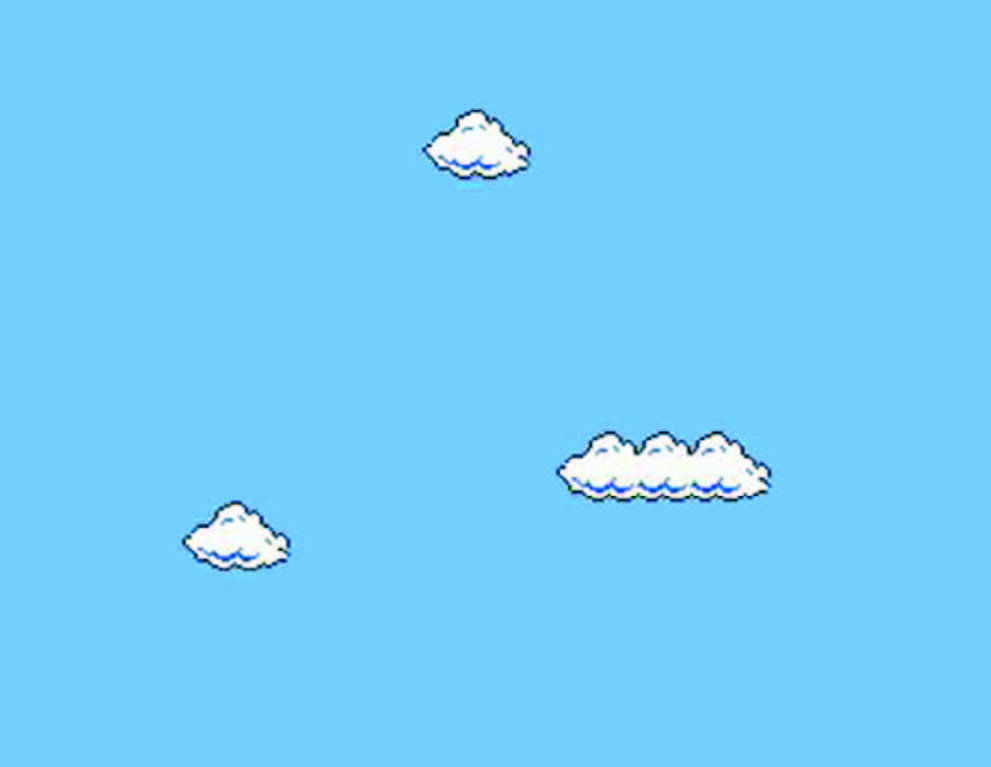
Super Mario Movie is a 15 minute video which Arcangel did together with Paper Rad in 2005. Again, this is a hacked cartridge of a Nintendo, and in the opening scene, you can read the following text:
“As a video game grows old its content and internal logic deteriorate. For a character caught in this breakdown problems affect every area of life.”
For Mario, it means that when his world grows older its graphic content and logic breaks down until he finds himself trapped in a nightmare where he falls head over heels down the screen in a changing fragmented world of psychedelic colours in which, among other things, a giant Mario head pops up. What Arcangel describes is the natural degradation process that eventually affects all physical storage devices from floppy disks, CDs to hard drives. When the stored information is getting corrupt by age it results in misreading with strange and illogical effects on the screen. It’s not just we human that are having problems when our cells and DNA are getting corrupt by age, even game characters could experience strange behaviors and diseases when their data ages.
Video: Naptime by Cori Arcangel (2002)
In the video Naptime (2002) we find Mario sleeping in his bed and above him is a dream cloud that consist of a psychedelic stream of characters and colours – the same effect which you can experience when you try to run old games that have become damaged or are using a computer with a broken graphic card. Just like in Super Mario Movie it seems like a nightmare is chasing Mario in Naptime. It is a world of corrupt code and information in which the game logic has broken down, a world that behaves as if it was infected by a nasty computer virus.
Video: SuperMario Sleeping by Miltos Manetas (1987)
The artist Miltos Manetas has also created a video with a sleeping Mario. In the three-minute long film Super Mario Sleeping (1987) we see how Mario gets tired and lies down and sleeps in the grass. Just as in Arcangel artwork the video is describing an anti-game. All the interactivity and stress in the game are removed and instead we experience a calm and meditative atmosphere. Philip K. Dick novel Do Androids Dream of Electric Sheep? (1968) comes to my mind. What is it that distinguishes a human from an android or a character in a video game? Can characters in computer games dream and, in that case, what are they dreaming of when we are not playing them?
It is now not only the character Mario who is interesting for artists, but also the objects in the game. The Australian artist Antoinette J. Citizen created in 2008 the interactive installation Super Mario Brothers Level 1-1 in which she transformed an art gallery into a Super Mario game. She painted the walls with different levels of the game and installed interactive boxes with question marks and bricks. The visitor could touched the boxes which then produced different sounds from the game. Citizen’s works are, like many other Game Art works, an example of how artists transfer the virtual game world into the real exhibition space.
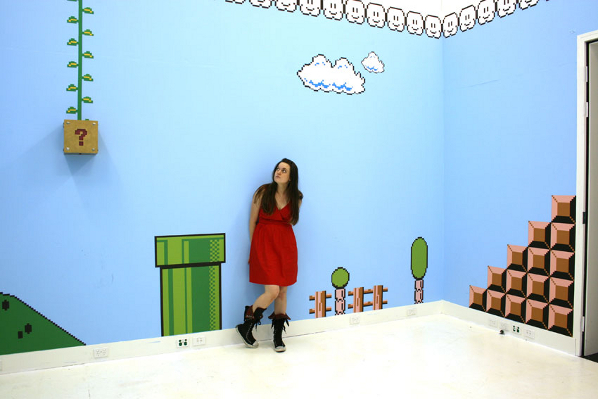
Mario is probably the most famous character in the videogame world. The question is if he is not as famous as Jesus? The Polish artist Kordian Lewandowski plays with the idea in the work Game Over. He has created a copy of Michelangelo’s famous Pieta sculpture but instead of a dying Christ in the arms of the Virgin Mary, we see Mario lying lifeless in the arms of Princess Peach. It seems that videogames with their own iconology and stories about the constant struggle between good and evil, in some degree, have taken over the role of religion when it comes to creating references and cultural contexts for people.
http://www.coryarcangel.com/things-i-made/supermarioclouds/
http://www.coryarcangel.com/things-i-made/supermariomovie/
http://www.artforum.com/video/mode=large&id=25370
http://www.supermariosleeping.com/
http://antoinettejcitizen.com/works/landscape/
http://wielkiartysta.pl/content/index.html
Liz Filardi is a New York City-based performance artist who often works in public space. She was recently awarded a Turbulence Commission for a networked performance piece called I’m Not Stalking You; I’m Socializing, exploring the anxieties of social networking in three modules. “Status Grabber,” the first module, is a satirical online service that extends the status update phenomenon to participation over the telephone. “Black & White,” the second module, is a Facebook-like website, consisting of two interlinked profiles, that tells the story behind one of the original cases of criminal stalking in America. “Facetbook,” the final module, is a performance piece in which the artist compiles a series of archives of her live Facebook profile to illustrate the tension of online identity– between the façade of a profile and the more telling story of how the profile changes over time. The interview was conducted by Taina Bucher, PhD fellow in the Department of Media and Communication at the University of Oslo, Norway. Bucher and Filardi met in Greenwich Village, New York City in May, 2010.
Taina Bucher: How prominently do your friends feature in your work?
Liz Filardi: Well, my only “in” to a social network like Facebook is my own profile, my own network. I think I have about 900 friends. I could start over with a new profile, but I would still only be able to access people that I know or know of. So the people who participate in works based in existing networks, like “Facetbook,” are my friends, and in this context, that includes any Facebook “friend” who feels comfortable commenting or interacting with me. I suppose there is also a subset of “friends” who are made aware of my activity without necessarily caring or wanting to interact with me. In that respect, networked performance on Facebook is very much like performing in public space—I get ignored a lot.
But I would love to find a way to reach a completely different audience on a social network, ideally a subset of users who have stumbled upon my profile without really knowing me or maybe only knowing me from the context of the network because I’m a “friend” of someone who they have “friended.” I have been thinking about starting over on a network like Facebook with this goal in mind, just to see what is possible. It would also be fun to create a new profile controlled by a collective of artists who want to play and experiment.
Why not just make a group on Facebook?
Groups have limitations. Individuals have the most access and mobility on Facebook, because it is designed with the individual’s activity in mind. Groups are like, “I’m here, come over here,” while individuals can say, “I like this, I am doing this, you and I are friends,” which is obviously what drives the site. I am also more compelled by putting a face on a group and speaking from the first person, mixing individual voices and sensibilities and presenting that as one person. It feels a little more subversive. I am interested in playing with the expectations of “friends” on Facebook. For some reason, there is a lot of trust that everyone, that is every non-celebrity, is exactly who they say they are.
Can you tell us a little about your project “Status Grabber?”
“Status Grabber” was created as a satire on the obsession with status updates. I wanted to know how people would react to a telephone-based service that essentially mimicked the way people use Twitter. So I called people and told them that someone they knew had anonymously requested a status update, and that they should provide me with a brief statement that I could post to the internet. I set up a website where people could actually make those requests and hear the responses. But I also made cold calls to random people listed in the telephone book.


My interest in status updates lies in the disconnect between the author’s intention and the follower’s intention as they engaged in a fairly consistent relationship mediated by a service like Twitter. On Twitter, you can post one message immediately visible to your followers, and those people can discover something about you and experience the feeling of a connection without ever having to say a word or reciprocate. In fact, as you post your update, you often do so with a vague idea of audience, not necessarily of personal connection. So the relationship between a Twitter author and follower can feel smug, but it is artificial—it is a designed experience. Apparently, if popular social tools fill a vacuum of desire, as we often believe, people actually prefer this designed experience on some level. We tend to prioritize the feeling of a connection over the actual value of the connection. In making the calls for “Status Grabber,” I’m basically confronting people with this cultural value.
I visited the site and listened to the call records you posted. It seems that people don’t have a clue about the notion of status updates.
Yeah, the concept of a status update obviously doesn’t translate to the telephone. On the phone, there is much more opportunity to communicate beyond the 140 characters allowed in a Twitter status update, so that became a humorous limitation to the updates that people were encouraged to provide. As a totally believable service, Status Grabber suggests that people actually do not want to have a full conversation or hear a complete update on your status, but instead prefer the abridged version so they can get on with their lives. Of course, most of the call recipients seemed slightly disappointed or appalled for that reason, and in that way, it felt like a good prank phone call.
Call recipients that were willing to participate seemed to feel anxious about the pressure of submitting a status update verbally. They were on the spot to say something substantial or witty as if posting to their Twitter or Facebook account. Most of the updates reflect more spontaneity, less density than can be read in Twitter feeds. I often felt that I was invading their privacy to demand a status update by telephone.
Let us jump to your third module “Facetbook.” How did you come up with the idea?
My day job is in design and I work with the content management system and blog software WordPress. When you edit a blog entry, a new entry is simply added to the database like an appendix to the original entry, so that you’re never editing the existing content of the database but merely adding to it. There is an archive of all your revisions. I started to imagine Facebook having a similar structure. It is possible that we are creating an archive of our life just by being active users, and yet, we have no ownership or access to it. Meanwhile, we present a singular identity within the construct of the profile. We update our profiles to project an idealized representation of ourselves. But if anyone could see the archive of these profiles and be privy to how they have evolved over the years, they would get a much more accurate sense of who we are, and maybe they would be able to see that truth far more clearly than we ourselves can see it.
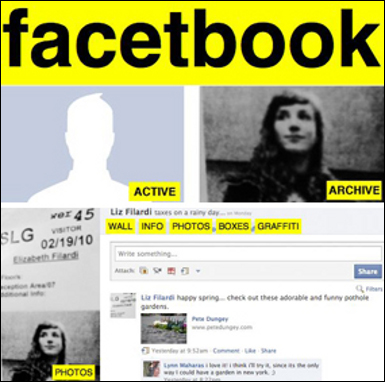
With that in mind, I started to imagine that Facebook actually provides a literal construct of identity. Is this why it’s so addictive and popular? It’s not as if we can go back in time in real life and see written archives of every conversation we have had with friends, and every song we quoted in high school, and every trend we followed. We understand our own identities based on our memories and the occasional ephemera- diaries, photographs, videos, concert tickets, old clothes. In some senses, we don’t own our past, but only the precious ephemera. And in the space between the ephemera and reality, we get to imagine our own story. On Facebook, we can flip back through our activity and photos, and we construct our profiles based on how we see ourselves and who we would like to be. But we can never see old profiles, ones that we’ve since replaced, or content that we’ve removed. We get to curate our identity, manage the expectations of “friends” and find privacy by hiding behind the content we chose to share. That feels real.
And yet, there is something distinctly unreal about Facebook, which is that it is essentially a document, a record in and of itself. Facebook users live on a document. What if everything ever deleted, in fact, lived on? That makes me anxious. So I started looking for software that would allow me to archive my Facebook profile, and I found an experimental Firefox plugin developed by a group of computer scientists at Old Dominion and Harding University. Using their plugin, I started to archive my profile every time I wanted to change it. I wanted to see what it would be like to own an archive—to at least know what it would contain, even if I couldn’t control what Facebook did with my content.
The truth was that I was far more invested in my image and my Facebook life when I was in college than I am today. Maybe it would have been more insightful to capture that early period. But ultimately, the “Facetbook” performance became about investing in Facebook again and thinking about the stakes of participation. Knowing that I would be creating this archive and could delete my profile at any time, I tried to confront the extent of how people actually use Facebook. I wrote things like, “For brief periods of time, I have favorite profiles that I like to check,” and “even if you never change your profile, I will look at the same three pictures more than once. It gives my mind something to work with.” It feels strange to perform on a site where only a very acute mix of authenticity and performance is acceptable as a voice—you know, in posting status updates that display some charming aspect of yourself without exposing that you’ve given any thought to it. With “Facetbook,” I’m trying to expose Facebook as a site that serves a more libidinal function for people.
How do you see performance art changing in an environment where performance has, to some degree, become commonplace?
That’s a bold statement—one could argue that public life has always been about performance and that performance is no more commonplace today than in the past—but maybe it is more commonplace. The prominence of the social web—especially for younger generations who have restricted access in the real world—pushes public life online and into the realm of performance. People who are growing up with social networks are justifiably feeling like the center of the world with daily evidence to that effect. The lives of prominent, young YouTube vloggers are filled with connections to near strangers who make up coveted audiences across geographic boundaries. Any time someone has an audience, they become a performer. I think of Natalie Bookchin’s Testament, which is a multi-channel video essay that appropriates YouTube vlogs to speak to themes like work, economy, and war. The video diaries that are used in her piece exemplify a personal, confessional approach as seen in television shows like The Real World, and yet they are beyond television—these people are acutely aware that they are sharing their daily life not necessarily with friends but with an audience. The vloggers use common buzzwords and phrases that Bookchin pulls out to create the sensation that they are speaking in unison, just as news anchors and talk show hosts speak in an established language and tone. And that has become a normative way to socialize.
But performance art is entirely different from the spirit of performance on the social web. For one thing, the moment you disseminate over the internet or design your work for an internet based reception, you are creating media art, or networked performance, as Turbulence has preferred to call it. As far as my own experience with performance art, every time I perform something in public, I imagine being interpreted in two camps: an amateur throwback to the founding artists like Abramovic and Ono and Shneemann (young performance artists always seem so nostalgic for the power of the body and the live act, but it’s rare to pull off something powerful and new) and/or an urban prankster looking for attention in the local paper or city blog (a la the clever performance troupes like Improv Everywhere who disrupt city life with the exciting treat of surrealism). So I think the challenge for contemporary performance art is to find a place that is at once culturally relevant and striking, and to champion public space in a compelling way. It’s too easy to just take your actions to the streets of New York like plop art. People are already used to that. Lately I’ve been trying to create works that don’t come across as one-liners, but instead inspire the viewer to question what is going on, or to hold on to one particularly poignant affect or visual. The last thing I want to say—it gets problematic when one begins to qualify performance art as something that happens in galleries and museums because it was meant to defy the commodification of art, but I do want to say that I see it forging ahead in small galleries like Recess in SoHo.
Can you speak a little about your second module, “Black & White?” How did that come about?
That project started with research into the history of criminal stalking, as it relates to the popular contemporary idea of “Facebook stalking.” I wanted to explore the relationship between the tongue and cheek use of the word stalking to describe fairly typical activity on social networks and historical accounts of serious stalking in a time less saturated by social web technologies. I was fascinated by a famous case from 1988 between two co-workers at a Silicon Valley software engineering company. A young woman, a 22 or 23 years old Laura Black, started working at the company as one of the few female engineers. She sparked the unhealthy interest of a male engineer, Richard Farley, who became suddenly deeply obsessed with her. He stalked her for years, and while she sought help at her company when she feared for her life, she had trouble getting any real protection. She changed addresses and phone numbers, which only provided temporary relief, and got a temporary, ineffective restraining order. He would send letters, arrive at her house unannounced, and once joined her gym. In her anger and fear, it seems that she also wanted to show him that he couldn’t control her and that she was still going to enjoy her life and stay in the area. So there really wasn’t a collective intelligence about the threat of stalking at the time. Farley eventually arrived at the office with an arsenal of weapons and attacked the entire company. Black was shot in the shoulder and survived. Farley was arrested. Shortly after, the first anti-stalking law passed in California in 1989 and the story, along with a couple of other violent stalking cases, made national news.
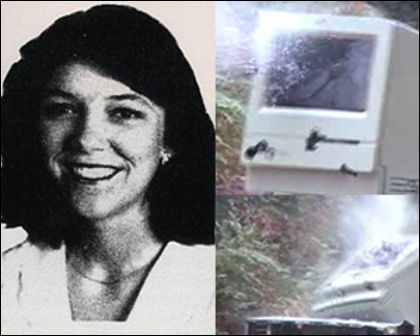
Today, we don’t hear about cases like that because we have a lot more information and legislation to prevent that kind of thing. I can only assume that potential incidents are resolved before escalating to that level. We live in a different climate, where we share a lot more information about ourselves on the social web, and “stalking” is a hyperbolic term that describes the ultimately harmless activity of focusing on the available information of a single person without their knowledge or consent. The use of negative hyperbolic terms like “stalking” indicates a safer cultural climate, but also a latent guilt that may be rooted in cases such as the one illustrated in “Black & White.”
This makes me think of Twitter and the term “followers.”
Yes, it’s similar. Perhaps there’s a greater cultural need to be leader, with a collection of commoditized “followers” in tow. On the social web, we are less often ordinary humans and more often celebrities or actors splintered by various interests and audiences.
In “Black & White,” why do you transpose the stalking case into the paradigm of a social network?
Black&White is the name of a fictional network that looks much like Facebook, but it only contains two members: Laura Black and Richard Farley. Creating this site was a way to call attention to collective intelligence, to speak the language that we (on Facebook) have all learned so well. I knew that most people would intuitively be able to navigate the format and learn the story between the two people involved. In the context of the vast network of Facebook, it is striking that there are only two people in this network. Their content is linked through their job and location, despite their apparent lack of friendship. Underneath the relatively unassuming public profiles is a horrifying, one-sided correspondence in their message in- and outboxes. I wanted to dramatize their loneliness and emphasize the lack of will in their connection, which is how they will be remembered in the American collective consciousness. Hopefully this leads viewers to consider how and why the term “stalking” or the act of “stalking” has changed since the 1980s.
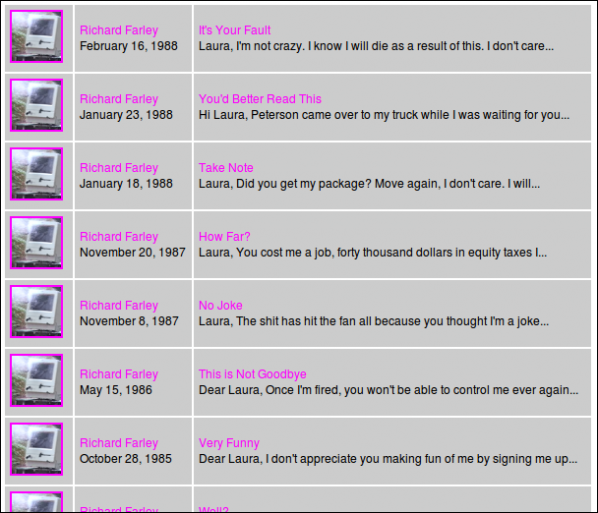
In terms of creativity on social networks, I think a lot of us are just filling in forms. The template of the social network is limiting. Will this have any affect on the direction of your work?
That’s a good question. I have felt confined by the structure of social networks, and even with the content of art that speaks directly to social networks. With I’m Not Stalking You; I’m Socializing, I started with the easiest form of art made to respond to social networks: a satire perpetrated through mimicry in other medias or dimensions, as seen in “Status Grabber.” This has been done in other works, as well. I guess I needed to make that piece so that I could see what was beyond it, and I believe I went a little further and yielded more insight in the other two modules. But now I’m starting to see how the social web simply permeates our consciousness and I believe I may find more insight if I take a step back from art on social networks altogether. As someone who has grown up on social networks, I’m interested to see how the themes that I’ve honed in my work with social networks will surface and return in works and areas of practice that move in a new direction.
The four day event at the Showroom collated a series of practitioners, artists, theorists and historians, to examine, test and explore ideas stemming from cybernetics and information theory and more specifically the idea of feedback.
Described as an ‘experimental cross-disciplinary research project’, Signal : Noise was a fusion of talks, lectures, performances, screenings and debates that made diverse contemporary evaluations of the legacy of cybernetics using an inter-disciplinary approach. It tackled subjects as seemingly diverse as economic theory; urbanism and the arrival of the motor car in London; game theory; linguistics; media-performance art from the 1970’s; and the problematic legacies of the recent UK arts funding system on artists – all viewed using the concepts and terminologies of cybernetics and systems.
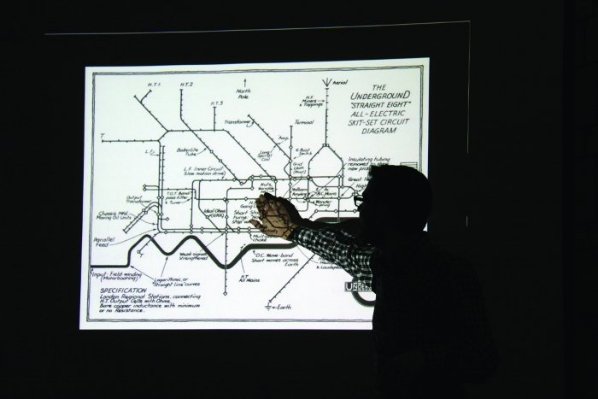
Signal : Noise, in part, played out like a small conference, mainly set in The Showroom Gallery space with one wall covered with a network diagram drawing by Stephen Willats, and fly posted theoretical systems diagrams from his recently re-published 1973 book, or maybe manual, ‘The Artist as Instigator of Changes in Social Cognition and Behaviour’.
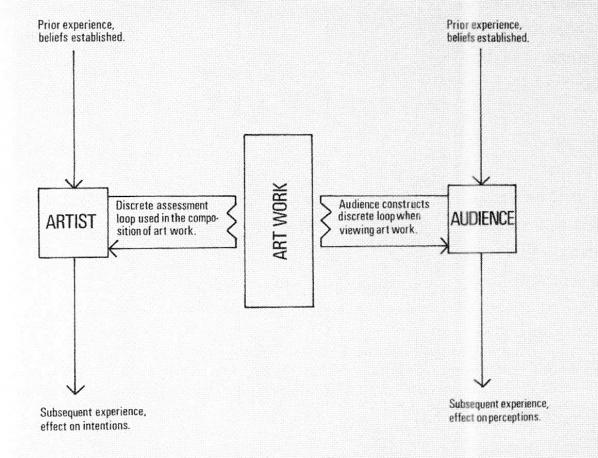
This visual reference served as a backdrop to the proceedings and served as an on going reminder that despite the deep theoretical and historical base being presented and discussed in its many forms, Signal : Noise was ultimately attempting to re ignite debates, and help reset the ideas of cybernetics and systems into a contemporary context of practical application. Willats’ book describes his process as an ‘investigation by the artist into the processes, procedures and models’ of the ‘Art Environment’ using ‘cybernetics as a research tool’.
The first night introductory presentations by Charlie Gere and Steve Rushton provided an overview of many ideas explored throughout the weekend. Artist and writer Steve Rushton on ‘How Media Masters Reality’ used an array of examples, from conceptual and media architecture group Ant Farm using pioneering ideas of investigating media feedback, through to the 500 millions votes (!) on US TV programme American Idol; the latter an example of how contemporary applications of media feedback loops are now often conceptually embedded into the core of television productions, and in turn, are now part of the audiences expectations and involvement.
Ant Farm’s 1975 work ‘The Eternal Frame’, screened later during the weekend, along with Gary Hill’s Why Do Things Always Get in a Muddle (Come on Petunia), based on Gregory Bateson’s Metalogues.
Ant Farm’s 1975 work ‘The Eternal Frame’, screened later during the weekend, was their carefully staged, somewhat trashy live ‘re enactment’ of the 8mm film footage of the Kennedy assassination, complete with a drag version of Jackie Kennedy and sunglass wearing suited security. This film sequence is familiar today, but in 1975 it had yet to reach the public domain. Working to a tightly choreographed moment derived from a bootleg of the 29 seconds of 8mm film, Ant Farm’s grotesque mimicry of the assassination was performed as an ongoing loop, complete with car driving around the block (interestingly, the random people watching in the street in 1975 took photographs like they were at a theme park).
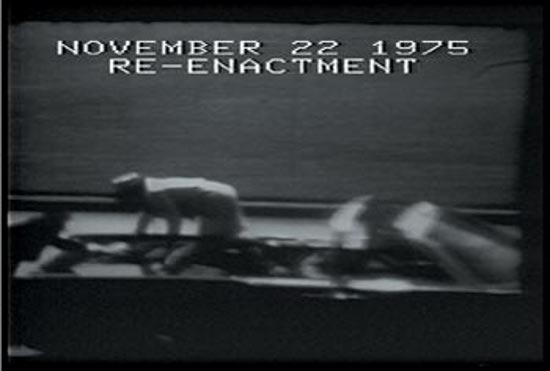

Despite being conceived in the mid ‘70s media environment of portable video and cassettes, the documentation of Ant Farm’s performance resonated with something surprisingly familiar and contemporary in our era of the internet, social media and rolling 24 hour news, and what Rushton termed our “society of self performance”.
Rushton’s historical threads from the origins of Cybernetics and to the Whole Earth Catalogue and the WELL served as a excellent base for the oncoming proceedings of the weekend, and showed that the arrival of the contemporary mass information network in the form of the internet, has habituated it’s millions of users into a kind of cybernetic practice based on input, observation, control, intervention, response, feedback, and adaptation but without necessarily using or being aware of its lexicon.
Nearby, in the Cockpit Theatre, was ‘Closed Circuit’ a performative work by Rod Dickinson (along with Rushton), which consisted of two actors staged and dressed, in a precise duplication of a set for political announcements; wooden lecterns, curtained background, complete with an array of flags – but all carefully neutralized by the removal of logos and national flags identities into plain white.
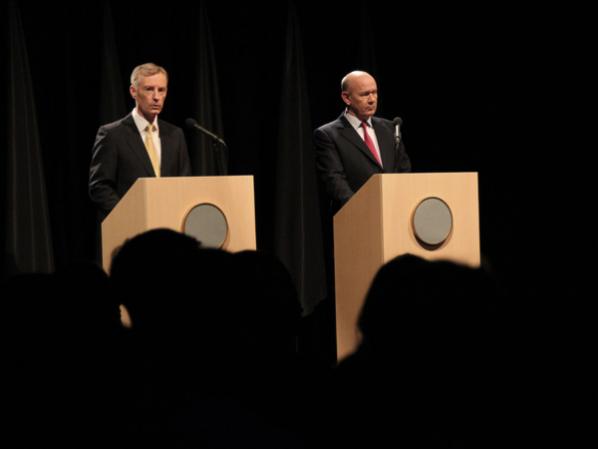
What followed was a series of political speeches utilizing the familiar language and tone of grandeur and crisis, delivered by the actors in the style of a world leader address. What they delivered, was a carefully sequenced remixed script derived from political speeches over the past 50 years; Margaret Thatcher; Richard Nixon; Ronald Reagan; Tony Blair; Yasser Arafat and others. All the details from each specific event they were referring to had been carefully edited out. The only way to differentiate one world leader, country or event from another, were the large projected auto cues for the actors, situated behind the audience at the rear of the theatre. Each one gave the full scrolling speech text and also the year and original context for each leaders’ delivery. Looking towards the stage, it sounded like a single coherent speech, but eluding any specific meaning, isolating the language of threat and authoritarian political control, leaving us just the husk of political presentation and the transparency of the format itself.
Ideas explored in Stephen Willats’ network drawing were expanded further during his talk in the final morning session of Signal : Noise, where he gave a refreshing clarion call to abandon ‘last century thinking’ during his prescient and timely discussion. His seminal works have persistently and methodically challenged the process, structure and meaning of art making and display. Willats made his earliest system diagrams in the late 1950’s, and was the first artist to make the artwork itself a map of communication. But maybe it is this century, rather than our last, that will connect with his provocations to the hierarchical, highly codified, object obsessed ‘Art Environment’, as he terms it, to see that ‘object based thinking is still a hangover from last century attitudes’.
Willats was an early reference for emerging net art and media art in the mid 90’s, with artists then clutching for any art historical roots that gave the field of networked and computer based practice some practical grounding.
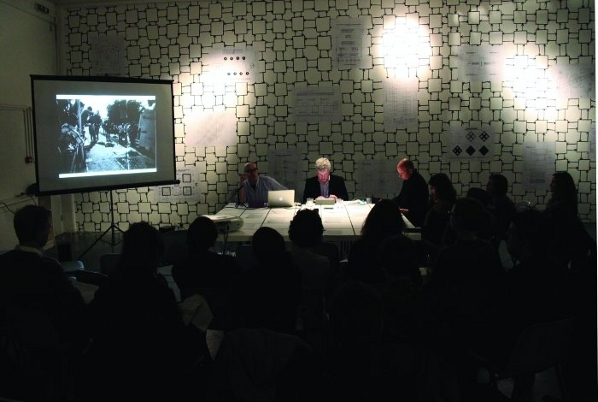
This in-conversation with Emily Pethick surveyed his own personal development and immersion in Cybernetics in its differing stages, a short history lesson, moving from Norbert Weiner to Gregory Bateson and Gordon Pask, but always resolutely en route to the practical issues in the present and what Willats defines as the artist as an ‘instigator of transformation’.
In parallel to Willats, was a presentation and discussion hosted by Emma Smith and Sophie Hope which began to interrogate the legacy of a the New Labour arts commissioning process. It discussed how the criteria for successful funding was intrinsically linked to a social agenda, audience and location set by government policy. Discussions followed about how the arts commissioning process may turn out to have skewed a generation of artists practice, as they slowly lost control of their own output, became tagged with being an ‘artist facilitator’, and began conceiving works to fit in with the criteria of funding bodies, with each funder slowly extending their own prospective reaches. All this supported by an immense drive to build ‘Cultural Industries’ into mechanisms for regeneration.
Seeing this placed against Willats, whose ongoing practice could initially seem in tune with the past decades cultural policies and its overtly prescribed socially engaged agenda, in fact served to show how contrasting, distinct and rich his rigourous thoughtful approach is by comparison.
All this made for a timely discussion. With the approaching withdrawal and decimation of arts funding in the UK, Signal : Noise could prove to be a prescient event. With presentations, workshops and panels by Stuart Bailey and David Reinfurt of Dexter Sinister, Charlie Gere, Matthew Fuller, Marina Vishmidt and others, the interdisciplinary approach of Signal : Noise worked well despite its fairly dense timetable.
Using the gallery as a discursive space, with theorists and writers set within context of practice, is a good base for the next event in this on going series. What it maybe didn’t allow for, which is easily rectified, is a more unpredictable agenda, and more intervention by the ‘audience’. The whole event could function more as a real feedback working system, an adaptable structure that potentially allows for input from its participants (both presenters and audience) letting things move in unexpected directions both on line and offline, leaving a physicalised network as a residue after the event. With the decision to include food and beer in the ticket price (great dumplings, fresh vegetables and miso soup), there is potential here to expand this type of event even further.
With the on coming cultural landscape in the UK moving into un-chartered territory, it is potentially events like Signal : Noise which might begin to unearth and test new ideas and ignite debate within a less rigid format than a ‘curated’ show. In the future this type of event may even re-claim the word ‘radicalise’ from its current narrow, negative media usage, and re-purpose it for artists who decide to reject art market values, in favour of a exploring new ways of working within the emerging (and significantly less funded) ‘Art Environment’.
Signal : Noise. The project was led by Steve Rushton, Dexter Sinister (David Reinfurt and Stuart Bailey), Marina Vishmidt, Rod Dickinson and Emily Pethick. http://www.theshowroom.org/research.html?id=161&mi=254
The Artist as an Instigator of Changes in Social Cognition and Behaviour. 1973. Stephen Willats. http://www.occasionalpapers.org/?page_id=825
Closed Circuit, Rod Dickinson in collaboration with Steve Rushton.
http://www.roddickinson.net/pages/closedcircuit/project-synopsis.php
Dr Charlie Gere. Reader in New Media Research. Department: Lancaster Institute for the Contemporary Arts. http://www.lancs.ac.uk/fass/faculty/profiles/charlie-gere
ANT FARM. ART/ARCHTECTURE/MEDIA [1968-1978]. http://artsites.ucsc.edu/faculty/lord/AntFarm.html
The Eternal Frame by T.R. Uthco and Ant Farm: Doug Hall, Chip Lord, Doug Michels, Jody Procter. 1975, 23:50 min, b&w and color, sound. http://arttorrents.blogspot.com/2008/02/ant-farm-eternal-frame-1976.html
Emma Smith. Social practice that is both research and production based and responds to site-specific issues. http://www.emma-smith.com/www.emma-smith.com/Homeindex.ext.html
Sophie Hope’s work inspects the uncertain relationships between art and society. http://www.welcomebb.org.uk/aboutSophie.html
20 Digital Years Plus
Station Rose
Nurnberg 2010
ISBN 9783869841113
“Twenty Digital Years Plus” is a softback book that presents and contextualises the art of Station Rose (Elisa Rose and Gary Danner) from 1988 to the present. Its gatefold cover conceals both a CD and a DVD which provide audio and video to complement the static images and texts, and carries an endorsement from Bruce Sterling on the back cover.
The book starts with a series of essays before presenting an illustrated history of Station Rose. Those essays approach Station Rose from some refreshing and unexpected angles to make a convincing claim for their art historical interest.
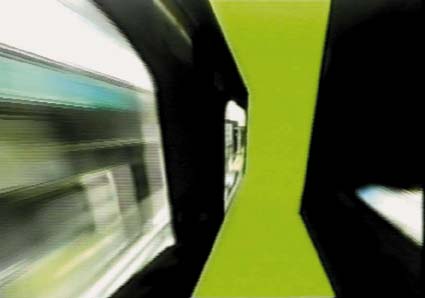
Peter Noever writes in the book’s preface that “Media art is both an art form and a way of life for Station Rose”, a claim that the evidence of the book more than supports and that I think is key to why Station Rose’s art is so interesting. The book functions as a mid-career retrospective, and Noever suitably sets the themes of achievement and continuity.
Vitus H. Weh’s essay explains how Station Rose got their name and puts their LoginCabin project into the context of German post-cold-war architecture and the sociology of the Wild West. We are a long way from the early 90s view of the Internet as a new frontier, but despite its critics that view was not uniquely tied to American society and provided a liberating impetus to individuals who didn’t always subscribe to the Californian Ideology.
Hans Diebner’s critique of net art and activism brings a thought-provoking scientific, techno-art historical and philosophical critical literacy to bear on Station Rose and the artists and activists that he contrasts them with. Diebner weaves together diverse conceptual strands into a coherent critical case without any resort to jargon, and it’s worth thinking through how his case affects our view of net art in general as well as Station Rose’s position within its history.
Didi Neidhart’s interview with Rose and Danner provides context for and insights into how the pair create and conceptualise their work, and how their art and music relate. Station Rose emerge as the product of cultural engagement and lived history rather than academic fashion.
Gabriel Horn writes from a curator’s point of view about the future shock of working with Station Rose in 1991, in contrast to working with them in 1999 when they are part of an intermedia exhibition.
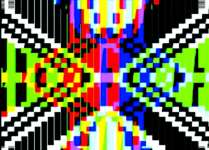
The bulk of the book is an illustrated history of Station Rose. They started out in 1988 as a multimedia lab in Vienna complete with 16-bit Amiga computer. In November 1988 they went online for the first time at the Sampling conference they held in Vienna, having already adopted the technology and concepts of sampling into their art and performance. Since then their work has taken the form of CD-ROMs, live streaming media, live multimedia performance, Internet homepages, CDs and vinyl with Sony records, books, TV shows, multimedia installation, webcasting, lecturing, teaching, and a shed.
Station Rose also create memes, or language, such as the statement quoted by Bruce Sterling on the back cover that “Cyberspace is Our Land”, the much needed identification of the “Digital Bohemian Lifestyle” and the increasingly paradigmatic condition of being “private://public”. Even in an age when the concept of multimedia has largely been absorbed by the Internet their work crosses and assembles different media.
Much of Station Rose’s digital art has the not quite glitch aesthetic of overlayed pixellated form in shallow depth that any serious history of digital art needs to account for. But the cubicles, huts, pillows and panels of their installation work have the same aesthetic. Station Rose’s work is in itself a history of digital art over the last two decades. And this digital art is always in dialogue with physical performance and physical structures, the virtual in dialog with the real to illuminate each other.
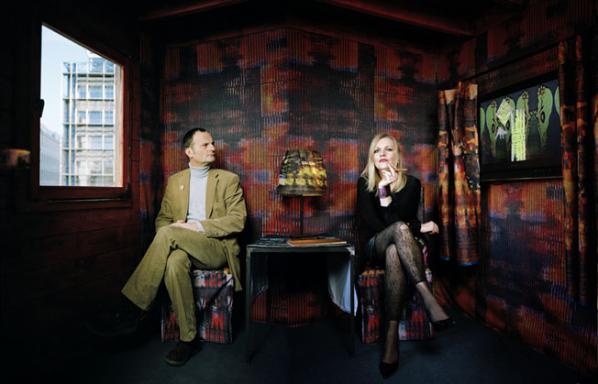
In Neidhardt’s interview, Danner says of Station Rose that “We are quickly bored with things as soon as they become mainstream.” Boredom with the content and products of digital media is the friend of the scheduled obsolescence and cultural amnesia of market mass media. But boredom with the form of and the means of creating digital media can also serve to motivate the creation of successive alternatives to it.
Over the last 20 years the Internet and digital media have gone from being a novelty to being socially and economically pervasive. This rate of change, and the constant promotion of different visions of what the Internet is for by different institutions, mean that our relationship with the Internet has come to be in plain sight. Artists can usefully depict and help us conceptualise that relationship, particularly those artists who can use the digital media that has been drawn into the Internet and become no small part of its operation.
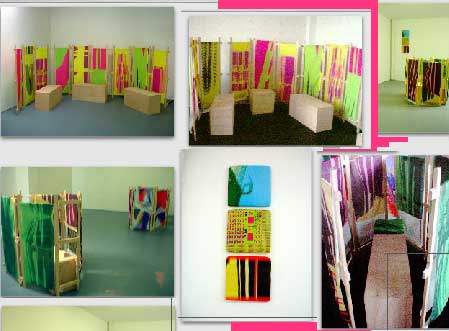
Station Rose are such artists. Their art has the quality of being both the product and producer of lived experience in the age of digital media. It refracts the logistics and glitches of the Internet through the prism of contemporary art’s deceptively low-fi rummage sale aesthetics to present them as objects of contemplation. When digital media was new this served to make them accessible to an unfamiliar public. Now that digital media are pervasive to the point of invisibility, this serves to make them visible again as objects of contemplation and to afford the viewer a critical distance from them.
20 Digital Years Plus is an engrossing, thought-provoking presentation of the ongoing development of Station Rose that makes clear the value of their constantly enquiring relationship to ever changing technology.
(With thanks to @MarkRHancock)
The text of this review is licenced under the Creative Commons BY-SA 3.0 Licence.
Featured image: Games/03 Paul Sermon, Peace Games, © der Künstler 2008.
Das Spiel und Seine Grenzen: Passagen des Spiels II ed. Mathias Fuchs and Ernst Strouhal, (Springer Verlag, 2010), German language only.
Fuchs, Mathias; Strouhal, Ernst (Hrsg.)
1st Edition., 2010, 272 S. 16 Abb., Softcover
ISBN: 978-3-7091-0084-4
Versandfertig innerhalb von 3 Tagen
Mathias Fuchs is considered to be one of the first artists to explore the combination of videogames and art. Today he is a senior lecture at Salford University in England and a leading researcher on Game Art and ludic interfaces. Social and political context in videogames and how they affect our society has been a major topic in Fuch’s research. Last year he published, together with Ernst Strouhal, an anthology of videogames and its borders and how this genre is changing and influencing society. The background to the anthology was an exhibition held at Kunsthalle Wien in 2008 about art and politics in videogames.
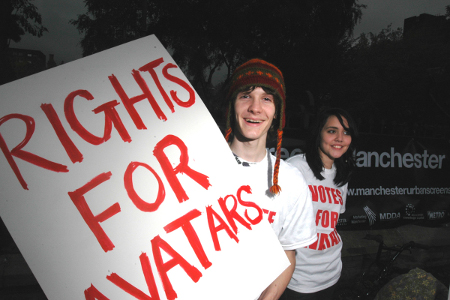
It has been 60 years since Johan Huizinga’s now classic book Homo Ludens, the playing human, was published. Games are no longer just entertainment; it’s a major industry that is affecting our society in every aspect. In the foreword Fuchs states that the main issue for the 15 essays in the anthology is how games have changed and affected our society both politically and socially since they crossed over from the realms of entertainment into everyday experience.
Today we can find many different genres in videogames, such as serious games and persuasive games, that discuss current issues, news and social problems, artistic games which address existential and aesthetic aspects, and so on. The gaming community has grown enormously and created on-line worlds with strong virtual economics, attached real world economics. In her essay Daphne Dragona says “The virtual environments of our times therefore can be seen as social institutions with social, political and economic values resembling those of real life.”
In a similar way Tapio Mäkelä’s essay about locative games describes how the gamescene has entered the real world in the form of cos-players and social gameplays where videogames as Pacman are performed in the city streets or games as “/Noderunner/, where participants run to find open WiFi Networks, take a photo of themselves at the location and send the info via e-mail to the project’s website.” This begins to close the gap between networks and everyday experience through the practice of social gaming. The game as object is less of an obvious conclusion now that technology enables us to explore ourselves within networked, gaming contexts and mobile technologies.
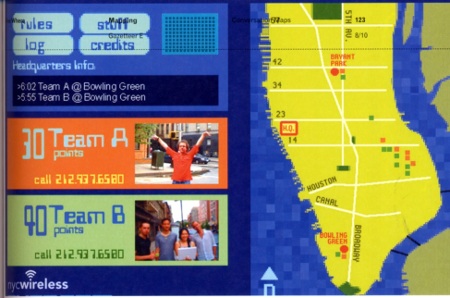
The borders between game and reality have now become even more blurred and integrated, especially if we consider how technology itself also crosses over into administrational activites which have already been traditional elements of controlling, processing parts of our lives. One example is how authorities around the world are supervising these new socio-economics, such as collecting taxes from virtual incomes by using similar tools and networks. There are many questions about how games will continue to affect and change our society in the future and the anthology takes an interesting and comprehensive look into what games have to offer and what could be potential threats to our future societies.
Today games are serious business. It is not impossible that in the future a bankruptcy of an on-line gameworld could shake the real world and create an economic depression. On the other hand, could on-line game economies bring prosperity and create new jobs, an economic boom in ways we have not witnessed before? If games move into a new period of changing social experience in even more connected ways than before, then we need to understand what the consequences of these are and how to navigate through this shifting terrain. One thing is for sure, it was a long time ago that games were just entertainment.
http://www.springer.com/new+%26+forthcoming+titles+%28default%29/book/978-3-7091-0084-4
Brian Eno hovered over me in a darkened room as I squatted writing notes about his 77 Million Paintings on a crumpled up piece of paper. Though I knew he couldn’t see what I was scribbling, its not often one gets the chance to come face-to-face, or rather back-to-face in situ with the flesh and blood incarnation of one’s investigations. He had slipped into the viewing room at the Glenbow Museum unobtrusively because he likes to watch – the audience as well as his “paintings,” and therein lays his strategy and appeal. In a lecture he gave that night at the Museum auditorium he described, in magnificent pantomime, the reactions one has when entering the viewing space of his exhibit:
looking around, furtively glancing at the work
walking further into the space, looking around, glancing at the work
leaning against the wall, glancing at the work
squatting, glancing at the work
sitting down, glancing at the work
focusing on the work, lying down on the floor mesmerized by the work
unable to tear oneself away from the work
77 Million Paintings contains 550 paintings Eno created over a span of 22 years. Since 2006 the exhibit has toured all over the world including Tokyo, Sydney and St. Petersburg before landing in Calgary. The digital projection is a “generative” work in that the ambient music for which Eno is better known, and the combination of images are generated and combined in an endless mandala-like array by a computer. Nine screens project a diamond shape with eight inserted “paintings” and one solid colored square on the lower right hand side serves as a control for the other eight. There are four black leather couches for people to zone out on while enveloped by his signature ambient sounds – and they are packed to capacity as the audience warms and hunkers down to the slow experience.
Originally conceived for in-home viewing, the show seems to change your brain waves from Alpha to Beta to Theta and the experience is pure occipital enjoyment. The cross-fades in the banks of images creep up as the landscape subtly changes as blue morphs into green, and triangles expand into circles As Eno says, “We’re not seeing a film. There’s no beginning, there’s no progression, there’s no end, there’s no narrative, there’s no drama. In fact everything is missing that would normally be called art or entertainment.”
Eno’s lecture at the Glenbow Auditorium could have continued all night but for the protestations of those with day jobs. He began explaining the radical impact Copernicus had in 1543 when he revealed man was no longer the center of the universe, as earth orbited around a system with some 400 million stars. Darwin came along in 1859, and pointed to the phylogenic tree stating there were 20 billion species besides humans. “ We are amazingly minute in this picture,” Eno mused. After Darwin it was Cybernetics, which introduced the notion of feedback as a way to think about complex systems. We cannot control these systems, only set them up to control themselves, and that notion became part of his vocabulary of how things organize themselves.
Starting with royal Kings and the Church, man organized himself in hierarchies from the top down that includes the structure of the 18th Century orchestra, still extant today. Sixty or seventy years ago this would show up in the shape of a top-down pyramid, but the world now functions more as a feedback loop, not a hierarchy. Eno explained when he was growing up his uncle slipped him a book on the artist Mondrian. He found the pictures magical, economical, and transparent. They contained “no subterfuge of technique.” Attending art school at Winchester School of Art, part of a music school in England, his forward thinking art professors invited the composers John Cage, Christian Wolf and Morton Feldman to lecture. Not one musician or music student on campus came to hear them.
He described listening to Terry Riley’s minimalist music composition In C,as “life changing.” That piece contains 53 short, numbered musical phrases lasting from half a beat to 32 beats repeated an arbitrary number of times. He also mentioned Steve Reich’s It’s Gonna Rain, where Reich recorded Brother William, a Pentecostal preacher and “sought to maintain the fascination of the speech content while intensifying its meaning and melody through rhythm.” This piece Eno admitted, “is the basis of most of my career.” He said one’s ears function differently than one’s eyes. Eyes scan all the time. If they don’t scan, they habituate and don’t see any thing. If you have a repetitive event the eyes cease to see, and what he focuses on is the uncommon information, “the out of phase collision of the loops.” This approach makes your brain do the composing. As this he says, has led him to his work ethos, “doing as much as I can with as little as possible.”
—-
Brian Eno’s exhibition 77 Million Paintings takes place in the Glenbow Museum from January 6 to March 20 2011. http://www.glenbow.org/exhibitions/
A performance by Alexandre Burton and Julien Roy
Alberta College of Art and Design (ACAD), Calgary, Canada, November 11, 2010
“We are absorbed by the beauty of electronics absorbing into the air,” is how Burton and Roy described their literally electrifying, and often frightening forty-five minute audiovisual performance of high-voltage electromagnetic disturbances. The event necessitated everyone present turning off their cell phones, i-whatever’s, and cameras to avoid provoking 800,000 volts of raw Frankenstein-like crackling electricity from throwing out a surprise lightening bolt and zapping an unsuspecting audience member.
POWEr’s instrument is an audio-modulated Tesla Coil with its own “boutique” ground that resembles a stripped down tuba with lots of copper colored coils. A bent over piece of metal culls the tail end of the generated electricity so it can be captured by a high-speed camera, and processed and re-purposed. Both Burton and Roy, who trained in contemporary classical music training in composition and electro-acoustics at the University of Montreal added, “We like noise so we try not to do melody, except at the end.”
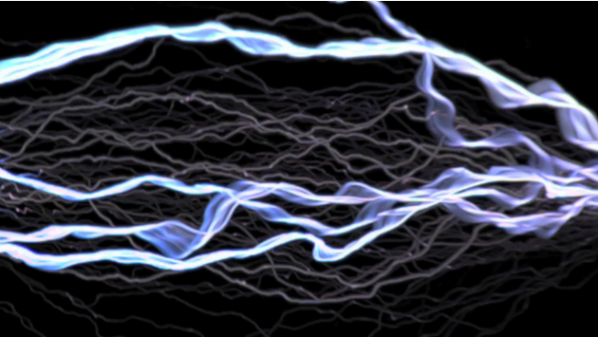
The piece is raw and alive, and no photograph or video can substitute for sitting in the line of fire of a sparking raw electrical feed. It smells tangy and metallic; a by-product of its ozone inducing properties and you can practically taste the microscopic particulate matter its hybrid frisson generates on your tongue. The sheer shock of its taser-like impact up close and personal is mesmerizing and anesthetizing but its actual menace doesn’t lie in its extreme voltage, but in its electrical amps, which is the charge that actually goes through you. “If the amp is low it just goes onto your skin, but if the amp is high you can die,” the artists sanguinely informed the audience in a Q & A after the performance. They also explained it took six months to come up with the idea, and another six months to make he piece not explode.
The creator’s studio site Artificiel.org says they are interested in “the desubjectification of sound and image materials, R&D creativity as the consequence of artistic research and the building of a genuine digital performance practice.” This idea is coupled with an astute technical know-how. To capture such an electrifying event the camera runs in a special “forever mode” that can be wiped clean at their discretion. The electromagnetic arc produced by the Tesla coils lasts for just a few very bright nanoseconds, so using a mechanical shutter is impractical. The ISO, dampened down to 50, allows a baseline sensitivity to actually capture the image.
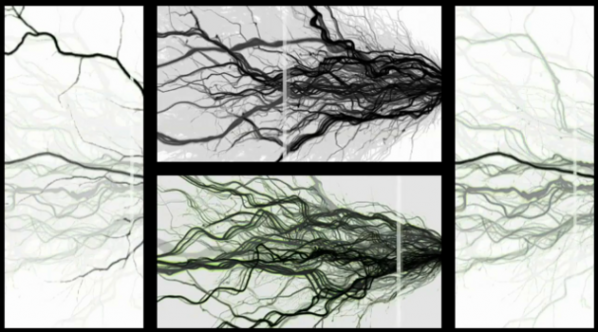
Once captured, the images are transferred to the computer via a high-speed uncompressed connection, where recording, filtering and geometric adjustments are made. The visual data is handled as sound, allowing quick and precise images to be processed on the fly. “It is also a very intuitive approach to “synesthesia,” Burton said as the software abstracts both sound and visuals in the same way. Logic Pro and MAX/MSP/Jitter manipulate duration, signal, timbre, and resonance live time as technology and geekiness combine with a dash of old style showbiz razzle dazzle to produce a truly hair raising show.
(Images above are excerpts from a performance in Québec city 2010)
View video of Alexandre Burton’s and Julien Roy’s live performance here http://vimeo.com/9816953
A Computer in the Art Room: The Origins of British Computer Arts 1950-1980
Catherine Mason
ISBN: 1899163891
JJG Publishing 2008
Computing anywhere else but its history often seems like a carefully guarded secret. This has been alleviated by activity around the resurrected Computer Arts Society in the 2000s, notably the acquisition of CAS’s archives by the V&A and the CaCHE project at Birbeck College which ran from 2002-2005. CaCHE, run by Paul Brown, Charlie Gere, Nick Lambert and Catherine Mason, produced conferences, exhibitions, and publications including the book “A Computer In the Art Room”, by Mason.
The art room of the title is the art department of British educational institutions prior to art becoming a degree-level subject. From the 1950s to the 1970s, when the cost of computing machinery dropped from the level where only major government and corporate organizations could afford them to the level where you only needed a second mortgage to afford one, the best way for artists to get access to the enabling technology of computing machinery was usually in an educational institution.
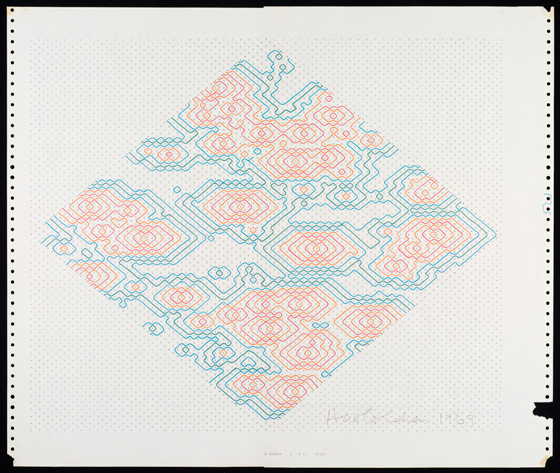
Mason starts out by describing the artistic and art educational situation in the UK at the time of the Festival Of Britain and the foundation of the ICA in London in the early 1950s. She then explains the structure and significance of the emergence of Basic Design teaching, the impact of the Coldstream report on art education, and the rise of the polytechnic colleges over the next thirty years. This provides vital context for the emergence of art computing teaching in the UK. It is also of more general interest for British art history. Conceptualism, performance, Land Art, the Hornsey Art School occupation, and the educational and media graphics that are currently being used as the basis of “hauntological” art all share this background and can better be understood and critiqued with better knowledge of it.
Basic Design courses started in London but didn’t remain there for long. They spread and matured throughout the UK, becoming entangled with the earliest teaching of art computing in provincial technical colleges. Mason traces the family trees of art computing teaching over time through these institutions and back to London-based institutions. Some of the names are familiar from art history (Richard Hamilton, Stephen Willats), some from art computing history (Harold Cohen, John Latham). Where the people involved cross over with cybernetic art, Conceptualism or other artistic currents Mason shows how their ideas fed into and from their art computing work.
The conceptual content of art computing followed the Bauhaus, cybernetics, systems, sociological and environmental influences on art from the 1950s to the 1970s. Its technological forms likewise followed those of mainstream computing. In the 1960s time was leased on mainframes or computers were built by hand. In the 1970s, minicomputers became available and art domain-specific software frameworks or programming languages were written by their users. In the 1980s, workstations with touch tablets, framebuffers, and increasingly proprietary software brought previously unprecedented power and ease of use at the cost of more fixed forms.
The history that I had to piece together as a student from hearsay and from hints in old publications, of the PICASO graphics language at Middlesex University that I found a print-out of the manual for when I was there in the 1990s, of Art & Language’s use of mainframe computers, of early cross-overs between art computing and dance, of cybernetic systems and games that attracted mass audiences before disappearing, is detailed, illustrated and contextualized in page after page of descriptions of hardware, software, institutions, courses and projects. The detail would be overwhelming where it not for Mason’s ability to bring the human and broader cultural aspect of it all to life.
There’s Jasia Reichardt’s Cybernetic Serendipity show at the ICA, Andy Inakhowitz’s Senster robot, John Latham’s dance notation experiments, The Environment Game, and computer graphics drawn with the languages and environments developed in UK art institutions. There’s pictures of the computer systems at the Slade, the RCA, Wimbledon and other art schools that serve as insights into the artists’ studios. There’s the Computer Arts Society, IRAT, APG. And, crucially, there’s the links between them told in a narrative that is coherent while still presenting the breaks and false starts in the story.
The history of “A Computer In The Art Room” reads all too often as brief moments of individuals triumphing against the odds to produce key works of art computing then fading into obscurity, academia or commerce. But any art history that considers a specific context at such a level of detail will look like this. Mason describes works, institutions and artists that deserve broader recognition, although she is under no illusion about how far the road to that recognition may be, citing the example of how long it has taken for photography to be recognized as art in the culturally conservative UK.
The social and pedagogical changes of the period covered by “A Computer In The Art Room” reflect a time of hope and ambition for education in society that made the academy less remote. Mason provides the social, technological and educational context needed to appreciate the very real achievements of art computing that she describes against this backdrop. As a slice of art history this is richly detailed. It touches on subjects far beyond art computing that will help any art student of history better understand the period covered. And it is both a relief and an inspiration to finally have a public record of this important aspect of the history of art computing in the UK.
The text of this review is licenced under the Creative Commons BY-SA 3.0 Licence.
Michel Bauwens is one of the foremost thinkers on the peer-to-peer phenomenon. Belgian-born and currently resident in Chiang-Mai, Thailand, he is founder of the Foundation for P2P Alternatives.
It’s a commonplace now that the peer-to-peer movement opens up new ways of creating relating to others. But you’ve explored the implications of P2P in depth, in particular its social and political dimensions. If I understand right, for you the phenomenon represents a new condition of capitalism, and I’m interested in how that new condition impacts on the development of culture – in art and also architecture and urban form.
As a bit of a background, I’d like to look at what you’ve identified as the simultaneous “immanence” and “transcendence” of P2P: it’s interdependent with capital, but also opposed to it through the basic notion of the Commons. Could you elaborate on this?
With immanence, I mean that peer production is currently co-existing within capitalism and is used and beneficial to capital. Contemporary capitalism could not exist without the input of free social cooperation, and creates a surplus of value that capital can monetize and use in its accumulation processes. This is very similar to coloni, early serfdom, being used by the slave-based Roman Empire and elite, and capitalism used by feudal forces to strengthen their own system.
BUT, equally important is that peer production also has within itself elements that are anti-, non- and post-capitalist. Peer production is based on the abundance logic of digital reproduction, and what is abundant lies outside the market mechanism. It is based on free contributions that lie outside of the labour-capital relationship. It creates a commons that is outside commodification and is based on sharing practices that contradict the neoliberal and neoclassical view of human anthropology. Peer production creates use value directly, which can only be partially monetized in its periphery, contradicting the basic mechanism of capitalism, which is production for exchange value.
So, just as serfdom and capitalism before it, it is a new hyperproductive modality of value creation that has the potential of breaking through the limits of capitalism, and can be the seed form of a new civilisational order.
In fact, it is my thesis that it is precisely because it is necessary for the survival of capitalism, that this new modality will be strengthened, giving it the opportunity to move from emergence to parity level, and eventually lead to a phase transition. So, the Commons can be part of a capitalist world order, but it can also be the core of a new political economy, to which market processes are subsumed.
And how do you see this condition – the relationship to capital – coming to a head?
I have a certain idea about the timing of the potential transition. Today, we are clearly at the point of emergence, but also coinciding with a systemic crisis of capitalism and the end of a Kondratieff wave.
There are two possible scenarios in my mind. The first is that capital successfully integrates the main innovations of peer production on its own terms, and makes it the basis of a new wave of growth, say of a green capitalist wave. This would require a successful transition away from neoliberalism, the existence of a strong social movement which can push a new social contract, and an enlightened leadership which can reconfigure capitalism on this new basis. This is what I call the high road. However, given the serious ecological and resource crises, this can at the most last 2-3 decades. At this stage, we will have both a new crisis of capitalism, but also a much stronger social structure oriented around peer production, which will have reached what I call parity level, and can hence be the basis of a potential phase transition.
The other scenario is that the systemic crisis points such as peak oil, resource depletion and climate change are simply too overwhelming, and we get stagnation and regression of the global system. In this scenario, peer-to-peer becomes the method of choice of sustainable local communities and regions, and we have a very long period of transition, akin to the transition at the end of the Roman Empire until the consolidation of feudalism during the first European revolution of 975. This is what I call the low road to peer to peer, because it is much more painful and combines both progress towards p2p modalities but also an accelerating collapse of existing social logics.
That’s a less optimistic scenario… what form of conflict would this involve?
The leading conflict is no longer just between capital and labour over the social surplus, but also between the relatively autonomous peer producing communities and the capital-driven entrepreneurial coalitions that monetize the commons. This has a micro-dimension, but also a macro-dimension in the political struggles between the state, the private sector and civil society.
I see different steps of political maturation of this new sphere of peer power. First, attempts to create networks of sympathetic politicians and policy-makers; then, new types of social and political movements that take up the Commons as their central political issue, and aim for reforms that favour the autonomy of civil society; finally, a transformation of the state towards what I call a Partner State which coincides with a fundamental re-orientation of the political economy and civilization. You will notice that this pretty much coincides with the presumed phases of emergence, parity and phase transition.
Most likely, acute conflict may arise around resource depletion and the protection of these resources through commons-related mechanisms. Survival issues will dictate the fight for the protection of existing commons and the creation of new ones.
You often cite Marx, who of course also wrote at a time of conflict and social change provoked by technological and economic development. Does this tension you’re describing fit in his notion of contradictory forces conflicting – thesis, antithesis, synthesis – in other words, is this a historical materialist process?
I don’t quite use the same language, because I use Marx along with many other sources. I never use Marx exclusively or ideologically, but as part of a panoply of thinkers that can enlighten our understanding. My method is not dialectical but integrative, i.e. I strive to integrate both individual-collective aspects and objective-subjective aspects, and to avoid any reductionist and deterministic interpretations. Though I grant much importance to technological affordances, I do not adhere to technological determinism, and I don’t find that I pay much attention to historical materialism, since I see a feedback loop between culture, human intentionality, and the material basis. Technology has to be imagined before it can be invented.
My optimism is grounded in the hyperproductivity of the new modes of value creation, and on the hope that social movements will emerge to defend and expand them. If that fails to happen, then the current unsustainable infinite growth system will wreak great havoc on the biosphere and humanity.
As you say classical or Marxist economics don’t really suffice to describe the current situation. Is one aspect of this problem that the classical distinction between use and exchange doesn’t fit with a situation in which many of the “uses” are ludic, and have an exchange system built into them? I’m thinking of on-line gaming specifically. But it has always been difficult to place art in this simple use/exchange polarity. Do you see any revisions to that polarity today?
I’m not sure the ludic aspect is crucial, as use value is agnostic to the specific kind of use, just as peer production is agnostic as to the motivation of the contributors. However, our exponential ability to create use value without intervention of the commodity form, with only a linear expansion of the monetization of peer platforms, does create a double crisis of value. On the one hand, capital is valuing the surplus of social value through financial mechanisms, and is not restituting that value to labour, just as proprietary platforms do not pay their value producers; on the other hand, peer producers are producing more and more that can’t be monetized. So we have financial crisis on the one hand, a crisis of accumulation and a crisis of precarity on the other side. This means that the current form of financial capitalism, because of the broken feedback loop between value creation and realization, is no longer an appropriate format.
Regarding your ‘integrative method’, this is a much more sophisticated take on economics that places it in relationship to other, cultural, dimensions of human life. And the imagination is central to it. Given that, do you see any special role for art in this transition?
Art is a precursor of the new form of capitalism, which you could say is based on the generalization of the ‘art form of production’. Artists have always been precarious, and have largely fallen outside of commodification, relying on other forms of funding, but peer production is a very similar form of creation that is now escaping art and becoming the general modality of value creation.
My take is that commodified art has become too narcissistic and self-referential and divorced from social life. I see a new form of participatory art emerging, in which artists engage with communities and their concerns, and explore issues with their added aesthetic concerns. Artists are ideal trans-disciplinary practitioners, who are, just as peer producers, largely concerned with their ‘object’, rather than predisposed to disciplinary limits. As more and more of us have to become ‘generally creative’, artists also have a crucial role as possible mentors in this process. I was recently invited to attend the Article Biennale in Stavanger, Norway, as well as the artist-led herbologies-foraging network in Finland and the Baltics, and this participatory emergence was very much in evidence, it was heartening to see.
We might see as opposed to that sort of grassroots participatory engagement, the entities you refer to as the “netarchies.” Their power lies in the ownership of the platform they exploit for harvesting user-originating information and activities. How hegemonic is this ownership? At what point does it become impossible to create a “counter-Google”?
The hegemony is relative, and is stronger in the sharing economy, where individuals do not connect through collectives and have weak links to each other. The hegemony is much weaker in the true commons-oriented modalities of production, where communities have access to their own collaborative platforms and for-benefit associations maintaining them.
The key terrain of conflict is around the relative autonomy of the community and commons vis a vis for-profit companies. I am in favour of a preferential choice towards entrepreneurial formats which integrate the value system of the commons, rather than profit-maximisation. I’m very inspired by what David de Ugarte calls phyles, i.e. the creation of businesses by the community, in order to make the commons and their attachment to it viable and sustainable over the long run. So, I hope to see a move from the current flock of community-oriented businesses, towards business-enhanced communities. We need corporate entities that are sustainable from the inside out, not just by external regulation from the state, but from their own internal statutes and linkages to commons-oriented value systems.
Counter-googles are always possible, as platforms are always co-dependent on the user communities. If they violate the social contract in a too extreme way, users can either choose different platforms, or find a commons-oriented group that develops an independent alternative, which in turn maintains the pressure on the corporate platforms. I expect Google to be smart enough to avoid this scenario though.
As you’ve said elsewhere, many of these issues are about a new form of governance. Do you see any of this as particularly urban in character — I mean, about organization at the smaller scale, regionally focused, as opposed to at the level of the nation state. Does propinquity matter at all to this — the importance of living together? This seems to relate to a — not a contradiction or tension exactly, but a complication of the P2P notion — that relationships are dispersed, yet a number of the parallels you draw with historical models (for example the Commons) connect with social situations in which people lived very close together. A fairly strong notion in urbanistic thinking is that propinquity is a good thing. In the past that was part of many artistic relationships also: cities as milieux of artistic production/creativity, artists’ colonies; working cheek by jowl with other creative people and breathing the same air. Is this notion in any sense undermined by dispersed networks?
I think we are seeing the endgame of neoliberal material globalization based on cheap energy, and hence a necessary relocalization of production, but at the same time, we have new possibilities for online affinity-based socialization which is coupled with resulting physical interactions and community building. We have a number of trends which weaken the older forms of socialization. The imagined community of the nation-state is weakening both because of the globalized market; the new possibilities for relocalization that the internet offers, which includes a new lease of life to mostly reactionary and more primary ethnic, regional and religious identities; but also because of this important third factor, i.e. socialization through transnational affinity based networks.
What I see are more local value-creation communities, but who are globally linked. And out of that, may come new forms of business organization, which are substantially more community-oriented. I see no contradiction between global open design collaboration, and local production, both will occur simultaneously, so the relocalized reterritorialisation will be accompanied by global tribes organized in ‘phyles.’ I think the various commons based on shared knowledge, code and design, will be part of these new global knowledge networks, but closely linked to relocalized implementations.
One interesting question is what forms of urbanism come out of p2p thinking. The movement is in the process of thinking this through, in fact a definition of p2p urbanism was just published by the “Peer-to-peer Urbanism Task Force” (http://p2pfoundation.net/Peer-to-Peer_Urbanism).
This promotes, in general terms, bottom-up rather than centrally planned cities; small-scale development that involves local inhabitants and crafts; and a merging of technology with practical experience. All resonant in various ways with p2p approaches. But this statement also provokes a few questions: It calls for an urbanism based on science and function; in fact it explicitly promotes a biological paradigm for design. At the risk of over-categorizing, isn’t this a modernist understanding of design — or if not, how is it different? This document also refers to specific schools of urban design: Christopher Alexander, and also New Urbanism. On the side of socio-economics though, New Urbanism has been criticized (for example in David Harvey’s Spaces of Hope); some see it as nostalgic and in the end directed at a narrow segment of the population. Christopher Alexander’s work on urban form has also been criticized as, being based on consensus, restrictive in its own ways. In fact, might not p2p principals call for creation of spaces that allow dissent and even shearing-off from the mainstream? Might there be a contradiction built into trying to accommodate the desires for consensus and for freedom? Contradiction can be a source of vitality, certainly in art; but it can raise some tensions when you get to built form and a shared public realm.
I cannot speak for the bio- or p2p urbanism movement, which is itself a pluralistic movement, but here’s what I know about this ‘friendly’ movement. I would call p2p urbanism not a modernist but a transmodernist movement. It is a critique of both modernist and postmodern approaches in architecture and urbanism; takes critical stock of the relative successes and failings of the New Urbanist school; and then takes a trans-historical approach, i.e. it critically re-integrates the premodern, which it no longer blankly rejects as modernists would do. I don’t think that makes it a nostalgic movement, but rather it simply recognizes that thousands of years of human culture do have something to teach us, and that even as we ‘progressed’, we also lost valuable knowledge. Finally, I think there is a natural affinity between the prematerial and post-material forms of civilization. The accusation of elitism is I think also unwarranted, given what I know of the work of bio-urbanists amongst slumdwelling communities. However, I take your critique of consensus very seriously, without knowing how they answer that. You are right, that is a big danger to guard for, and one needs to strive for a correct balance between agreed-upon frameworks, that are community and consensus-driven, and the need for individual creativity and dissent. Nevertheless, compared to the modernist prescriptions of functional urbanism, I don’t think that danger should be exaggerated.
Following on this track, I’d like to pose another question that relates to living together. The P2P concept depends on the difficulty of controlling the activity of peers on a network: i.e. it’s impossible to lock down the internet. Doesn’t this degree of freedom also eliminate those social controls that might be considered “healthy” – for example, controls over criminal activity. David Harvey (to bring him in again), in his paper “Social Justice, Postmodernism and the City”, lists social controls among several elements of postmodern social justice. When the grand narratives have been replaced by small narratives, there remains a need to limit some freedoms. How does p2p thinking deal with this?
I think we can summarize the evolution of social control in three great historical movements. In premodern times, people lived mostly in holistic local communities, where everyone could see one another, and social control was very strong. At the same time, vis a vis more far-away institutions, such as for example the monarchy, or the feudal lord, or say in more impersonal communities such as large cities, compliance was often a function of fear of punishment. With modernity, we have a loss of the social control through the local community, but a heightened sense of self through guilt, combined with the fine-grained social control obtained through mass institutions, described for example by Michel Foucault. The civility obtained through the socialization of the imagined community that was the nation state, and the educational and media at its disposal, also contributed to social control and training for civil behaviour.
My feeling about peer-to-peer networks is that they bring a new form of very real socialization through value affinity, and hence, a new form of denser social control in those specific online communities which also usually have face-to-face socialities associated with them. But this depends on whether the community has a real value affinity and a common project, in which case I think social control is ‘high’, because of the contributory meritocracy that determines social standing. On the contrary, in the looser form of sharing communities, say YouTube comments for example, we get the type of social behaviour that comes from anonymity and not really being seen.
So the key challenge is to create real communities and real socialization. Peer to peer infrastructures are often holoptical, i.e. there is a rather complete record of behaviour and contributions over time, and hence, a record of one’s personality and behaviour. This gives a bonus to ‘good ethical behaviour’ and attaches a higher price to ‘evil’. On the other hand, in the looser communities, subject to more indiscriminate swarming dynamics, negative social behaviour is more likely to occur.
A key difference between contemporary commons and those of the past is that the new ones are immaterial and global. The model for P2P exchange seems to be of autonomous agents relating and forming new communities not based on membership in an originary cultural group. Given a global distribution, how do local, cultural factors play into the model of globalized distributed networks? How does P2P accommodate cultural specificity, especially specificity with deep historical roots; and how does that accommodate the development of new culture, art?
In my view, the digital commons reconfigure both the local and the global. I think we can see at least three levels, i.e. a local level, where local commons are created to sustain local communities, see for example the flowering of neighbourhood sharing systems; then there are global discourse communities, but they are constrained by language; so rather than national divisions, which still exist but erode somewhat as a limitation for discourse exchange, there is a new para-global level around shared language. At each level though, cultural difference has to be negotiated and taking into account. If there is no specific effort at diversity and inclusion, then affinity-based communities reproduce existing hierarchies. For example, the free software world is still dominated by white males. Without specific efforts to make a dominant culture, which has exclusionary effects, adaptive to inclusion, deeper participation is effectively discouraged. Of course, as the dominant culture may not be sufficiently sensitive, it is still incumbent on minoritarian cultures to make their voice and annoyances heard. Obviously, each culture will have to go through an effort to make their culture ‘available’ through the networks, but I think the specific role of artists, now operating more collectively and collaboratively than before, is to experiment with new aesthetic languages, so that non-conceptual truths can be communicated.
The innovation I see as most important though is in terms of the globa-local, i.e. a relocalization of production, but within the context of global open design and knowledge communities, probably based on language. I also see a distinct possibility for a new form of global organization, i.e. the phyle I mentioned earlier, as fictionalized in Neal Stephenson’s The Diamond Age and operationalized by lasindias.net. These are transnational value communities that created enterprises to sustain their livelihoods.
I see the key challenge, not just to develop ‘relationality’ between individuals, as social networks are doing very well, but to develop new types of community, such as the phyle, which are not just loose networks, but answer the key question of sustainability and solidarity.
In terms of culture, what I see developing is a new transnational culture, based on value and discourse communities, based on language, that are neither local, nor national, nor fully cosmopolitan, but ‘trans-national’.
And the creative relationships between artists can in some sense be a model for this?
Artists have been precarious in almost all periods of history, and their social condition reflects what is now very common for ‘free culture’ producers today, so studying sustainability and livelihood practices of artist communities seems to me to be a very interesting lead in terms of linking with previous historical experience. I understand that artists now have increasingly collaborative practices and forms of awareness. Unfortunately, my own knowledge of this is quite limited so this is really also an open appeal for qualified researchers to link art historical forms of livelihood, with current peer production. In some ways, we are all now becoming precarious artists under neoliberal cognitive capitalism!
Videogame appropriation in contemporary art: Space Invaders
Tomohiro Nishikado’s classic videogame Space Invaders from 1978 can be seen as a metaphor for the Cold War and the fears for an approaching nuclear war. An extraterrestrial army are marching rhythmic and increasingly closer to Earth. Only a lone cannon stands between the intergalactic monsters and the total annihilation of mankind. The lonely hero struggling against evil is a theme that we recognise from myths, films and books. Space Invaders with its clear and pedagogical symbolic language has inspired several contemporary artists to describe the eternal struggle between good and evil in our time.
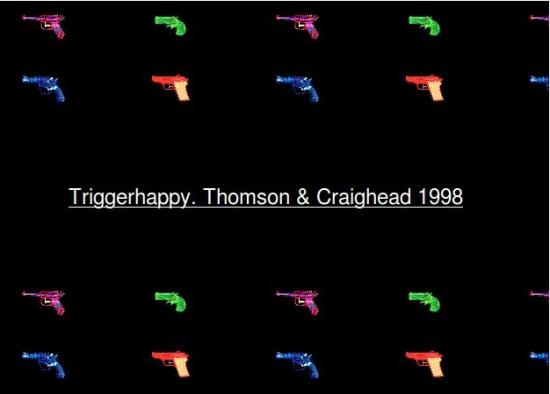
In the British artists Thomson & Craighead version Triggerhapppy the enemy aliens are replaced with quotes taken from the French philosopher Michael Foucault’s essay “What is an author?” “Triggerhappy” is a work that explores the relationship between hyper-text, author and reader. What is a writer, or rather, who is the artist when we are dealing with interactive art in the form of a videogame? Is it Tomohiro Nishikado who created the original game or is it Thomson & Craighead that have modified the game or the player that are playing the game or maybe the computer that creates and interprets the text (the code) that make the game appear on the screen?

After the 11th of September the world suddenly saw a new major enemy, international terrorism. In a modernized version of “Space Invaders”, the artist Douglas Edric Stanely located the scenario in the game to the Twin Towers in New York, which was destroyed during the terrorist attack on 11th September 2001. In Stanley’s version titled the invaders, you have to fight against the hostile aliens before they completely destroy the two towers. The classic struggle between good and evil continues, the game concept is the same as in the original but the scenario and the metaphoric meaning of the aliens has changed.
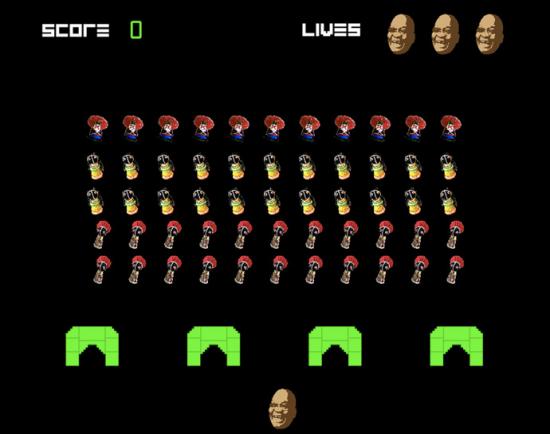
The struggle between good and evil can also be found in other areas of our society, for example in class and gender struggle. In the South African photojournalist Nadine Hutton’s version Skirt-Invaders the main character in the game is Jacob Zuma, South African president since 2009. Zuma has been quite controversial because he is a polygamist and has expressed his doubt about the dangers of AIDS. In the game Zuma you have to shoot down a never-ending stream of virgins from the Zulu tribe. Will the president succeed to shoot down any threatening scandals before they land on the ground? Hutton’s work is an example how a well-known videogame can be used for political purposes and be both entertaining and still very critically at the same time.
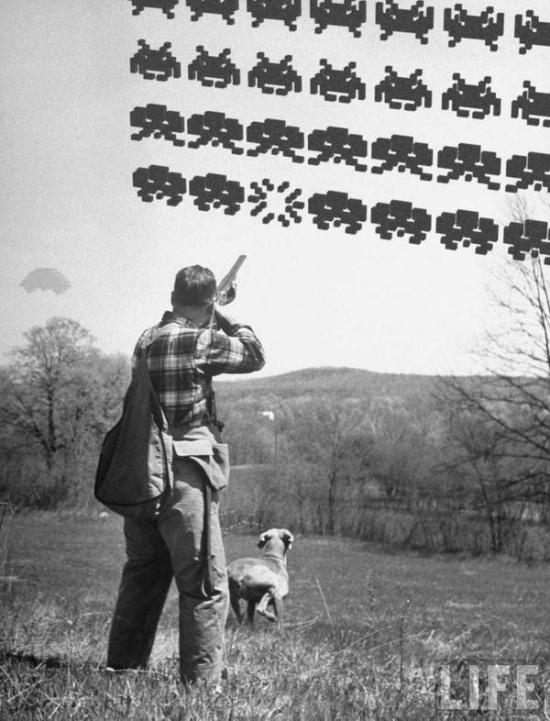
The term mash-up, which is frequently used today, could be described as a form of digital collage. Ryan Sneider has created mash-ups by combining images from various sources, in this case photographs from Life magazine’s archives and videogames. The photomontage Duck Hunt / Space Invader shows a bird hunter with a dog, but it is not birds the hunter aims for, instead it is the famous monsters from the “Space Invaders”. Those who played videogames in the 70 – and 80’s will probably remember the game “Duck Hunt”, where you could shoot ducks that flew up out of the reeds and your faithful dog then ran to fetch them. Sneider has combined the two game ideas, one composed of a photo of a true hunter with a dog and the second of digital graphics from the videogame “Space Invaders”. The work discusses the boundaries between the real and digital world. What will happen when these two worlds become more integrated and the borders are increasingly blurred?
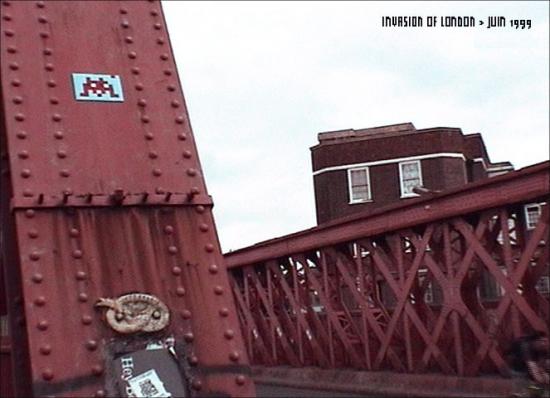

Finally we have to mention the artist, who personifies the game, the French street artist who hides behind the pseudonym Space Invader. His main art project consists of invading various cities around the world and putting up small mosaics of characters from videogames as “Space Invader”. For each successful invasion, he collects points, and the whole art project is described on his website as a reality game. Like other forms of street art “Space Invader” is an ongoing battle about the public space. With help of popular culture Space Invader tries to infiltrate the commercial forces that almost have total monopoly on the imagery that appears in our public spaces. The aliens, in form of small mosaics, become a force that can not be defeated when they are spreading all over the world. A important part of the game “Space Invaders” is that you cannot win, you can certainly come to the high score list, but you can never defeat the aliens, they are instead coming in faster and faster each time they are shot down. It’s obviously a dystopian world view we meet in the videogame, but if we look at it from the artist Space Invaders point of view, it’s rather something positive. The art is a force that will not be stopped. The invasion has just begun and the struggle between good and evil continues…
Videogame appropriation in contemporary art: Pong. Part 1 by Mathias Jansson.
Videogame appropriation in contemporary art: Tetris. Part 2 by Mathias Jansson.
The legend says it was when the Japanese game developer Toru Iwatani took a slice of his pizza that the yellow game character Pac-Man appeared before him. In Pac-Man, we find a restless character hunting around in life’s mazes constantly seeking for pills to satisfy his insatiable desire. Meanwhile the ghosts of anxiety are tracking him down. What many players don’t realize are that the game also contains an unanswered philosophical-existential question. Where is actually Pac-Man for the short period of time when he escapes into the left or right end of the maze and after a short time pop up on the other side of the maze?
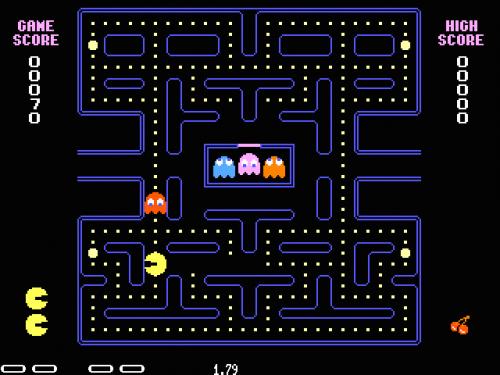
In Martina Kellner’s work “Pac-Man Time Out”, which was showed at the exhibition A MAZE in Berlin 2009, Kellner had created short video clips that investigated what Pac-Man actually did in the short time he was away from the monitor. In one clip, we find him at the airport queue with Ms. Pac-Man ready to board. Perhaps they are planning to take a holiday away from the busy videogame environment? One thing is for sure, Pac-Man does no appear in contemporary art as much as his colleagues from other classic games as Space Invader, Pong and Super Mario.
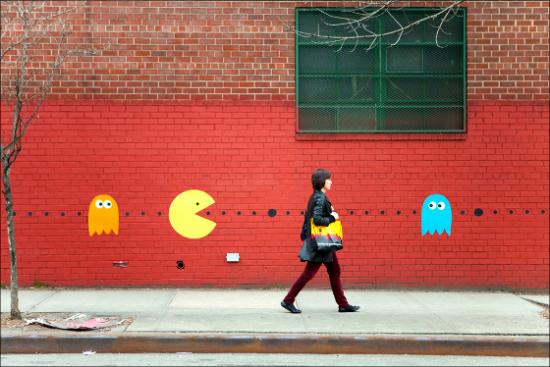
Like many 8-bit characters Pac-Man is well represented in street art and design. For example the American street artist Katie Sokoler staged a real Pac-Man game in her quarters. But it is quite unusual with installations, machinima or Art Games in which Pac-Man has the lead role. This is a bit odd considering how famous Pac-Man is among the general public. The French artist François Escuillie has even created a paleontological reconstruction of Pac-Man’s skull and the Swedish artist Johan Lofgren has in his new colour series “Confessions of a Color-Eater” taken with the colour “Ms. Pac -Man-yellow “, but despite this there are few interactive artworks based on Pac-Man.
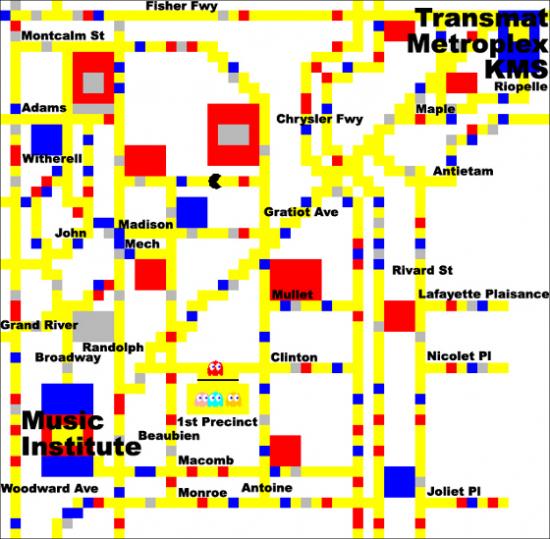
Two exceptions are in any case worth highlighting: the “Pac-Mondrian” and “Eggregore”. “Pac-Mondrian” was created in its first version in 2002 by the Canadian artist group, Price Budgets Boys and is described as a mix of Piet Mondrian, Pac-Man and Boggie Woggie music. The board consists of Piet Mondrian’s painting “Broadway Boogie Woogie” (1942-43), which in its turn is inspired by Manhattan’s street grid and boogie woogie music. The videogame works with the same principle as a normal Pac-Man game except that the maze is a painting by Piet Mondrian. Price Budget Boys have also created three sequels: “Detroit Techno” (2005), “Tokyo Techno” (2006) and “Toronto Techno” (2006). The labyrinths in the new versions are created by stylized street grid from each city, executed in the style of Piet Mondrian. And in the name of equality, you play as Ms.Pac-Man in these versions. For those who have followed previous articles in this series, will recognize that there is a similarity between “Pac-Mondrian” and the Danish artist Andre Vistis works “PONGdrian v1.0”, in which Vistis combined the videogame PONG with Mondrian’s paintings.
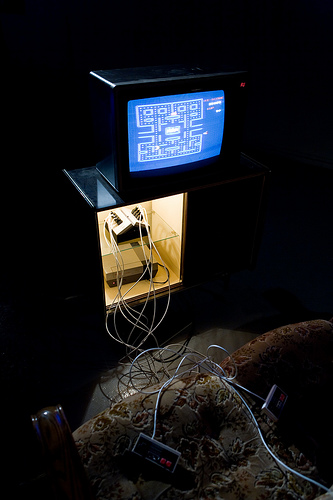
Antonin Fourneau & Manuel Braun’s work “Eggregore” is a social video game in which eight players, each with its own control will try to collaborate and steer Pac-Man through the maze. It may sound like an old teamwork workshop with a twist. Eight wills and strategies must collaborate to succeed with the mission. “Eggregore” is a Greek word which is associated with occultism and means a collective mind. The question that Fourneau and Braun is asking is: Can multiple individual game strategies together create a stronger and better collective player or will it just be chaos when the different games strategies are pulling in different directions? In the video game world, there are many examples of online worlds like World of Warcraft, where player successfully work together in clans or guilds in order to achieve higher goals in the game. It has even become an asset in your CV to show that you have played World of Warcraft and that you can lead and work together with other players to achieve different goals. Pac-Man, however, seems to be a rather greedy individualist who only thinks of himself in the video game world. And perhaps it is this self-absorption with himself taht prevents the game from breaking through as a major theme in contemporary Game Art?
Pac-Mondrian:
http://www.pbfb.ca/pac-mondrian/
Eggregore:
http://liftconference.com/eggregor8
Videogame appropriation in contemporary art: Pong. Part 1 by Mathias Jansson.
Videogame appropriation in contemporary art: Tetris. Part 2 by Mathias Jansson.
Videogame appropriation in contemporary art: Space Invaders. Part 3 by Mathias Jansson
Form+Code In Design, Art and Architecture
Casey Reas, Chandler McWilliams, LUST
2010, Princeton Architectural Press
ISBN 9781568989372
Form+Code is an art computing programming primer. Rather than teaching any particular programming language it explains the technical and conceptual history of programming and its use in art. Starting with an introduction to the basic concepts of coding, instructions, form, and different ways of representing them (in sections titled “What Is Code?” and “Form And Computers”), it moves on to chapters covering “Repeat”, “Transform”, “Paramaterize”, “Visualize” and “Simulate”.
The basic concepts of programming are explained clearly with plenty of examples of code, hardware, and output. They are also related to broader art history, with examples drawn from conceptual artists such as Yoko Ono and Sol leWitt. And it’s good to see Jasia Reichardt’s pioneering work in bringing art and code together is recognised not just in the form of the Cybernetic Serendipity show at the ICA in London but her books and articles on art computing as well.
There is a little code, enough to give a flavour of what it looks like but not enough to intimidate. Listings in or examples of output from BASIC, LOGO, BEFLIX, Hypertalk and other important historical programming languages are presented. PostScript is given its due, with listings, examples of output and a discussion of its incredible impact on the graphic design industry.
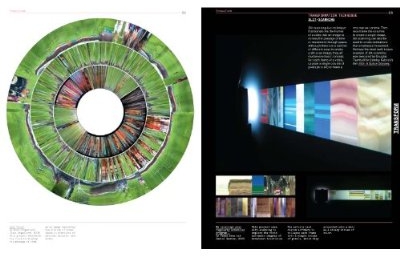
Form+Code is about hardware as well as software. The Difference Engine, ENIAC, oscillioscpes, the PDP-1, arcade games machines that used vector graphics, and the Atari 2600 are all included in a historical narrative of computing and art. The book also describes and shows examples of output from printing hardware from pen plotters through laser printers to CNC and stereo lithography machines, providing a historical and conceptual grounding for thinking about the most advanced output devices currently available.
“Repeat” is explained starting with the Jacquard Loom, and the art of Bridget Riley and Andy Warhol before moving on to variations on a simple BASIC program with illustrations of its output. Packing this amount of historical, computer science and artistic information into each chapter would be overwhelming were it not for the book’s clear writing, structure and design.
“Transform” touches on Holbein’s “Ambassadors” and Victor Vasarely’s Op Art as well as the basic mathematics of folding a piece of paper. “Parameterize” has Dada, Duchamp, the Beats and Calder’s mobiles. It mentions grids without mentioning Rosalind Krauss (the book as a whole is pretty much Theory free), and explains how you use variables to produce variants on the same form.
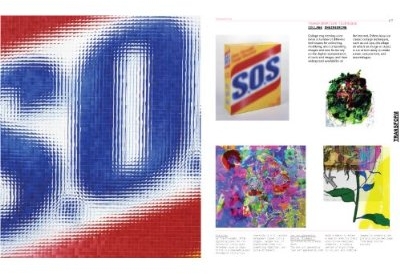
“Visualise” and “Simulate” are almost devoid of (non-computer) art historical examples and cultural context. Harold Cohen’s AARON is illustrated, and Douglas Hofstadter, Richard Dawkins and Stephen Wolfram’s ideas are mentioned. More people should know about the wokr of Hofstadter’s FARG, and the concepts, work and writing presented are still a treasure trove of information and inspiration. But these chapters lack the art historical context of their predecessors.
The contemporary visual art computing presented is mostly in the generative art / data visualisation mold. It’s highly structured, would mostly be impossible to produce without computers, and is haunted by the possibility of being merely decorative. The only academically recognisable critical art included is one of JODI’s less threatening browser pieces. But the example of worldmapper.org in the chapter on visualisation shows how the aesthetic tools of data visualisation can be used politically. And the formal structures and creative strageties of much of the art has a quality of realism in the age of networks that is a challenge to Theory rather than a falure to illustrate it.
The success of books intended to provide a comprehensive foundation in an area of the study of art, such as “Art In Theory” or “Basic Design”, have both helped to enrich the study of art and had the unintended consequence of closing off other possible narratives. Form+Code stands to be as successful in its own area as those books were in theirs, with the same benefits and dangers. Form+Code’s ommission of virtual reality, livecoding, and other movements within art computing are understandable given its focus, but hopefully won’t lead to their neglect by students.
Could you code up any of the software art that you see in the book after reading it? No. The only code listings are historical fragments. But after reading the book you will undestand the concepts that you need both to figure out what more you need to learn in order to program such art and to understand why doing so is aesthetically and art historically worthwhile. And some source code from the book, in various programming languages, is available online.
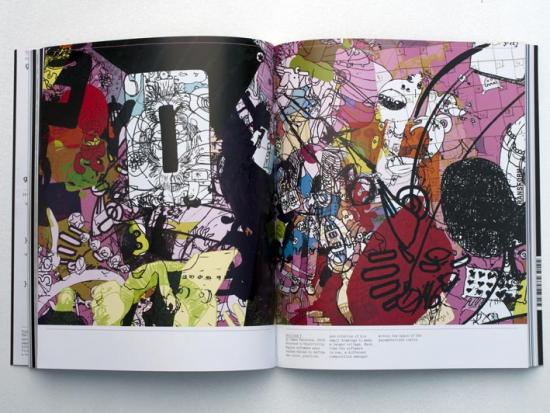
Form+Code’s major achievement is that it presents technical, art historical and technical historical information in such a way that it complements each other and builds a bigger picture that demonstrates the wider relevance and further potential of art computing programming. Having read it, you’ll know more and you’ll both want to and be able to learn how to do more. It’s clearly laid out, packed full of illustrations, occasional code fragments, plenty of references to sources for further investigation, and even has a good index. It really is a foundation course in a book, providing a sound basis for further learning or research.
If you teach art computing, and if you are teaching art, graphic design, textiles, fashion or architecture then you are teaching art computing to a greater or lesser degree, then Form+Code is a perfect primer for the conceptual, historical, and cultural side of computing and art computing. Outside of education, if you are involved in art, computing, or are a non-programmer computer-using artist Form+Code provides a good grounding in the concepts used in programming for art computing.
Form+Code serves as a complete introduction to the conventional history, concepts and practice of visual art computing. It presents that information in the context of the broader history of art and design. And it provides enou